/IMPACT
A Members' Exhibition in collaboration with the Fitchburg Art Museum
ArtsWorcester Main Galleries
February 25 - April 8, 2023
For the eleventh annual Call and Response exhibition, ArtsWorcester and the Fitchburg Art Museum invited artist members to bring one artwork that explores any way humanity and nature impact one another.
The natural world has always inspired artists with its beauty, power, and the raw materials it offers for art-making. Today, in the face of our climate crisis, many artists bear witness to and represent environmental changes in their work–even as others draw from the beautiful ways humans have shaped and utilized the earth.
Artist members were asked to consider humanity’s complex relationship with our environment, along with one (or more) of ten artworks on loan from the Fitchburg Art Museum. These ten artworks explore a range of impacts on the natural world in their themes, subject matter, and materials. View the loan below.
The Fitchburg Art Museum’s curatorial staff selected ten works from Impact by ArtsWorcester artist members to be exhibited at FAM with the loaned works.
/EXPLORE THE CALL
/EXHIBITED WORKS
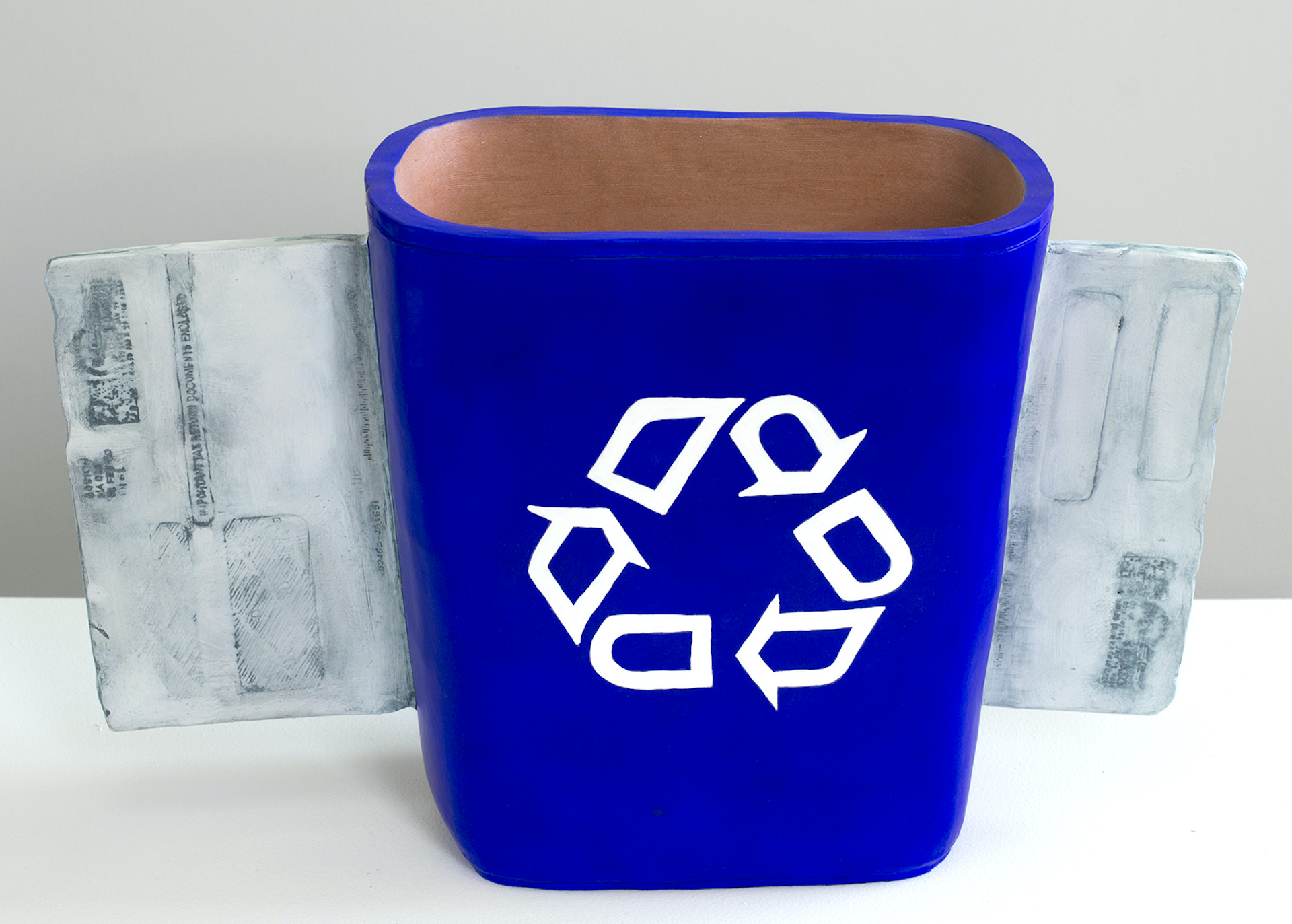
Robert Arnold
Winged Pot (Mail Bin)
Inspired by: John Willis, Recycled Realities 1
acrylic paint and wax on hand built terra cotta vessel
12″ x 19″ x 8″
2020
Winged Pot (Mail Bin) is part of a recent series of painted and flocked sculptures focusing on familiar household items such as waste bins, grocery lists, CVS coupons, and piles of clothing. Removed from their usual place on the floor, a shelf or forgotten under a dresser, I give them a life of their own. Additionally, by reframing these industrially fabricated, functional items as handmade objects in terra cotta, I ask the viewer to reconsider them for their sculptural, aesthetic and narrative capabilities. I am drawn to John Willis’ photograph Recycled Realities #1 for the tactile nature of the bound newspapers and how our waste and recycling habits shed light on what we value as a society. Made in terra cotta, which is endlessly recyclable, Winged Pot (Mail Bin) is both decorative and functional, and is flanked by envelopes from the IRS, a nod to the never-ending paper trail.
@taylorapostol
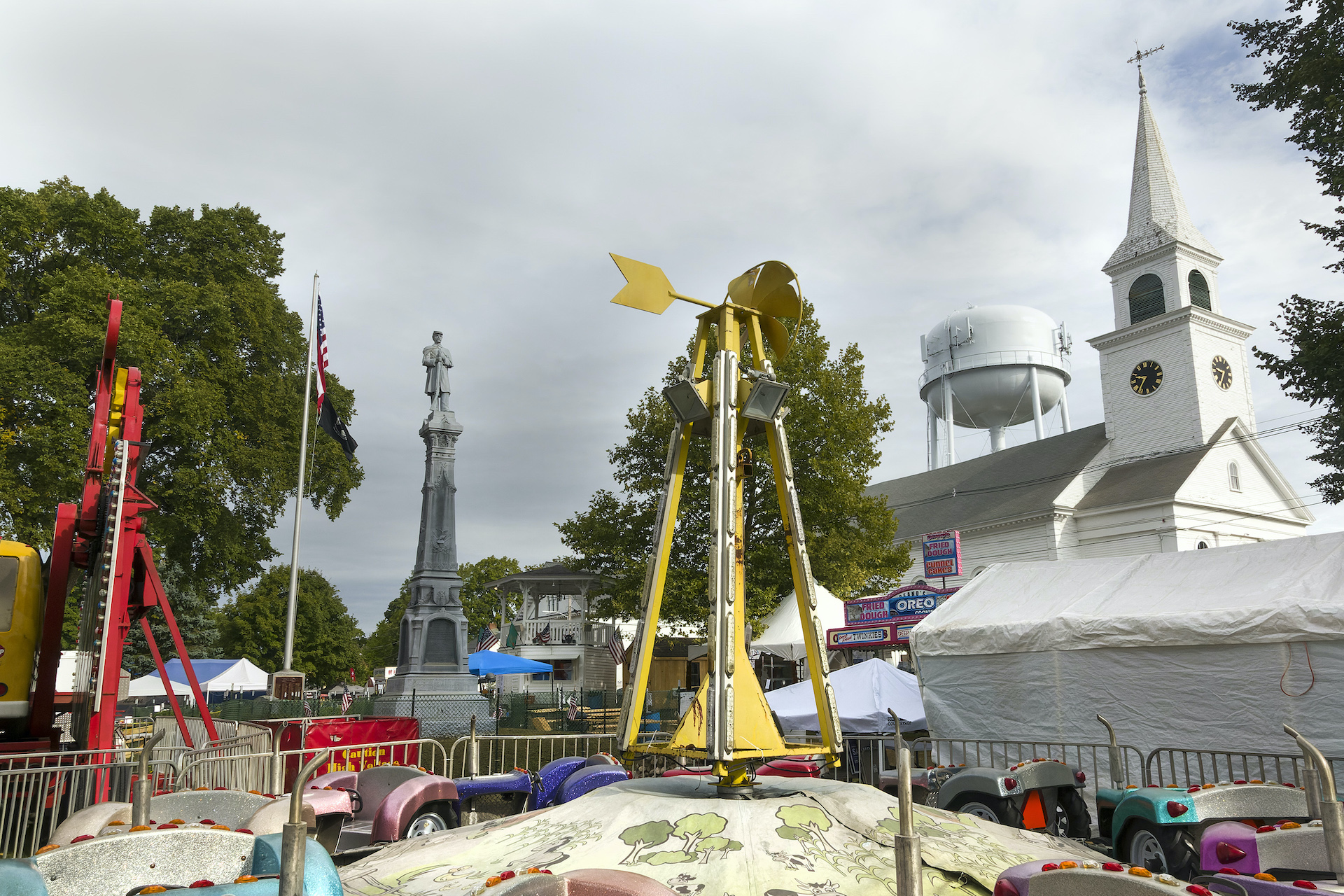
Robert Arnold
Skyline – Belchertown Fair
Inspired by: Laura McPhee, The Blue Lagoon
digital photography archival print
10″ x 15″
2022
A found image reflective of situations where, for the sake of our own comfort or entertainment, the “Hand of Man,” with its symbols of our society, competes with, at time dominates, and even obscures the natural environment.
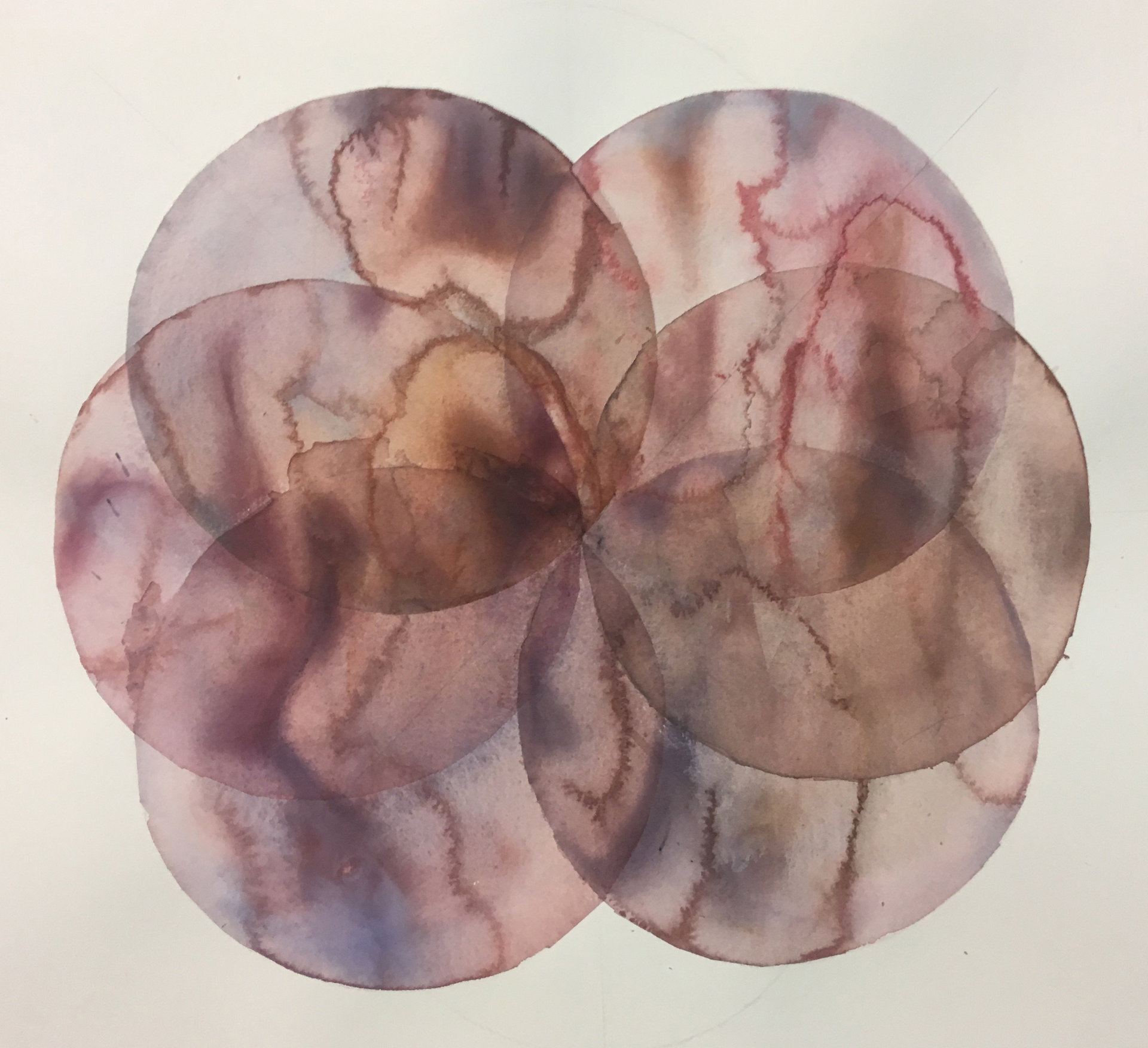
Clare Asch
Convergence 17
Inspired by: Harvey Sadow, Fire and Flood/Sacred Sites Esther Solondz, Untitled (Rust Portrait)
watercolor on Arches paper
22″ x 22″
2020
In this painting, the dark, smoky reds refer to fire and the fluidity of the paint to water. I work wet on wet using colors that are complex mixes which spread and dry on the wet surface of the paper at different rates, creating subtle and complex lines that refer to natural processes.
@aschclare
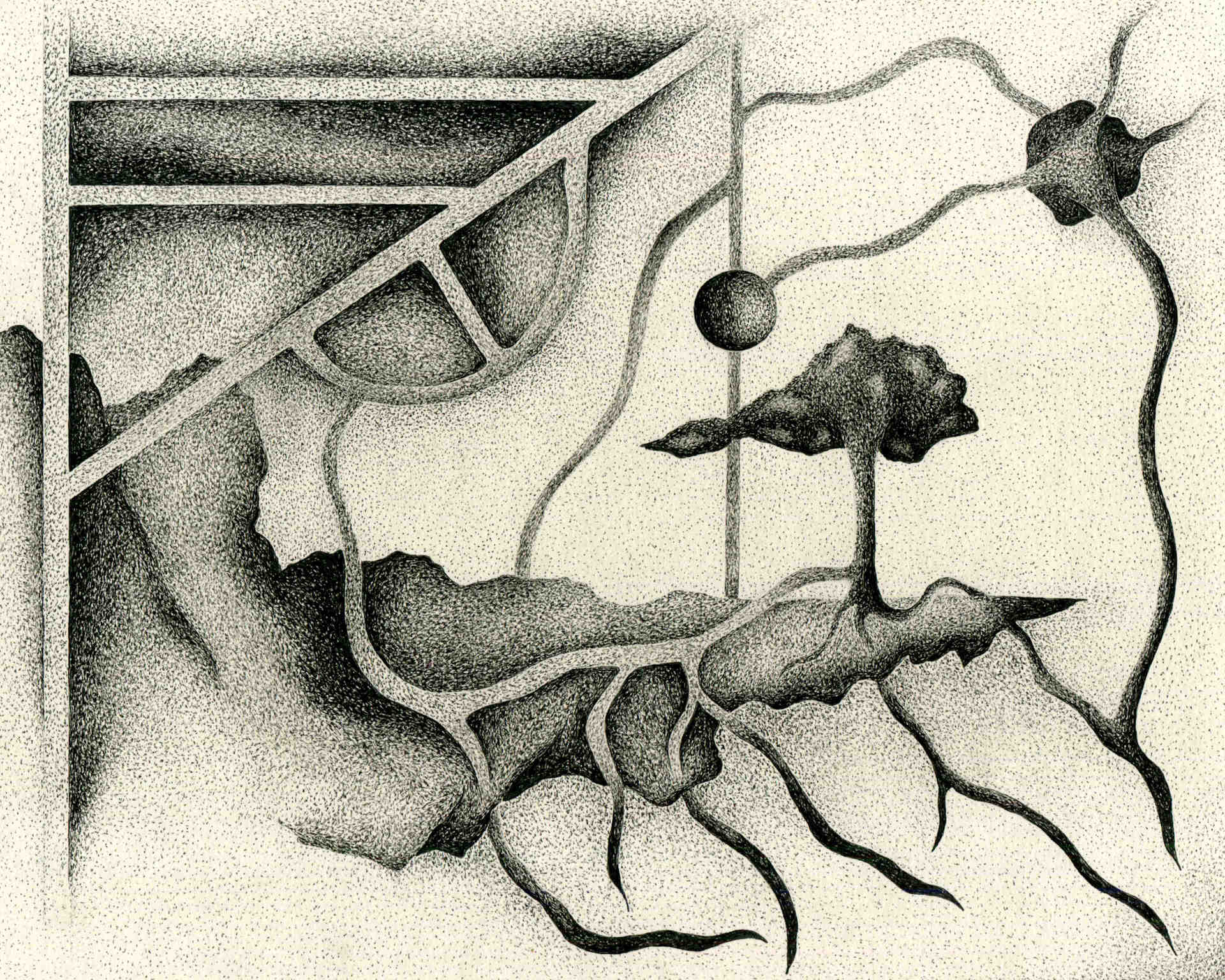
Doug Ashby
Untitled Conceptual (Rooted Intersections)
Inspired by: Robert Adams, Bulldozed Slash Laura McPhee, The Blue Lagoon Lionel Reinford, Winter in New England
pen and ink
8″ x 10″
2023
Dots. I use many of them. Sometimes I imagine my work can come close to placing upwards of 10,000 dots on a single sheet of paper. I find this laborious process to be of great mental and spiritual worth. Expressing value and tonality in this manner is at the heart of my craft and the backbone of the imagery I am conjuring. Throughout the process, I am continuously pushing the limits on gradients of shading. Once the heavy lifting of discovering my specific intention for an artwork is complete, what is left is a meditative process that I have discovered I personally can not live without.
@dashbyart

Joan Avato
Cyanotype Botanical Prints
Inspired by: Robert Adams, Bulldozed Slash Winslow Homer, Gathering Berries Esther Solondz, Untitled (Rust Portrait)
cyanotype print
21″ x 11″
2021
Three of the works inspired my piece: Bulldozed Slash, Tillamook County, Oregon, Gathering Berries, and Untitled (Rust Portrait). • A photographic print process employing natural elements (iron compounds, water and energy from the sun) was utilized to create cyanotype botanical prints. • It is known that native plants in the landscape have many benefits and can combat climate change in a number of ways. Our relationship with our environment is evident as native plant garden designs are currently becoming more popular. Plants can also adapt to their environment in complex ways that allow them to tolerate adverse conditions and ultimately survive. • Solar energy may be used in many ways including the creation of art.
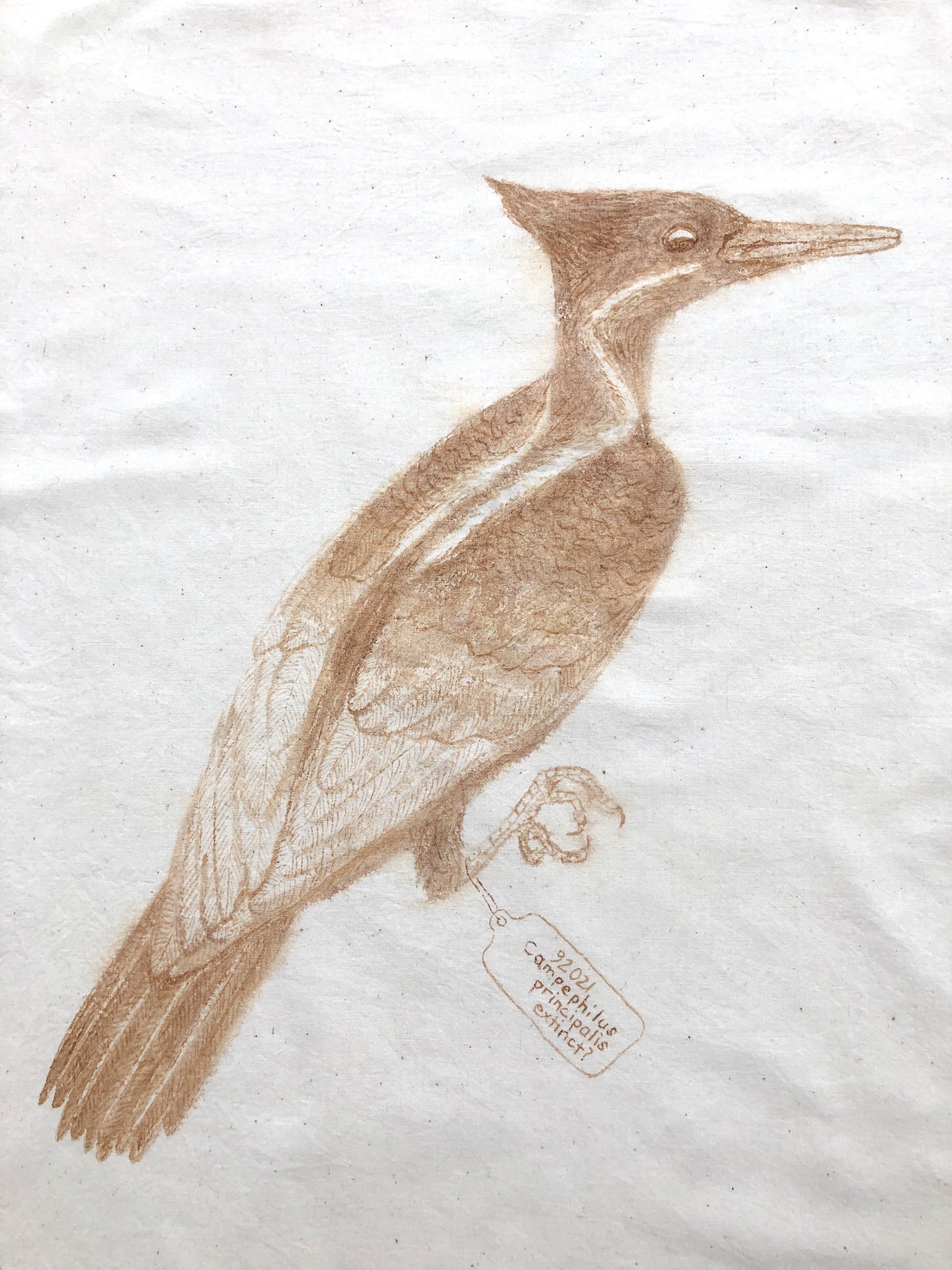
Ann Barrett Hicks
Fading, the Ivory-billed Woodpecker
Inspired by: Esther Solondz, Untitled (Rust Portrait)
water filter sediment on fabric
28″ x 17″
2023
In 2021, the U.S. Fish and Wildlife Service removed the Ivory-billed Woodpecker from the endangered species list. The last confirmed sighting of an Ivory-bill in the U.S. was in 1944, but since then there have been many unconfirmed sightings. People don’t want to give up on this species, an icon in the effort to preserve biodiversity. Amid the ensuing controversy, the Fish and Wildlife Service reopened the public comment period on its declaration that the Ivory-billed woodpecker is extinct. Do we cling to the hope that the Ivory-billed woodpecker survives because we know that as species become extinct, a portion of ourselves does too? Biodiversity sustains life. Humans cannot live alone. In the words of E.O. Wilson, “We are a biological species in a biological world, and always will be.” By preserving the natural world, we preserve ourselves and the beauty and wonder that surround us.
annbarrett430

Lisa Barthelson
aii 22, art in isolation, family debris
Inspired by: John Willis, Recycled Realities 1
monoprint with mixed media: printed collage on Rives BFK paper with thread stitching on cradled panel
12″ x 12″ x .75″
2021
‘aii 22, art in isolation, family debris’ reflects the sensibilities of John Willis’s ‘Recycled Realities #1’. As Willis relays his response to recycled materials and the continuing impact of these objects and the recycling process, I look to my memorialized family debris captured on paper, layered as in a land fill, and still objects that linger in our memory and pollute our world. The art in isolation series, uses family debris prints, while adding another layer; the ‘stay at home’ impact of a pandemic on family, art making and the earth’s population as the foreshadowing of a new way of living in an unpredictable and unprepared for future for all.
@lisa_barthelson
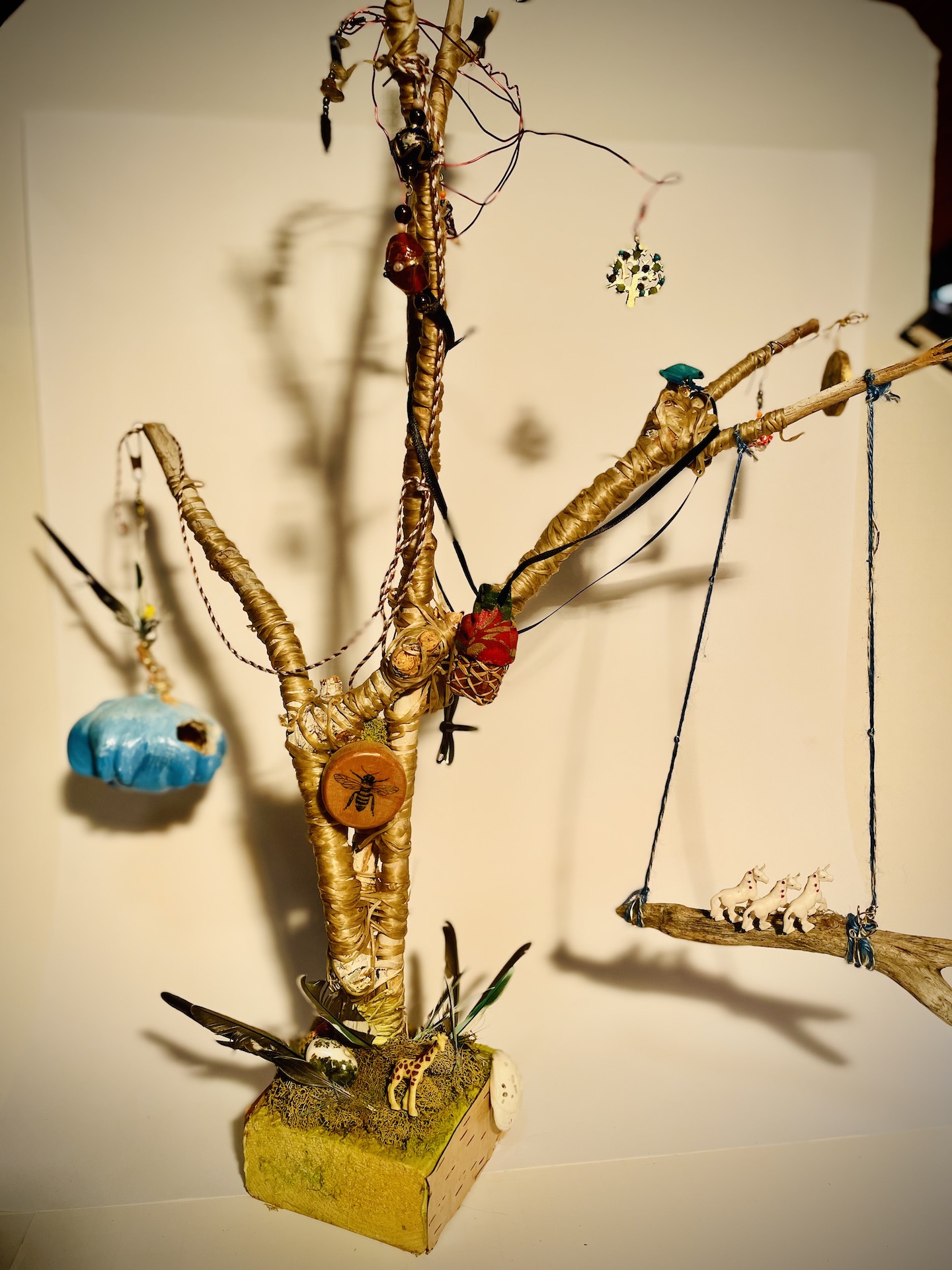
Kerry Bartron
Ark
Inspired by: Robert Adams, Bulldozed Slash
mixed
16″ x 16″ x 22″
ongoing since 2020
Robert Adams words struck me about his photograph-despite widespread damage to a wilderness system, regrowth is possible -“to face facts but to find a basis for hope.”
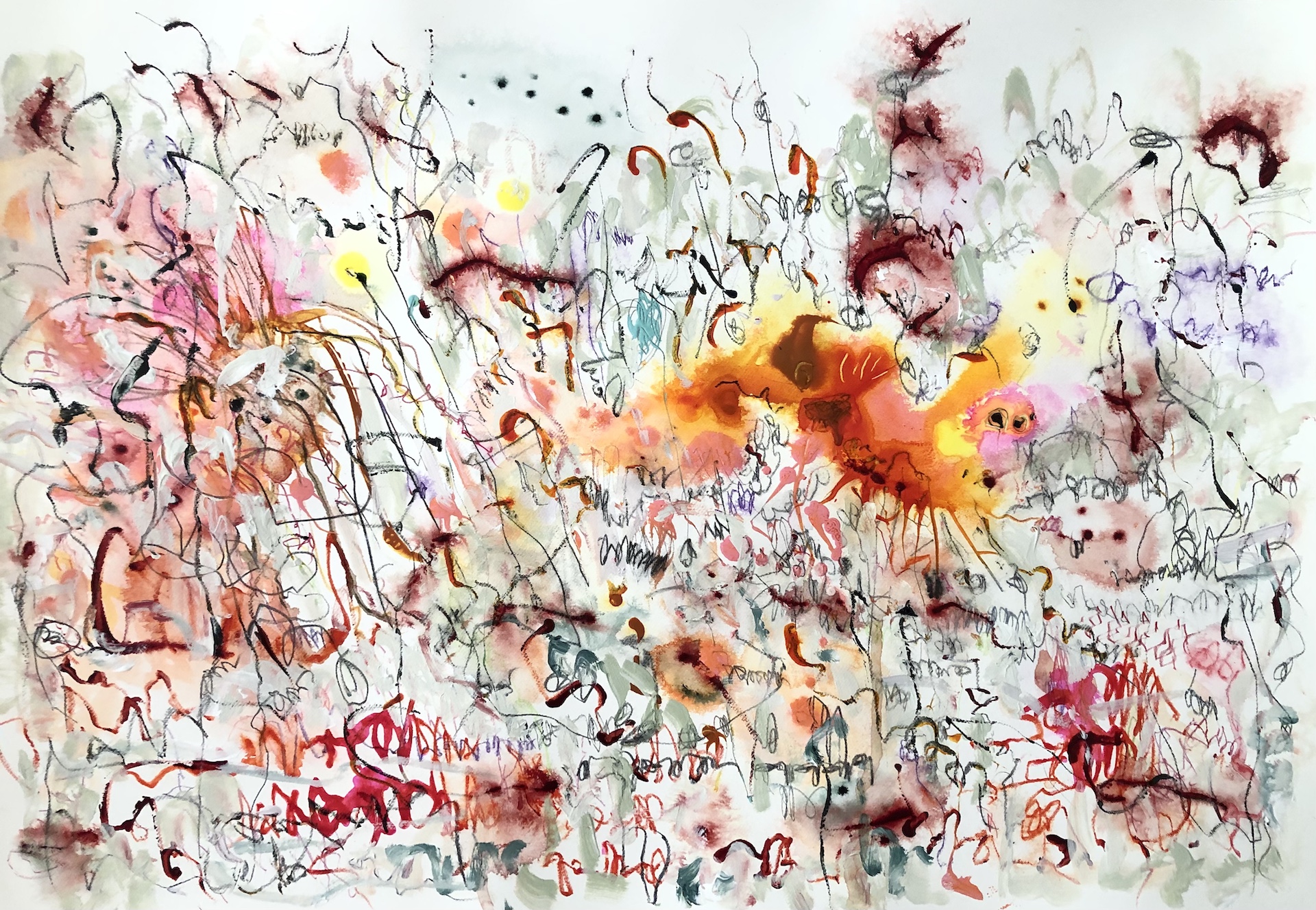
Anne Beinecke
This Bleeding Earth
Inspired by: Robert Adams, Bulldozed Slash Harvey Sadow, Fire and Flood/Sacred Sites Evelyn Rydz, Gulf Pile
acrylic, pencil on cruelty-free watercolor paper
14” x 20”
2023
Anne Beinecke’s billowing pulses of color and asemic marks conjure a world that straddles the abstract and representational. Anne is inspired by nature, symbols and dreams, and her work often aims to radiate an atmosphere that evokes a sense of empathy and hope for our shared planet and all her inhabitants.
@anne_beinecke
Eugenie Lewalski Berg
Danse Macabre
Inspired by: Robert Adams, Bulldozed Slash
video
3 min 24 sec
2023
Nine acres of forested farmland were clear-cut on one of the last remaining farms in Shrewsbury- the Bonnie Dell Farm. It was to be developed into luxury retirement housing- 26 units, 52 garages. I did all I could to preserve this tract of land with its brook and pond, rolling hills, and beautiful mature, healthy trees. I was unsuccessful. I shot the footage in 2017 to honor the trees and bear witness to their destruction. I was struck by the familiarity of Robert Adams’ “Bulldozed Slash, Tillamook County, Oregon.” It made me gasp. I quickly learned IMovie and put this together in response.
@elbstudio, www.eugenielewalskiberg.com
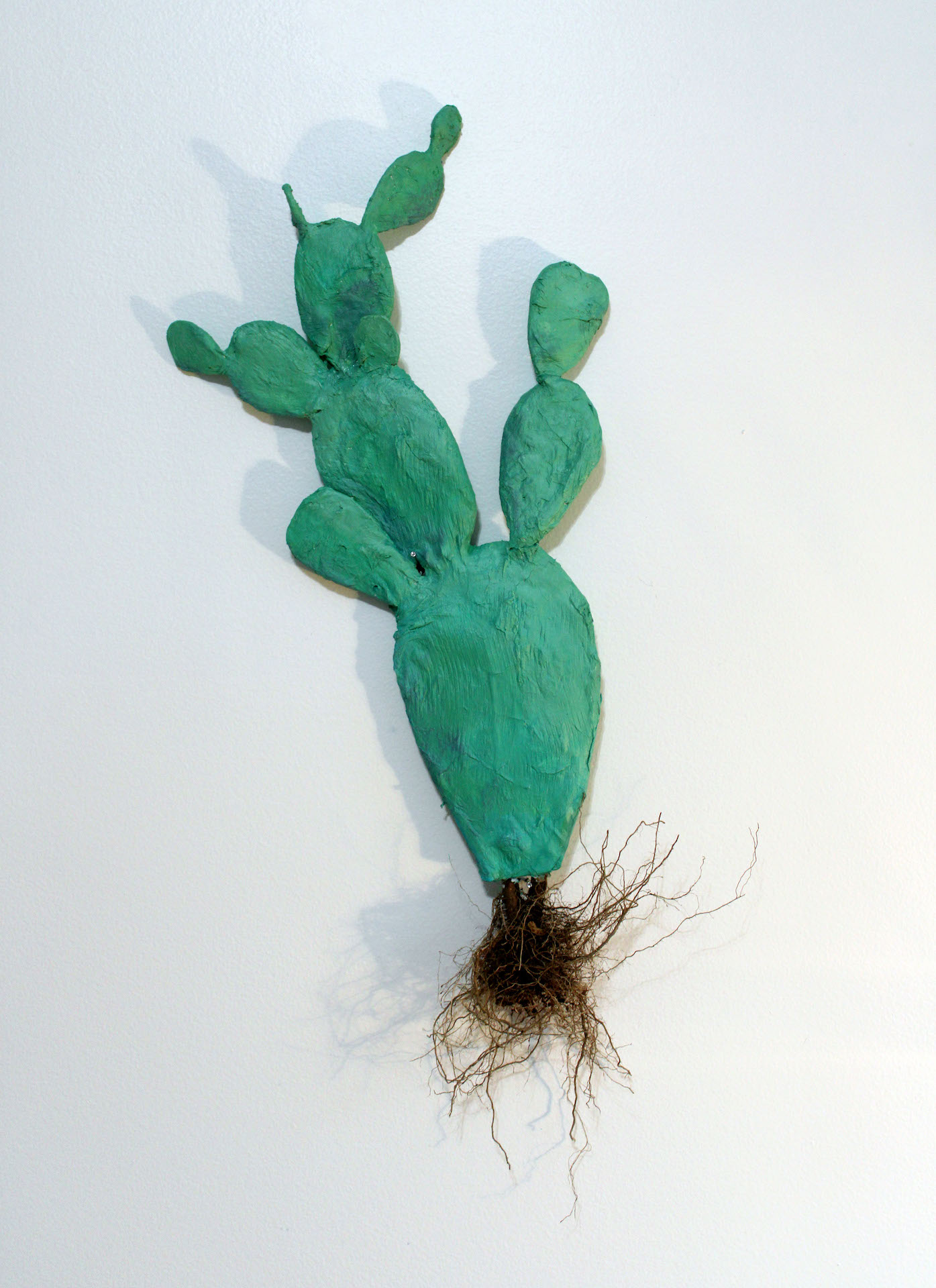
Debra Bianculli
ARGMO Opuntia (analog rendering of genetically modified organism)
Inspired by: Robert Adams, Bulldozed Slash Evelyn Rydz, Gulf Pile John Willis, Recycled Realities 1
waste material, Triticum durum, Tagetes erecta roots, adhesives, acrylic paint
16″ x 29″
2023
This piece is inspired by the idea of plants in the new landscape, as well as waste and paper recycling. The pieces from the FAM collection that gave me the impetus for this work are Bulldozed Slash by Robert Adams, Gulf Pile by Evelyn Rydz, and Recycled Realities 1, by John Willis. The cactus form, a type of Prickly Pear, is a known super-survivor plant and important food source. Its incredible ability to store water and survive intense heat and dryness is an advantage in our climate crisis. The cactus paddles are fused onto tagetes roots. Tagetes Erecta (marigolds) are grown by organic gardeners as companion plants to help to deter pests and thus fortify crops. They also have antifungal, antiviral and antibacterial properties. In several cultures, marigolds have magical and medicinal qualities. This piece is a physical imagining of combining the marigold and opuntia in a hybridized sculptural form.
@debrastudio
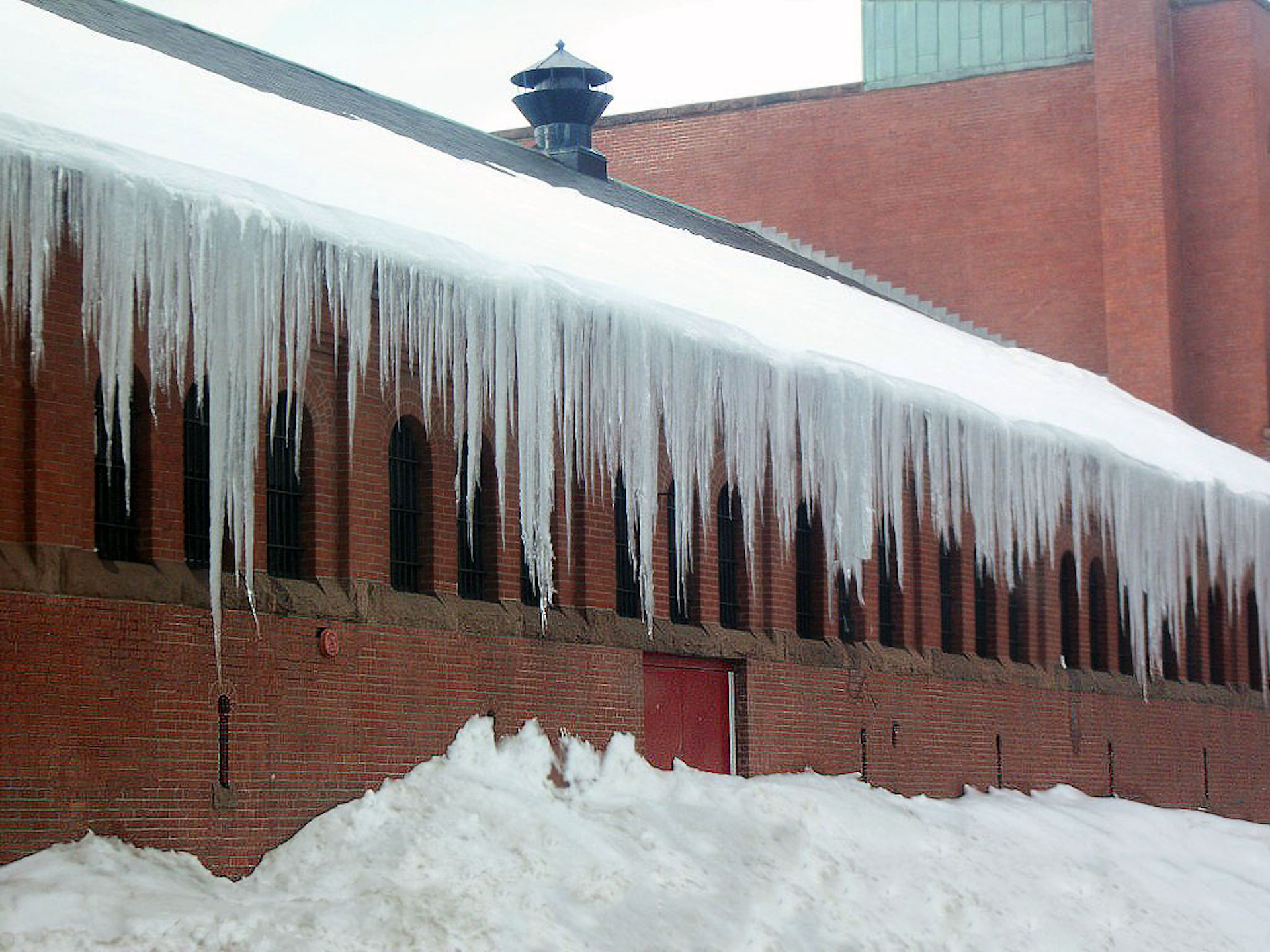
Carol Bloomfield
Icicles Armory Winter 2011 Worcester MA
Inspired by: Lionel Reinford, Winter in New England
photograph
7 1/2″ x 9 1/2″
2022
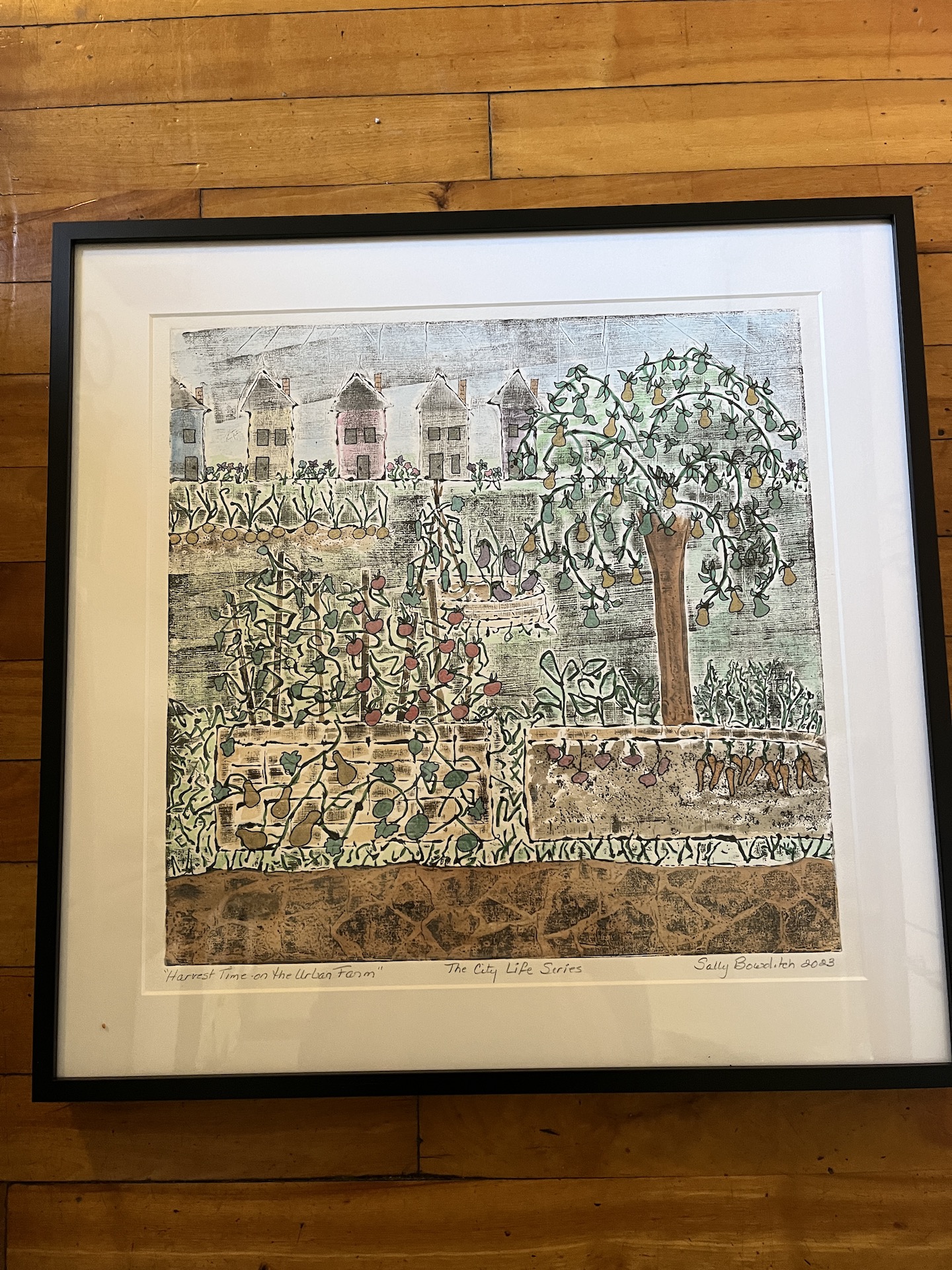
Sarah Ann Bowditch
Harvest Time on the Urban Farm
Inspired by: Robert Adams, Bulldozed Slash Winslow Homer, Gathering Berries
collagraph with watercolor and gel pen
19” x 19”
2023
This piece was inspired by the ongoing transformation of our four inner city yards in to an “urban farm” created by my husband, Larry Marinelli, with a little help from myself and some of our tenants. In that transformation I see elements of the Robert Adams Bulldozed Slash with the “bulldozing” of our lawns and yards to allow for new and healthier growth, and Winslow Homer’s Gathering Berries reminds me of this past year’s very plentiful harvest which included the “gathering” of 520 lbs of pears off of just two trees! So many parts of our lives have been impacted by this farming experiment—how we spend our time, what we read and study, how we cook and eat, how we socialize with our tenants and neighbors, and what we share with our community. It has been a gift. And fun.

Chelsea Bradway
Left Behind
Inspired by: John Willis, Recycled Realities 1
black and white photograph on fine art paper
30″ x 24″
2022
The world continues spinning no matter what events are happening around it. People are left discarded as if they were in fact society’s offloaded waste, as taken by John Willis, homeless people are considered pollution, crowding the sidewalks of the city. His statement about awareness of waste resonated with me, “The more sensitive we are to the volume and degree of waste we create, the more aware we will be in understanding the product of our society.” It holds true not just for newspapers but for humans as well. We as a society need to be more aware of our treatment of each other and find ways to understand how homelessness is affecting our world both physically and emotionally. Humans should consider helping and advocating for others, rather than walking by and pretending not to notice the “waste” we as a society have created.
@ Official.all.things.sparkley

Aaron Brodeur
Night Watcher
Inspired by: John Willis, Recycled Realities 1
wood, concrete, styrofoam, rebar, wire, spray paint
49″ x 25″ x 15″
2023
A significant part of my artistic practice is to source viable material that has been discarded and is awaiting disposal in the landfill, to be used in the creation of my work. Night Watcher gives new purpose to a selection of abandoned materials such as found wood, rebar, and packaging styrofoam, to then be partnered with common utilitarian material such as burlap and concrete. This sculpture observes the rate of consumption and wastefulness of everyday practices that continuously fuel the ravaging nature of industry.
aaronbrodeurart.com
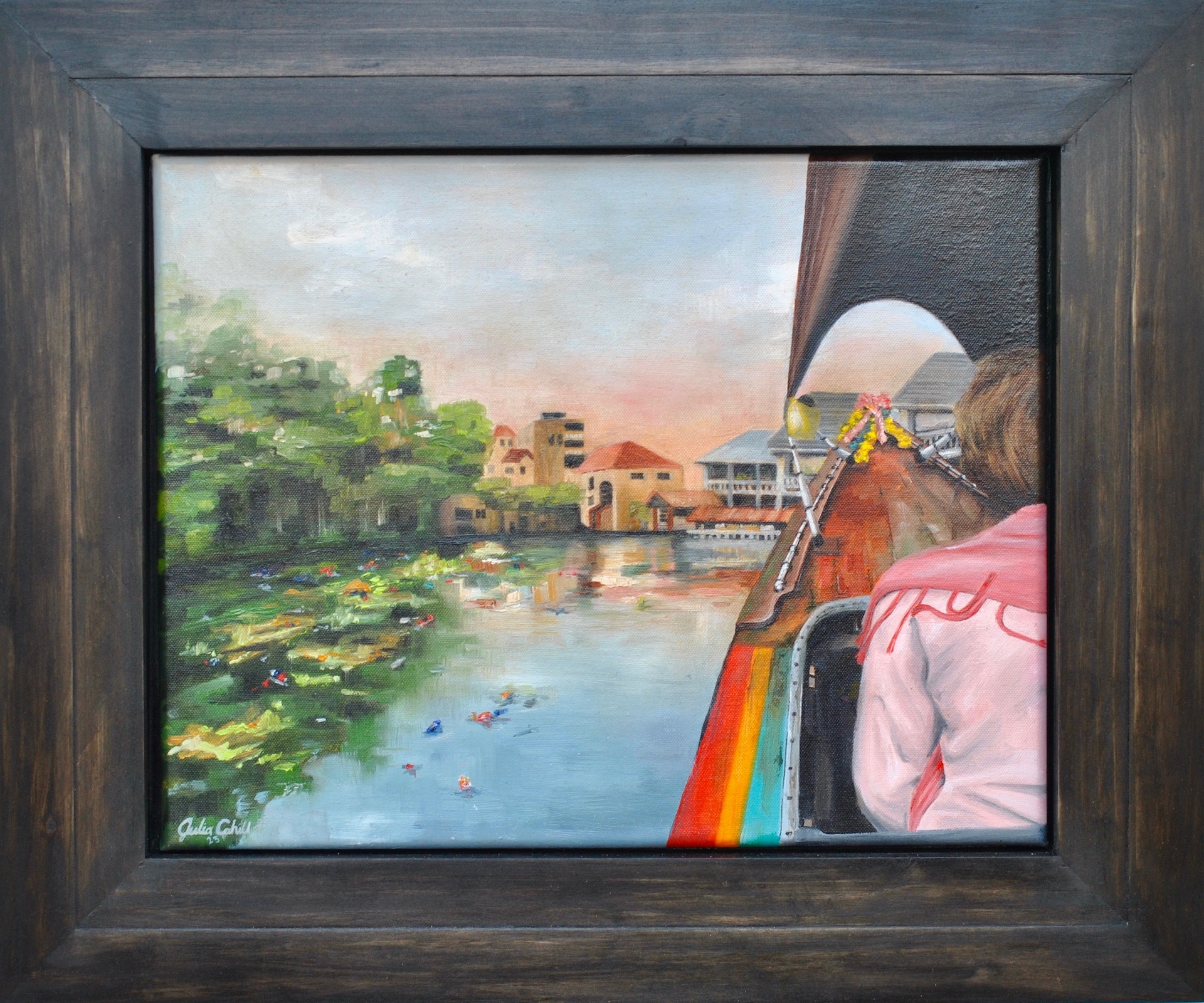
Julia Cahill
Tourist
Inspired by: Laura McPhee, The Blue Lagoon Evelyn Rydz, Gulf Pile
oil on canvas
24″ x 20″ x 1.5″
2023
“Tourist” is a commentary on the relationship between tourism and the environment that it affects, both economically and environmentally. Having spent time studying abroad in Thailand, I saw first hand the positive impact that tourism had on residents’ livelihoods. However, staring brightly was the juxtaposition of pollutants. It was a direct consequence of a bustling fast-paced tourism mindset that puts the environment last. On a boat tour that touted a “close look” at regular local life hoping to see more beautiful landscapes, I could not help but notice piles of trash in the water that stretched beyond the horizon. Subtle, but concerning.
@juliacahillart
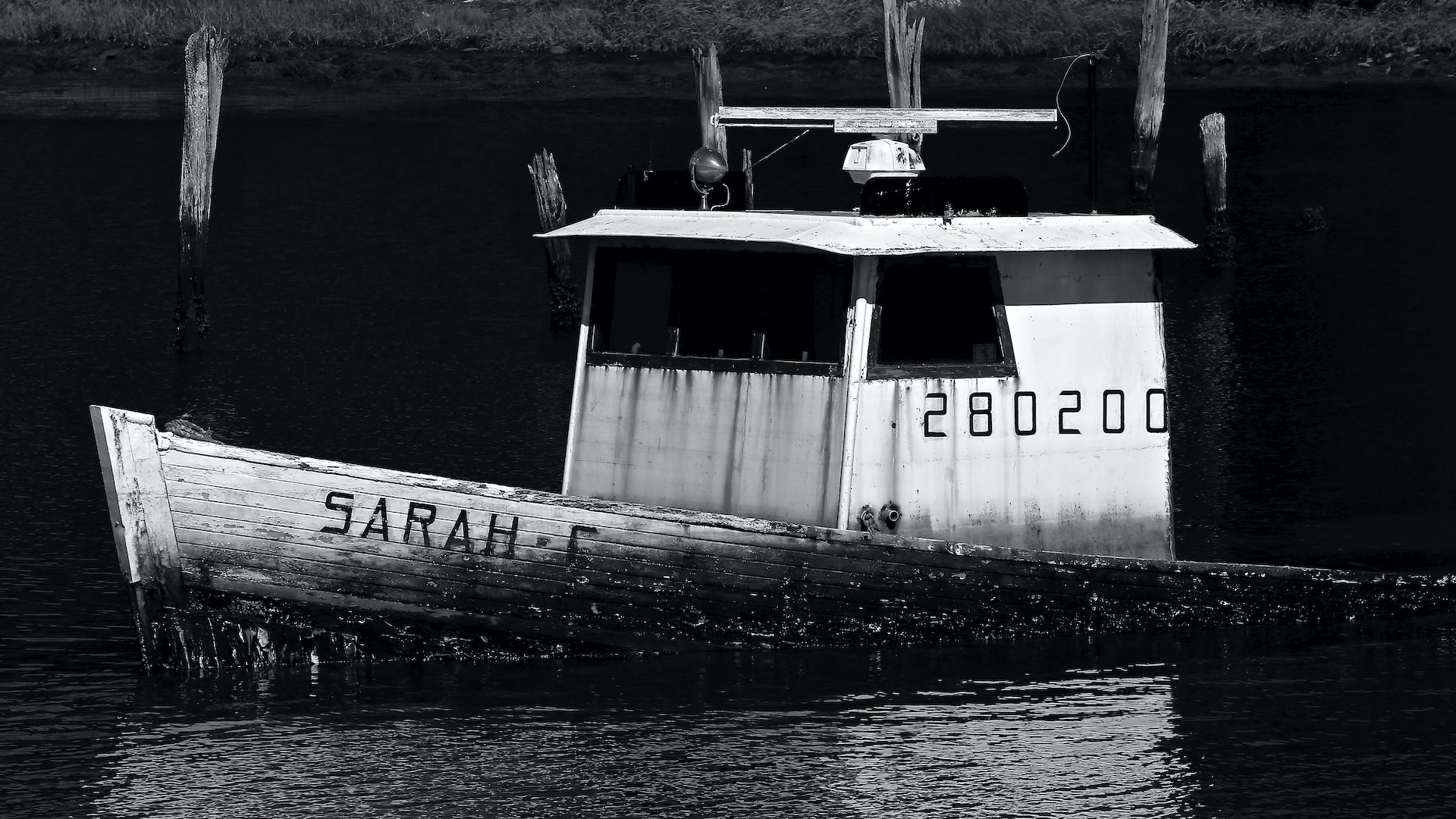
Joseph Cantor
Abandoned
Inspired by: Robert Adams, Bulldozed Slash Laura McPhee, The Blue Lagoon
black and white photograph
13″ x 20″
2021
Viewing the pieces on loan from the FAM, there are two pieces in particular speak to me, “The Blue Lagoon” by Laura McPhee and “Bulldozed Slash” by Robert Adams. In each of these artworks I feel a sense of loss, lack of caring, and a lack of responsibility. I see nature attacked, disowned, and discarded for human progress. In the spirit of these great works, I present “Abandoned”, a black and white photograph of a partially shipwrecked, half-sunken lobster boat, just off the coast of Maine, in a protected harbor. Who knows why the ship sunk, but it was left in place, nobody bothering to remove it or even to complete the sinking, and allow it to become a marine habitat. Now it sits half sunken, for years to come.
https://www.facebook.com/CantorPhotography
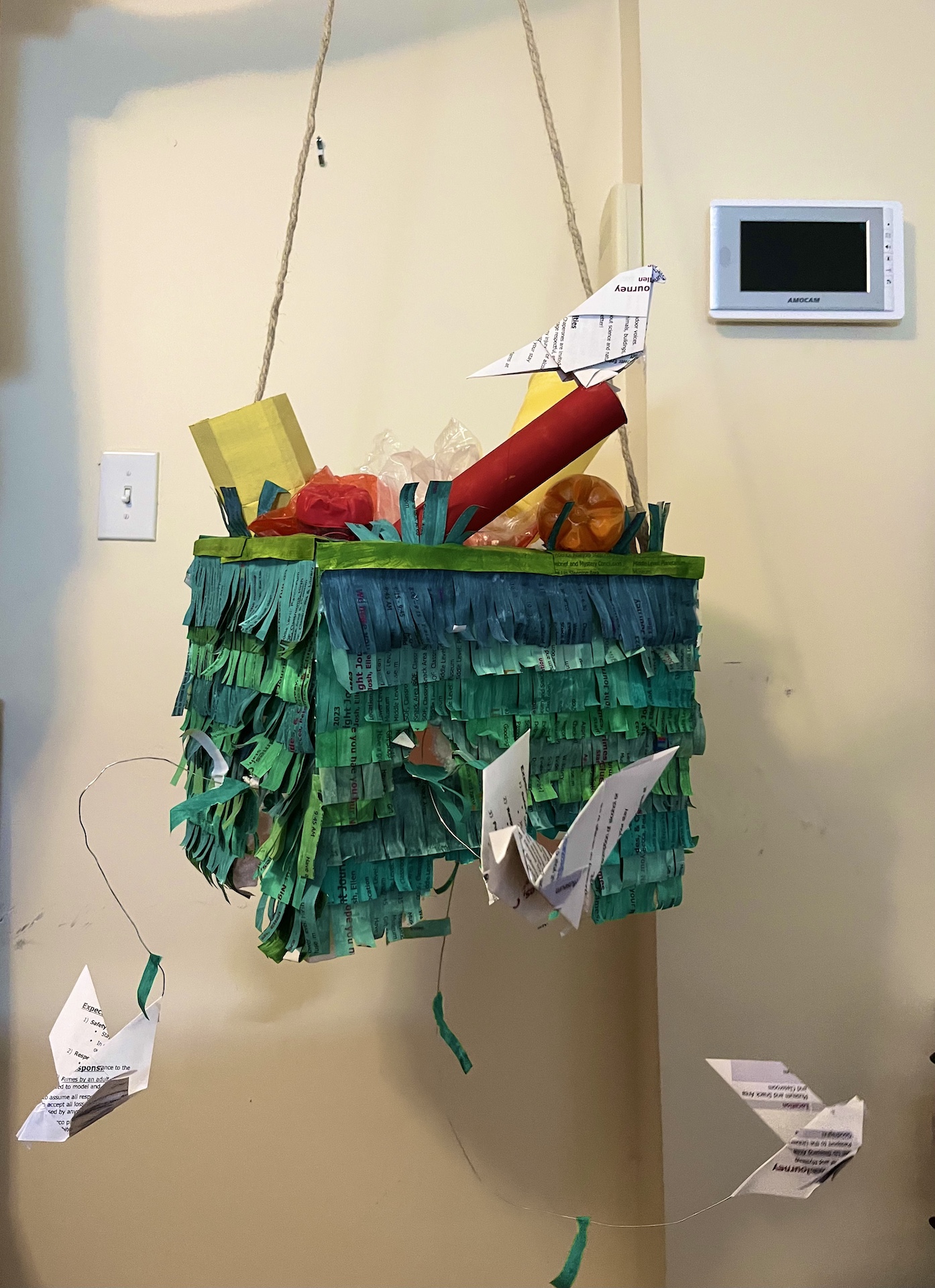
Rebecca Carrillo
Re-Evolution
Inspired by: Evelyn Rydz, Gulf Pile John Willis, Recycled Realities 1
mixed media
23.5’’ x 27’’ x 60’’
2023
Oftentimes I’ve noticed house sparrows jumping alongside and dodging in between trash and recycle bins in my neighborhood. With Gulf Pile by Evelyn Rydz and Recycled Realities 1 by John Willis in mind, I created this piece, made entirely from recycled materials. Incorporating trash from my apartment building and workplace, I found a way to piece together an artistic depiction of a recycling bin. I also used a technique found in piñata making, harkening back to my childhood birthday parties. My parents would buy homemade piñatas from family friends who made them from recycled newspaper and flour-based glue. I hope to evoke feelings of rebirth and change in my piece titled, Re-Evolution.
@rebecca__rebec
Jaina Cipriano
In the Middle of the Night
Inspired by: Esther Solondz, Untitled (Rust Portrait)
photograph on archival paper
20″ x 24″
2017
I construct emotive and enveloping experiences for viewers with my installations and photographs. Through illusionistic set designs – devoid of any digital manipulation – I communicate the complex grief of growing up as a woman in a culture dedicated to stifling authentic emotion and communication. This is especially precarious for those of us who fear abandonment, as it is easy, in our search for love and connection, to get caught in a web of codependency without any means of emotional salvation. I am interested in creating a space where people with similar trauma can feel witnessed by others as the first step to liberation from this cycle of silence, the facade of isolation. My pieces depict cut-off subjects struggling to escape. When they realize no one is coming to save them, they seek the strength to save themselves.
@jainastudio

Christine Croteau
Interference
Inspired by: Laura McPhee, The Blue Lagoon Evelyn Rydz, Gulf Pile Harvey Sadow, Fire and Flood/Sacred Sites
mixed media collage
34” x 24” x 1”
2023
In this piece I am responding to Laura McPhee’s “Blue Lagoon” , Evelyn Rydz Gulf Pile, and Harvey Sadow’s, “Fire and Flood”. In all their pieces I saw both the beauty of nature, specifically the ocean, and the harsh devastating impact humans have had on it. Similarly, In my piece “Interference” I collaged together breathtaking images of the sea and combined them with unsightly debris, including pieces of blue foam and objects I found from human use on the beach; glass, ceramics, and old pipes. My hope was to create a sense of both beauty and dissonance from this assemblage. I have a deep love of the ocean and spend most of my free time swimming. It breaks my heart to see and experience the devastation that is happening to our oceans and through the creation of this piece I was able to express a little of my grief.
Instagram- @croteauchristine
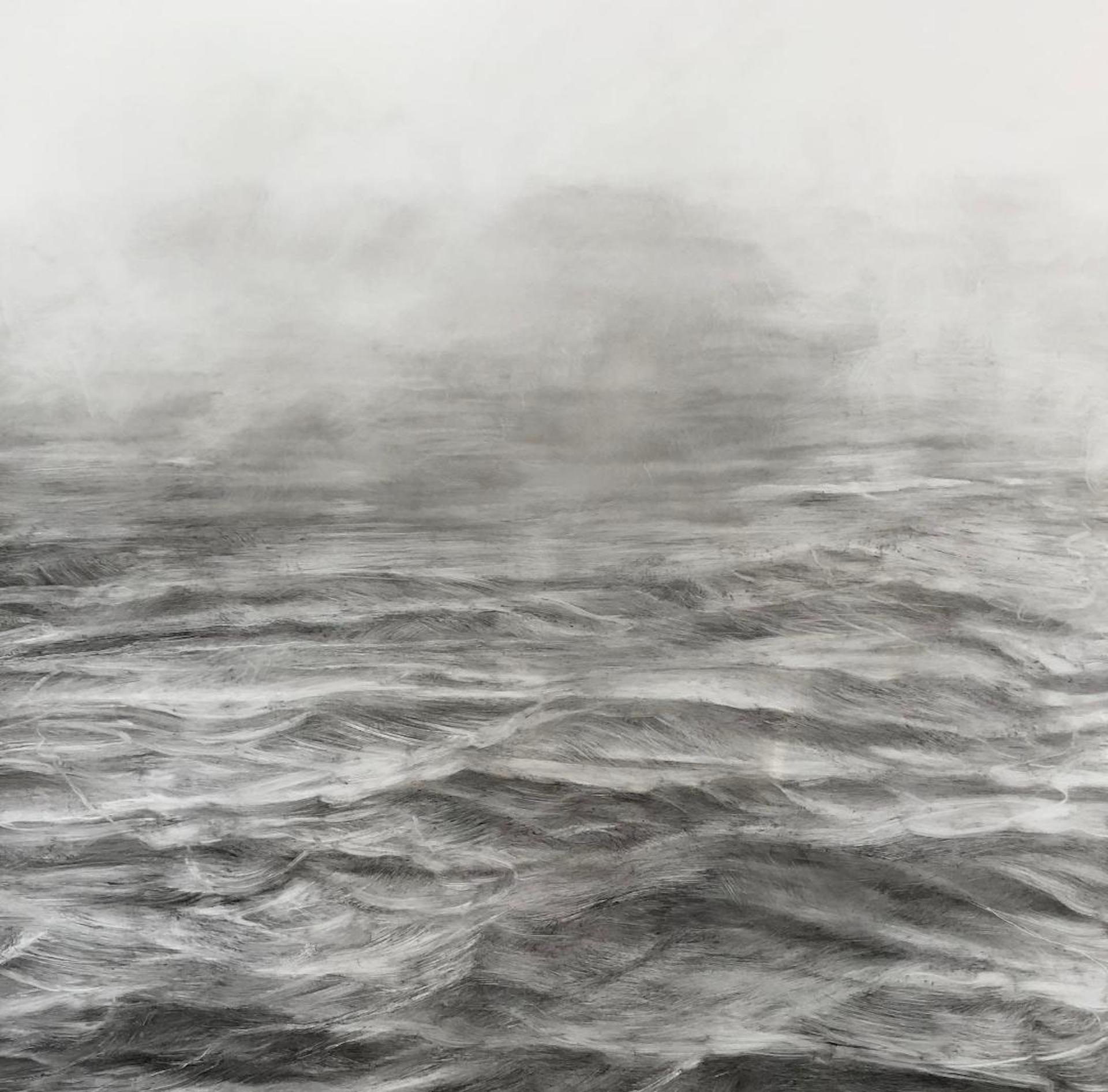
Jennifer Day
Smoke on the Water
Inspired by: Robert Adams, Bulldozed Slash
oil on aluminum
14″ x 14″
2021
I am not out looking for the destruction of nature. This is in me already in the same way Robert Adams comes upon the forest and finds a terrible and perplexing beauty. I explore the relationship between water and air and depict it in the application of black paint on a white surface. In this way, I feel Adams’ sensibility, not being allowed the distraction of color. I can then concentrate on the somber and sad complexity of nature as it is ruffled and disturbed by forces supposedly beyond man’s control. Where does the smoke on the water come from? Has something gone wrong? And if so, who is responsible?
jenniferdayart
Ella Delyanis
The Marsh’s View
Inspired by: Robert Adams, Bulldozed Slash
oil on canvas
20″ x 20″
2021
This is an oil painting of a view of a marsh in Grafton where I live. I was primarily excited by the colors and shapes of the reflections; it occured to me that this could be considered “the marsh’s view” as opposed to my view as the “marsh” itself is a continual witness to the changes in the water. I see an association to the texture in “Bulldozed Slash” by photographer Robert Adams to the textures in my painting.
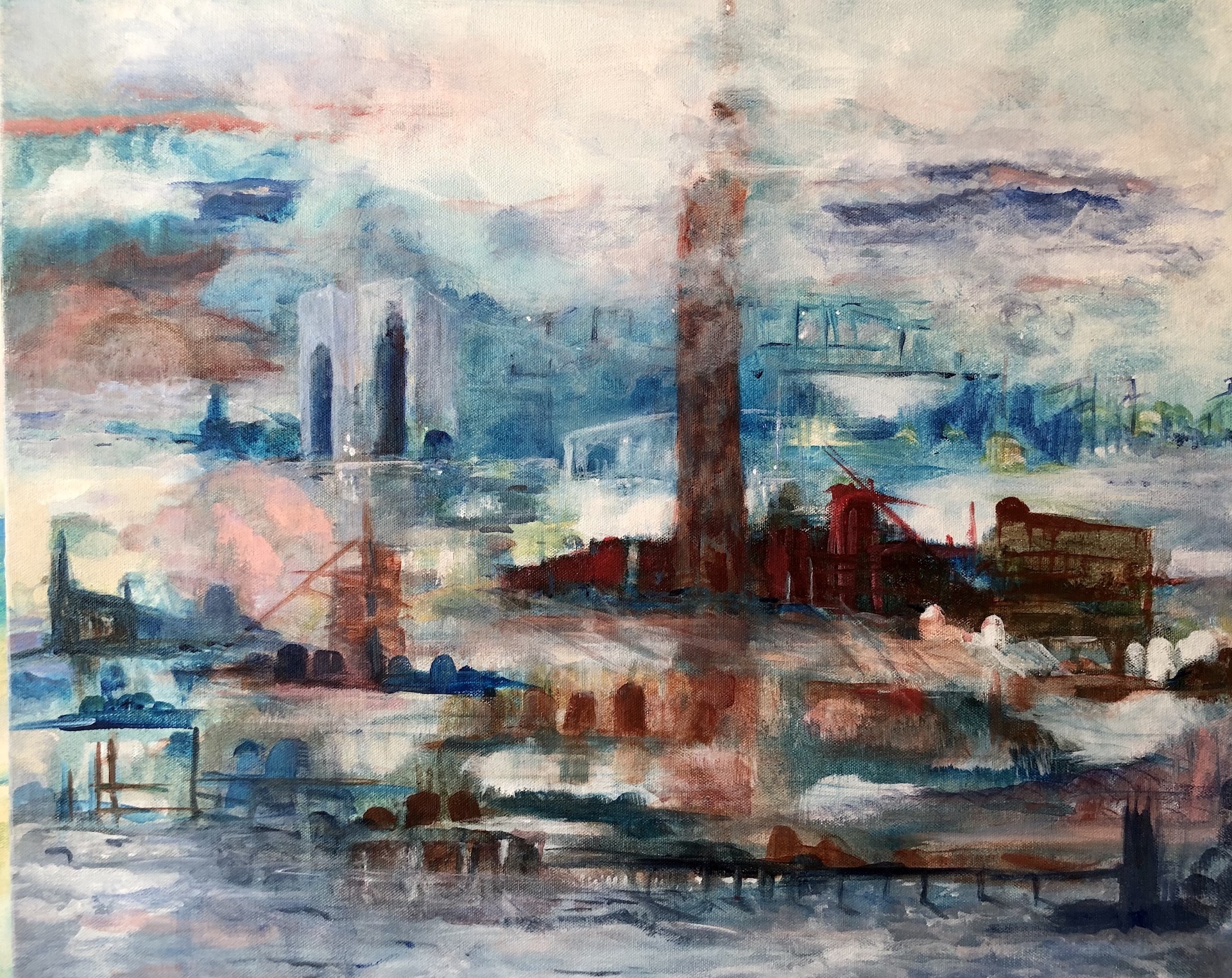
Clara Dennison
What Remains After the Storms
Inspired by: Laura McPhee, The Blue Lagoon
acrylic
20″ x 24″
2022
Instagram: clara.dennison , Meta: Paper Birch Art Studio

Alice Dillon
Breakstone’s
Inspired by: Evelyn Rydz, Gulf Pile John Willis, Recycled Realities 1 Winslow Homer, Gathering Berries
thread and alcohol ink marker on butter wrapper
5″ x 6″
2022
Relationship of the work from the Fitchburg Art Museum: I see an association to the texture in “Bulldozer Slash” by photographer Robert Adams to the textures in my painting.
@adillonart
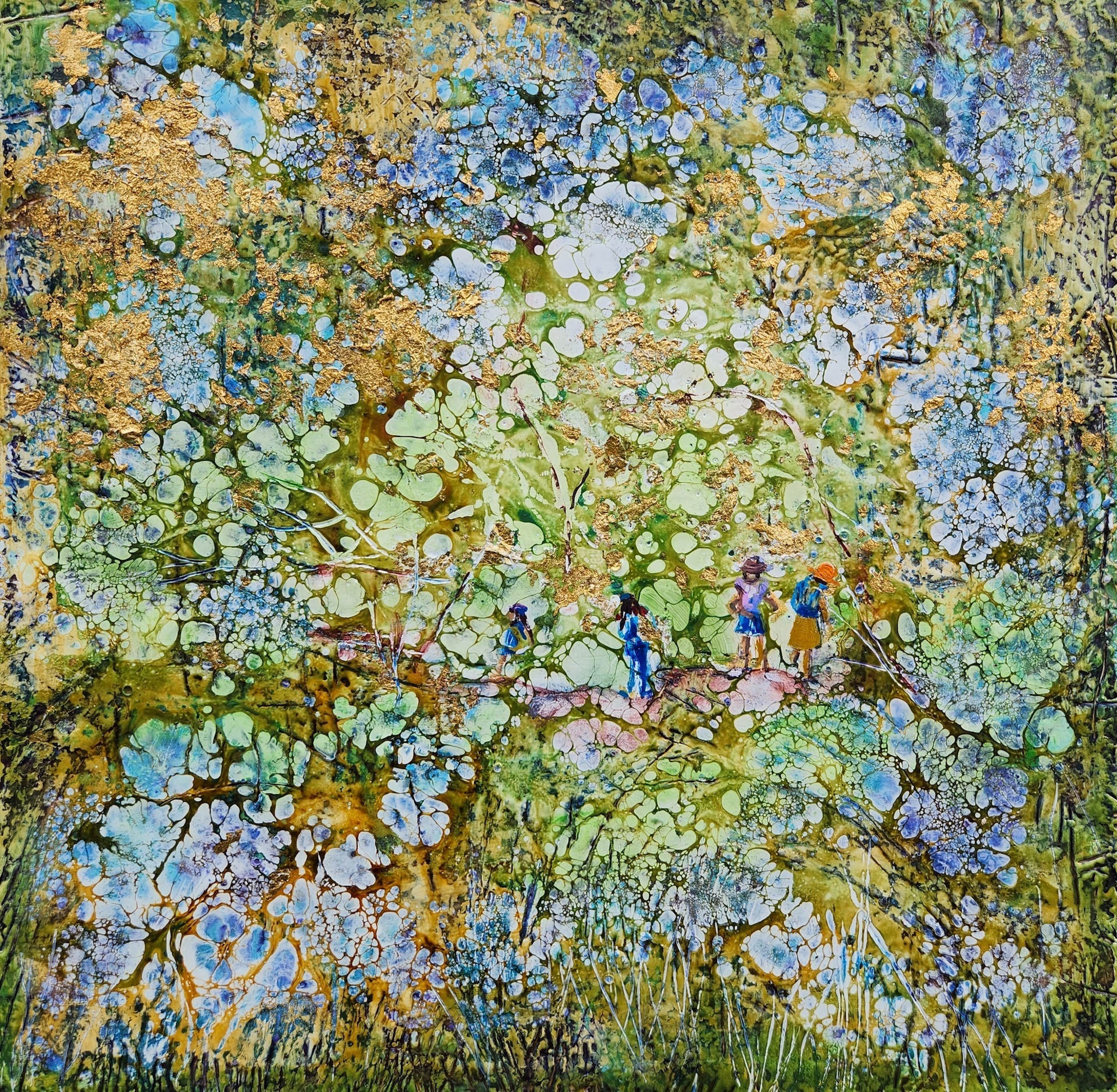
Pamela Dorris DeJong
A Walk in the Park
Inspired by: Robert Adams, Bulldozed Slash Winslow Homer, Gathering Berries
encaustic, gold leaf, shellac, oil on panel
14″ x 14″ x 1″
2022
Winslow Homer’s ‘Gathering Berries’ inspired this painting. People of today use their leisure time to take walks and hikes in our local, regional, and national parks. Also inspired by Robert Adams’ photograph, ‘Bulldozed Slash’, I am given to hope that our parks will be preserved. I am grateful that our national parks are maintained with sustainability in mind. In my own community, our town forest is carefully maintained. When the pandemic began, more people started to use our local forest for outdoor walks. It became necessary for closer stewardship due to human and pet traffic. Fencing has gone up to protect tree and fern seedlings. Walking paths have been improved by removing trees across paths and building a bridge over a stream. I am hopeful that we will preserve and sustain our precious resources for enjoyment of our beautiful environment now and in the future.
@pameladejong on Instagram Pamela Dorris DeJong on Facebook
Silvia Dowdell
Bringing Down a Star
Inspired by: Winslow Homer, Gathering Berries
mixed media collage
14″ x 11″
2022
Humans have always manipulated the environment for their own benefit, and in this collage I wondered about what it would mean to me if some being brought down a star from the sky. Merely to see or experience something beautiful like this is enough, end then we would return it. A catch and release. Curiosity with respect for how natural objects exist without us, in their pure form.
@silvia.dowdell.art
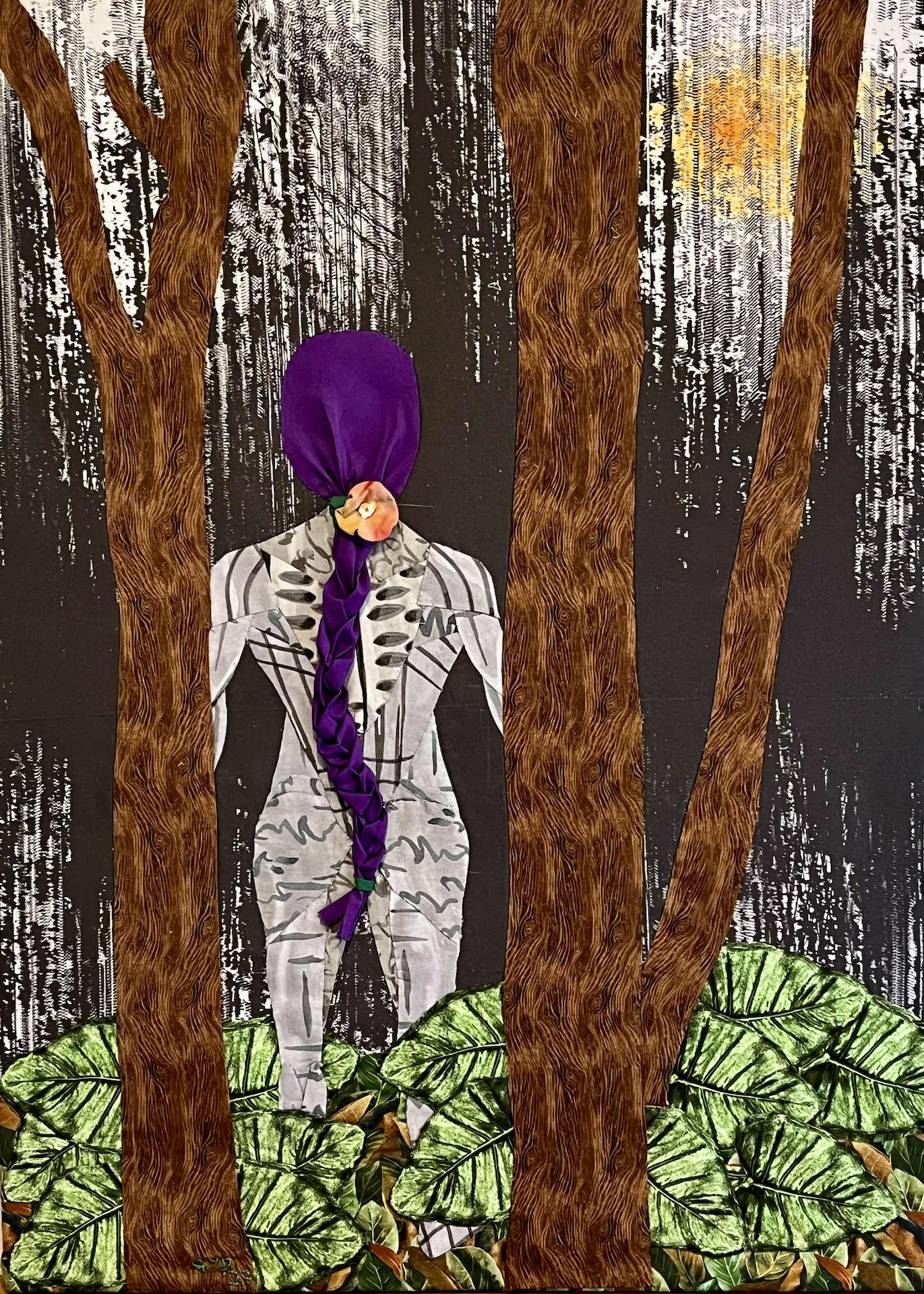
Annie DuBois
Frontline
Inspired by: Robert Adams, Bulldozed Slash Winslow Homer, Gathering Berries
cotton fabric and fabric reactive dye
34″ x 25″
2023
Appliqué is ornamental needlework where pieces of fabric are sewn over others to create an image. There are 54 pieces in Frontline. My work begins with someone else’s ideas of colors and shapes, and gives them new meanings. Sometimes, a print simply imposes itself, as did this eerie black and white background. Predictably, an initial sketch rarely survives a trip to the fabric store. My aim here is to capture the positive energy in Bulldozed Slash, where new growth rises defiantly, and in the profusion, movement, and youth of Gathering Berries. Many more forests have been ravaged since Adams took the photograph; there may be condos where Homer’s children picked berries. The world we are leaving for future generations is not the world we inherited. Our planet’s hope now rests with young people of the future, but they will need heroes, strong, determined, unconventional, like the young human in Frontline.
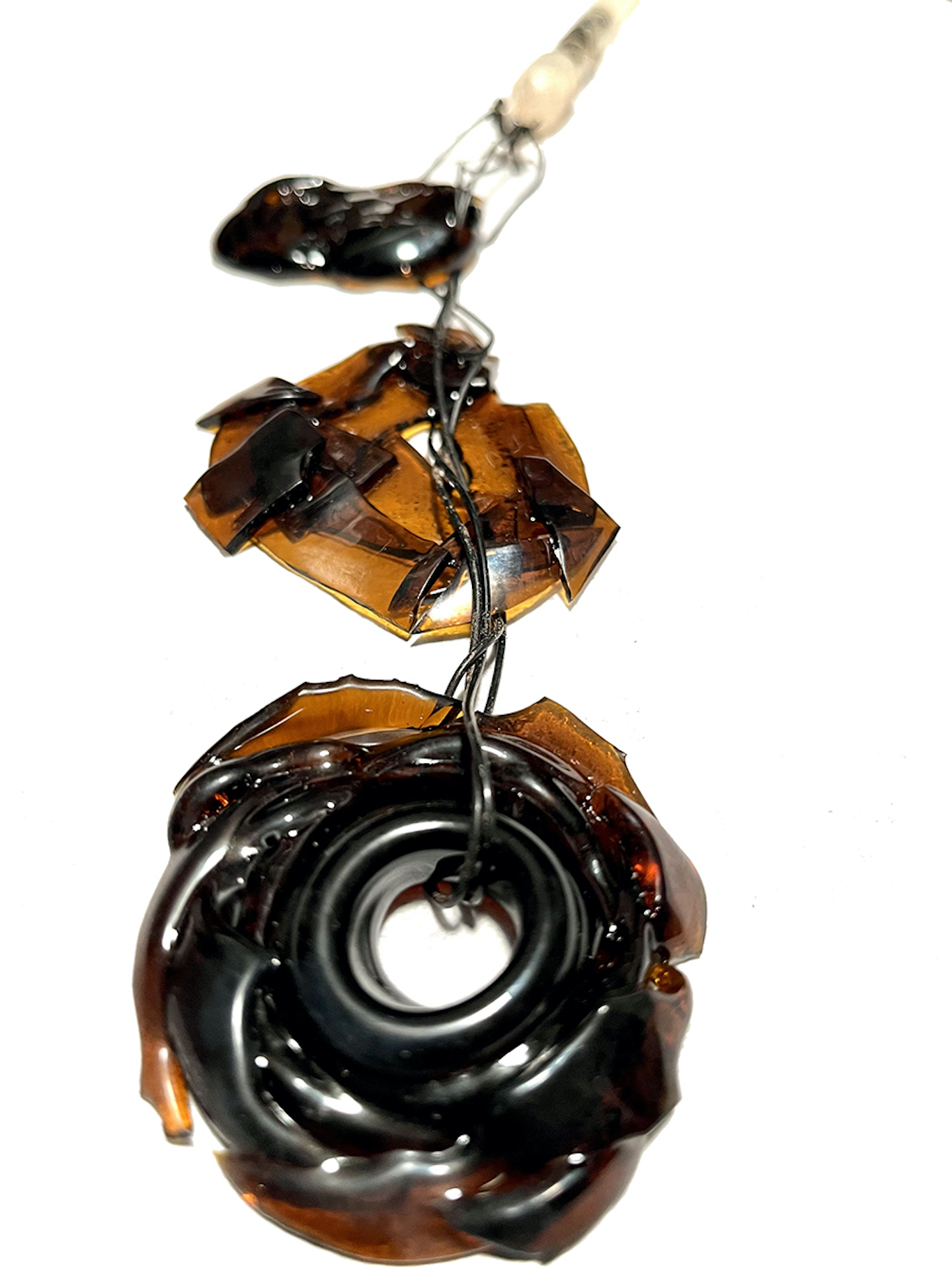
Kate Egnaczak
Mere Pond Worry Beads
Inspired by: Unknown artist, Yellow Amber Beads Evelyn Rydz, Gulf Pile John Willis, Recycled Realities 1
found Elm Park Mere Pond debris: neon glowstick necklace, glass beer bottle
3″ x 13″
2023
My work straddles the complexity of consumerism and the reality of maintaining public urban ecosystems. Like John Willis’s practice, I gather muddy artifacts and consumer byproducts as the physical evidence of my labor, care, and concern for ecology. Responding to “society’s offloaded waste,” I collect from a paddleboard, a central physical and highly visible act of my personal interventions. The stand of Mere Pond Worry Beads represents and echos the forms of the interconnected mere ponds and islands in Elm Park. A waterlogged beer bottle was transformed in a microwave glass kiln into beads The cast-off neon glow stick necklace connects the elements and challenges viewers to consider a former swamp, then dump, turned central water feature in a historic public park as a reminder of the climate crisis affecting our entire planet on an exponential scale.
@train_by_living, FB: kate egnaczak
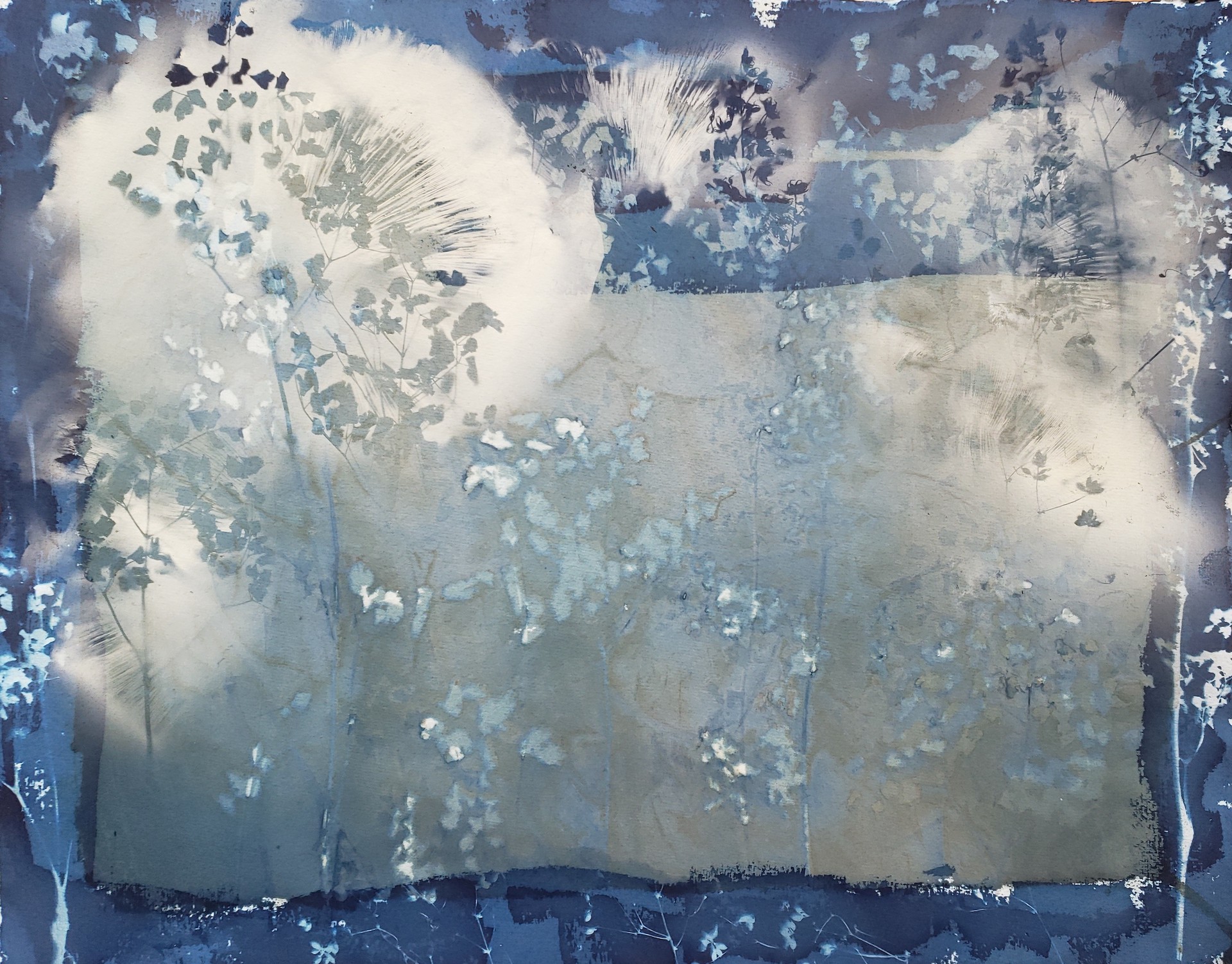
Madge Evers
Ghost Trees Dusk
Inspired by: Robert Adams, Bulldozed Slash Esther Solondz, Untitled (Rust Portrait)
cyanotype and mushroom spores on paper
16″ x 20″
2021
Like Robert Adams’ Bulldozed Slash, Ghost Tree Dusk originated in the American west where I gathered Meadow Rue/Thalictrum from Rocky Mountain meadows in July of 2021 as a smoky veil from millions of acres of burning trees in the Pacific Northwest shrouded the surrounding peaks. I understand Adams’ desire to find hope within a natural world ravaged by humans; I find hope in the symbiotic relationship between plants and fungi, called mycorrhizae. I use mushroom spores as a medium to make this relationship visible; spores help me depict the plants that I forage. Ghost Tree Dusk began as a cyanotype photogram, over which I made several mushroom spore prints that repeated the botanical form in the cyanotype. Like Esther Solondz’s use of rust in Untitled (Rust Portrait), I work collaboratively with material from nature to convey resilience, adaptation, and connection.
@_sporeplay

Jakob Fioole
the takeover
Inspired by: Robert Adams, Bulldozed Slash
oil on linen
27.5″ x 31.5″
2023
My painting is set in a time where nature only exists as a picture on a billboard, but it looks like it is about to overcome and reclaim the structures and buildings of our cities. This work is a response to Bulldozed Slash, a photograph by Robert Adams, which documents the American landscape and its change over time. Showing humanity’s imprint and nature’s resilience, it fascinates me how it depicts chaos and decay in a beautiful way, suggesting fear as well as hope. Most photographs make you think about the past, they make you wonder what was going on at the moment it was taken. Adams’ photo has this quality, but it inevitably makes you think about the future as well. In this painting I’ve tried to portray a moment of change.
@jakobfioole
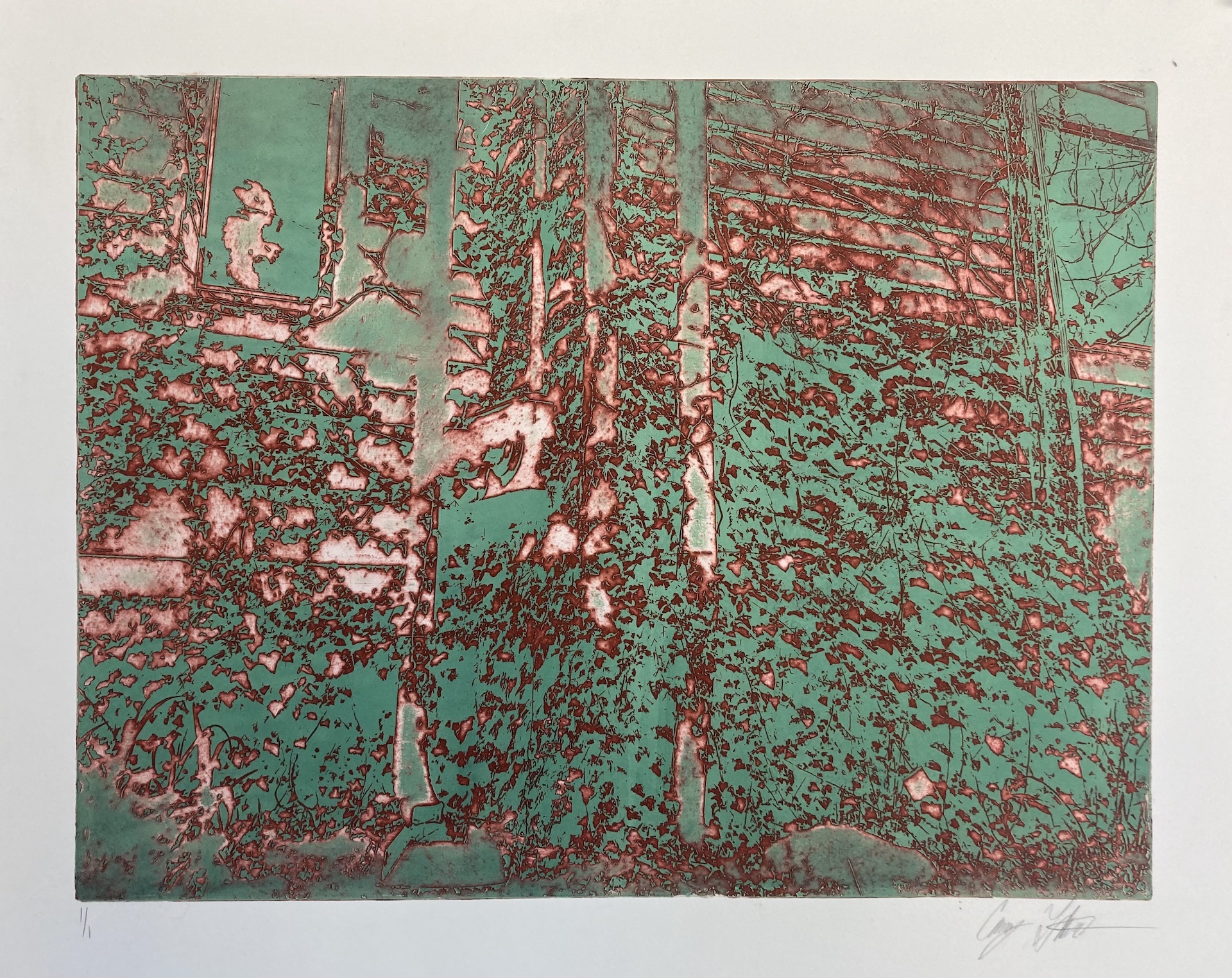
Casey Fisher
Our House is Bleeding
Inspired by: Robert Adams, Bulldozed Slash Esther Solondz, Untitled (Rust Portrait) Harvey Sadow, Fire and Flood/Sacred Sites
viscosity print
20″ x 26″
2022
We have a symbiotic relationship with the natural world and through printmaking techniques, I respond to post-industrial landscapes and the age of the Anthropocene. A dominant influence in my work is uninhabited urban architectural forms that I see around me and the materials that are naturally sourced; metal, concrete/ brick, vines/weeds, and native foliage. By removing any figurative element and rather showing the post-inhabited surroundings, this work describes the footprint and pain we leave behind on the land and explores the regrowth of the natural world after industrial influence, depicting the slow and methodical resilience and reclamation of nature. Elements of decay depicted by rusted and patinated structures both represent the destructive hand we force on nature while also demonstrates the power of nature and their cycles returning these man made structures to their original roots.
@kc_james @kcar.t
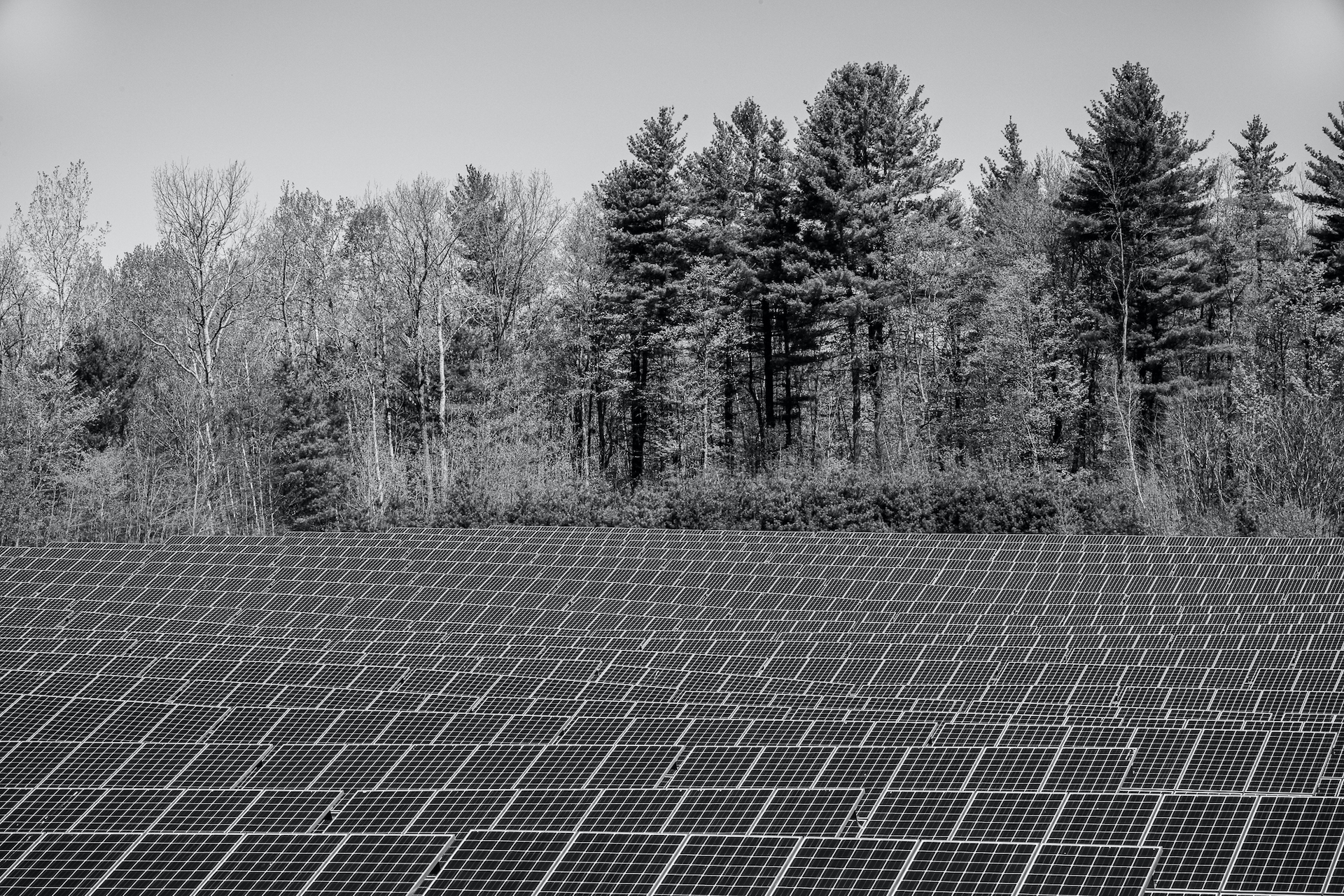
Nathan Fiske
Solar Ocean
Inspired by: Laura McPhee, The Blue Lagoon
digital print
11″ x 17″
2022
Although I appreciate the impact solar panels have on the climate crisis, they now seem to take over open fields and creep upon forest boundaries throughout New England. I began noticing the prevalence of solar panels on daily naps with my kids during Covid, and Laura McPhee’s Blue Lagoon print has a similar feel. The benefits of solar panels greatly outweigh their mark on the landscape, but I find it important to acknowledge the impact on the natural habitat.
@nathanfiskephotography
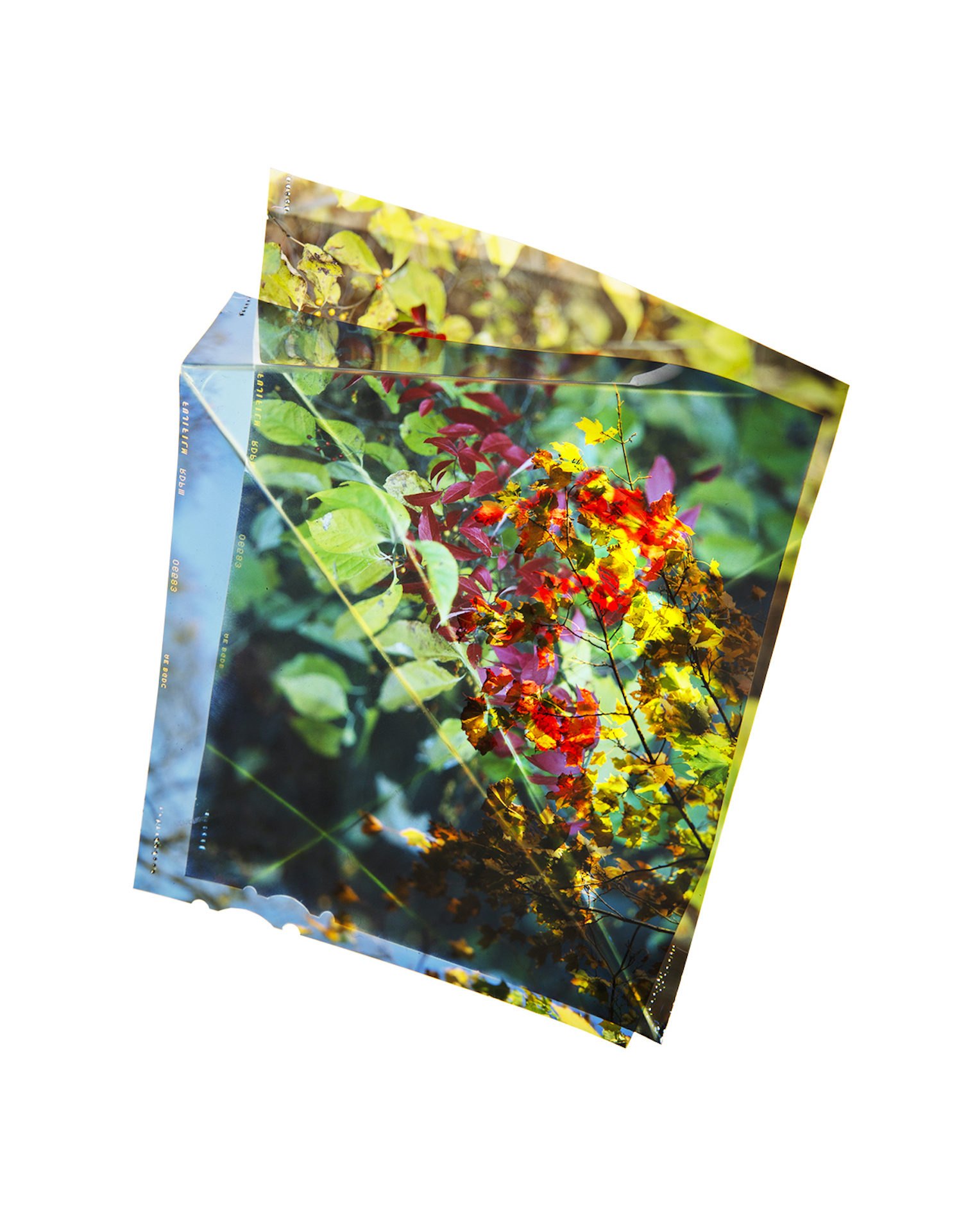
Colleen Fitzgerald
Land & Sea XVI
Inspired by: Robert Adams, Bulldozed Slash
pigment print
11″ x 14″
2020
‘Land & Sea XVI’, from the photography series ‘Stamina’, is a colorful piece that responds to the black and white print by Adams. Both pieces use film and uniquely showcase distorted trees within the landscape. Adams’ work embraces regrowth and endurance within nature, showcasing a detailed view of the forest in flux. ‘Land & Sea XVI’ uses an experimental process; large format film is bent and sculpted in-camera, resulting in a distorted reimaging of the landscape it pictures, including foliage and trees. Adams’ work whispers of the resilience of nature, and ‘Land & Sea XVI’ also incorporates the endurance of the material of film itself as it is bent and pushed to its limits. The two sheets of sculpted transparency film overlap, creating a new perspective. Both works indicate the intervention and presence of the human hand and gesture, whether on the film itself or directly in the environment.
@colleen.fitz
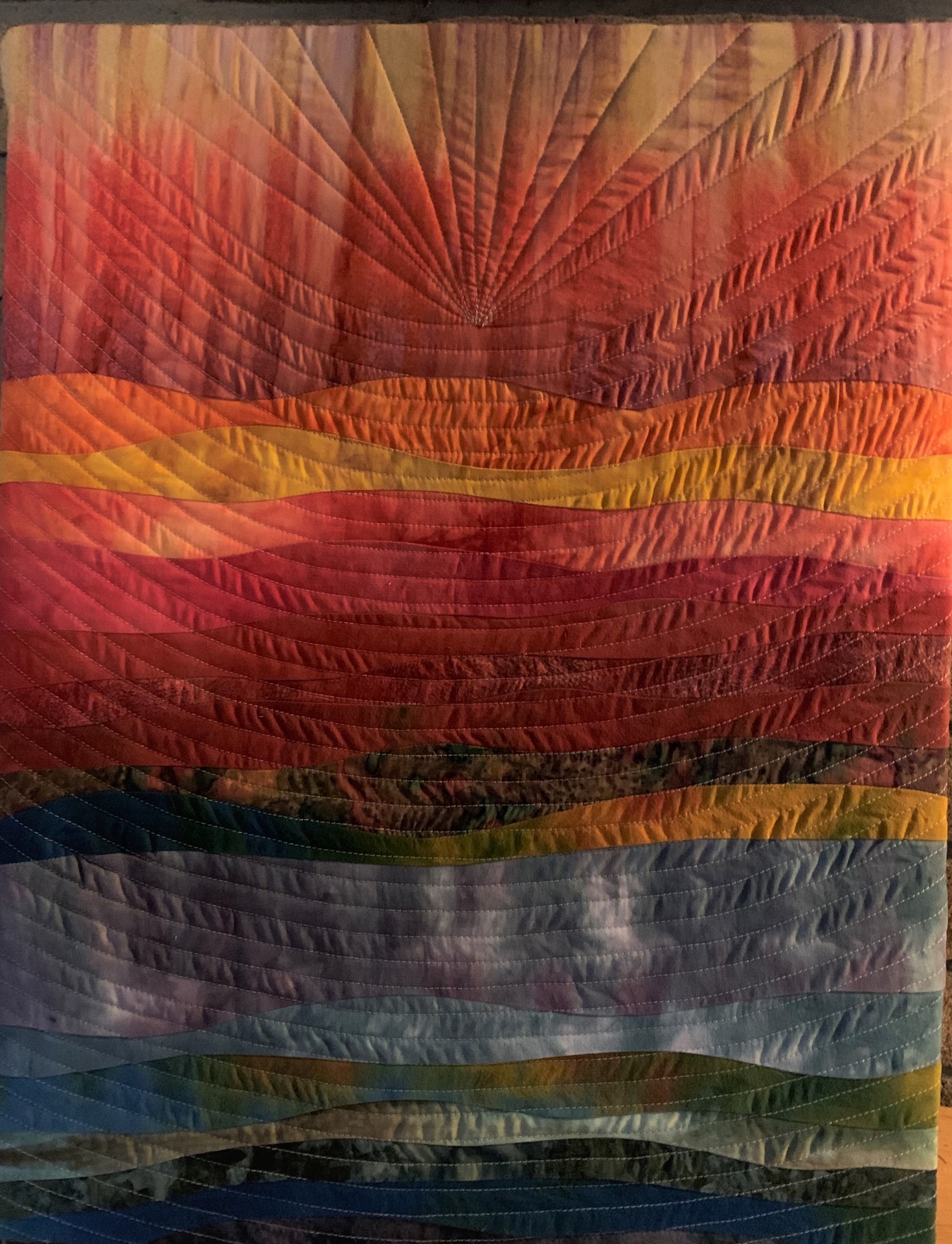
Elizabeth Foss
Water and Sky
Inspired by: Harvey Sadow, Fire and Flood/Sacred Sites
fabric-pieced quilting mounted on wood
17″ x 22″
2023
Harvey Sadow’s ceramic piece is so moving in its beauty and its evocation of fire and flood. I wanted to capture some of this essence in textiles.
quiltsbylizfoss.com quiltsbylizfoss@facebook.com lizfossquilts@instagram.com
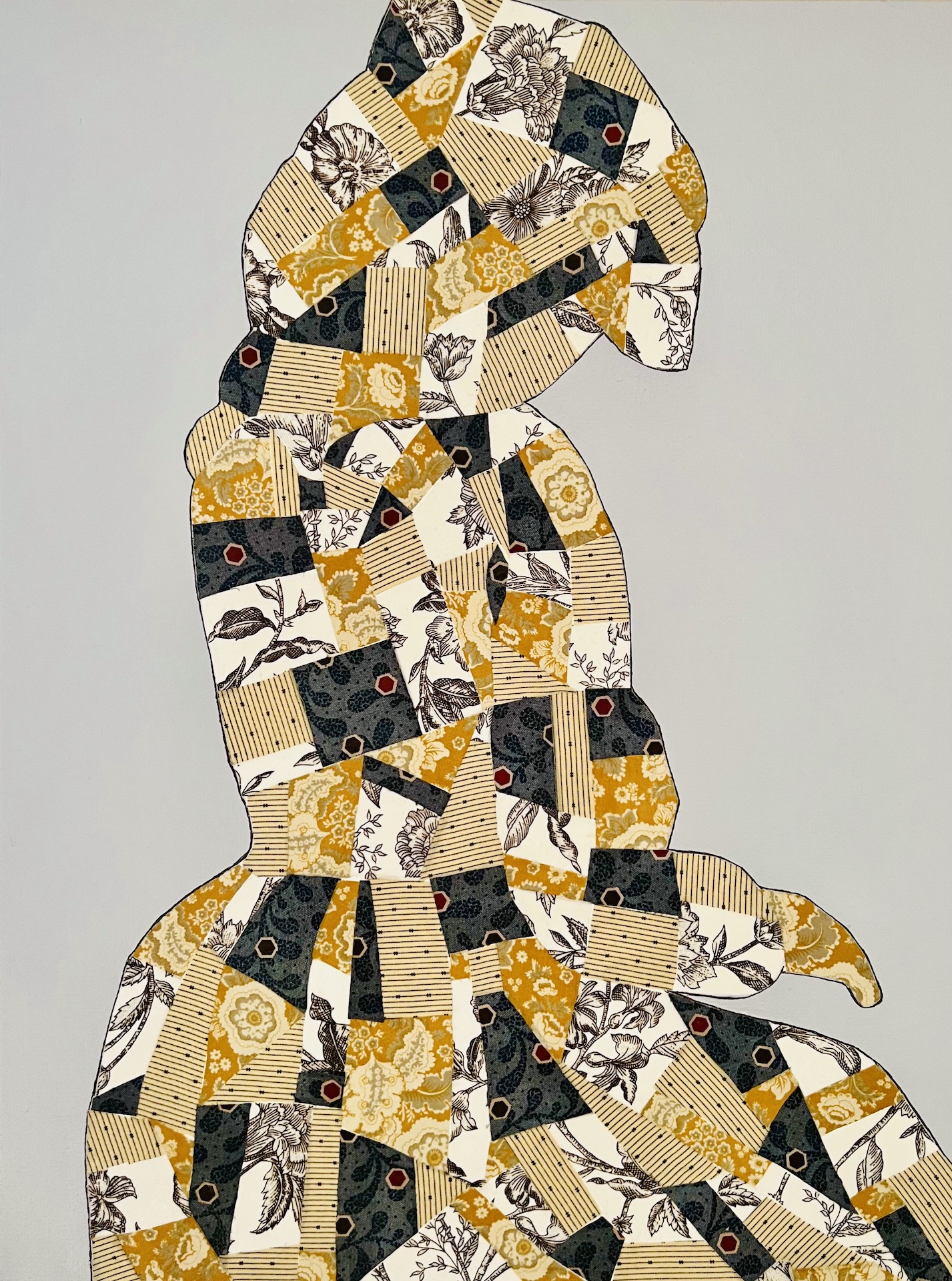
Lisa Foster
Girl With Hat, No Berries
Inspired by: Winslow Homer, Gathering Berries
reproduction quilting fabrics and acrylic on canvas
18″ x 24″
2023
Winslow Homer’s Gathering Berries, was created at the start of The Industrial Revolution. So much harm has come to out natural world, at the hands of humanity, since that time. Tranquility is still found from our connection to nature, even as it slips from our grasp. My girl with a hat seems to be reaching for something that is no longer there, perhaps with out her realization of it. I fear for the children yet to be born, who will have even less of the natural world to hold onto.
on instagram Lisa.a.foster.1. on Facebook Lisa Anne Foster

Sharon Freed
Another Kind
Inspired by: Laura McPhee, The Blue Lagoon
digital photography
16″ x 20″
2021

Timothy Gannon
Head of a Girl
Inspired by: Winslow Homer, Gathering Berries
acrylic on canvas
18″ x 24″
2020-22

Alana Garrigues
Food for All: August in Tillamook County
Inspired by: Robert Adams, Bulldozed Slash Winslow Homer, Gathering Berries
acrylic ink, graphite, chalk pastel, watercolor, gouache, archival India ink on paper
22″ x 30″
2023
As soon as I saw the photograph by Robert Adams from Tillamook County, the story behind this artwork formed in my mind. Born and raised in Oregon, I have spent many months in Tillamook County, which is located along the Oregon Coast. I’ve watched forest disappear due to fire, storms, landslides, and logging. Every time, one of the first plants to move in is the blackberry bush. Considered by many a pest, I love it for the roadside and trailside snack available the full month of August, along with salal and huckleberry. It’s a true immersive joy to walk and pick berries, alongside the wildlife who depend on it for food. This image is a combination of several places I’ve known in Tillamook County infused together… I’m thinking of a specific cedar, a specific buck, a specific squirrel, a specific beach, a specific bush. They only meet on the page.
@alanaofloveandlight
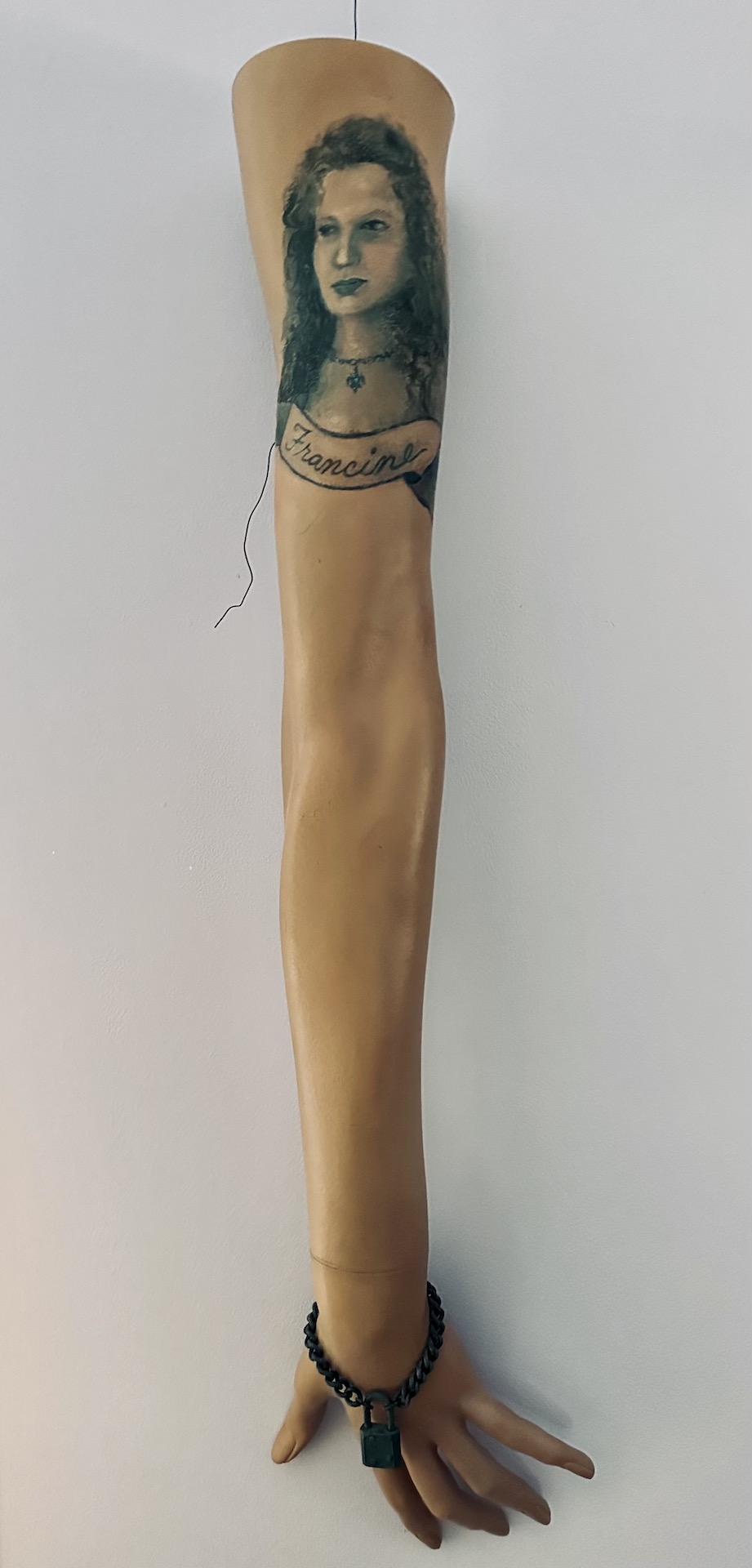
Francine Gintoff
Francine
Inspired by: Esther Solondz, Untitled (Rust Portrait)
acrylic paint on found mannequin with metal
36″ x 7″
2018
The self portrait “Francine” is painted on a found vintage mannequin arm to resemble a tattoo. It also has an attached metal bracelet with a lock. I think this work connects with the Esther Solondz portrait that was created by rust. The blue coloration in my portrait and the metal bracelet evoke oxidation which can be a result of being exposed to the elements and being outside. Both portraits are done on alternative surfaces.
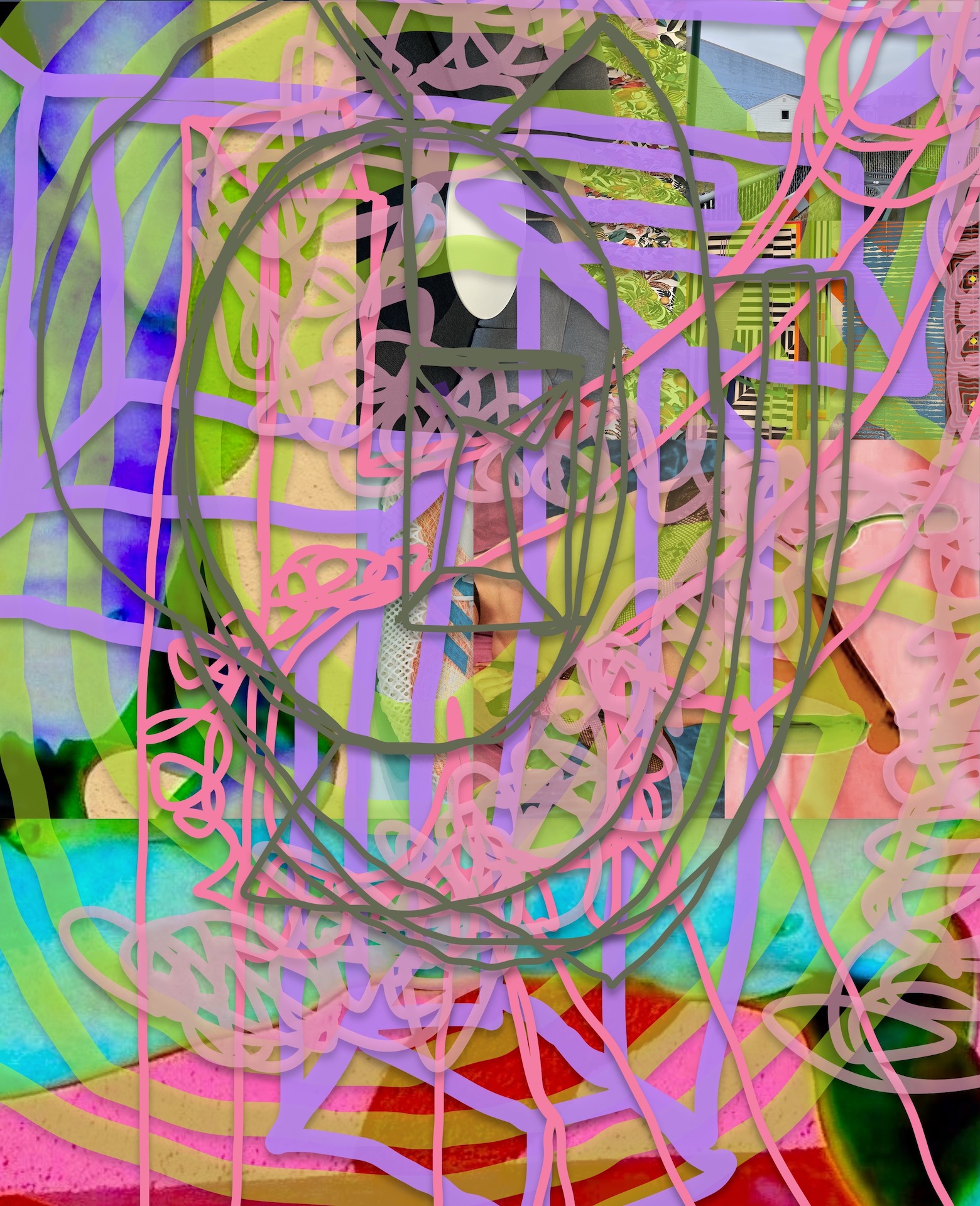
John Gintoff
Call It A Rap
Inspired by: John Willis, Recycled Realities 1
drawn-on inkjet print
22″ x 17″
2023
In today’s awareness of how recycling can possibly alleviate the world’s trash problem, Willis’ photo seems appropriate. He is not only taking a photo. He is taking a photo of refuse, and refuse that contains a photograph from the front page of the New York Times. This photograph is of a painting stolen from the Louvre. The rest of his photo is of bundled newsprint. My initial collage is comprised of images that I have either “recycled”, appropriated from the internet or I have personally shot. This group of images is then wrapped and bundled by the colored lines of various widths that have I have drawn over them. One of the images is of the house that the artist Mike Kelly grew up in, which he had replicated and built in a lot in downtown Detroit.
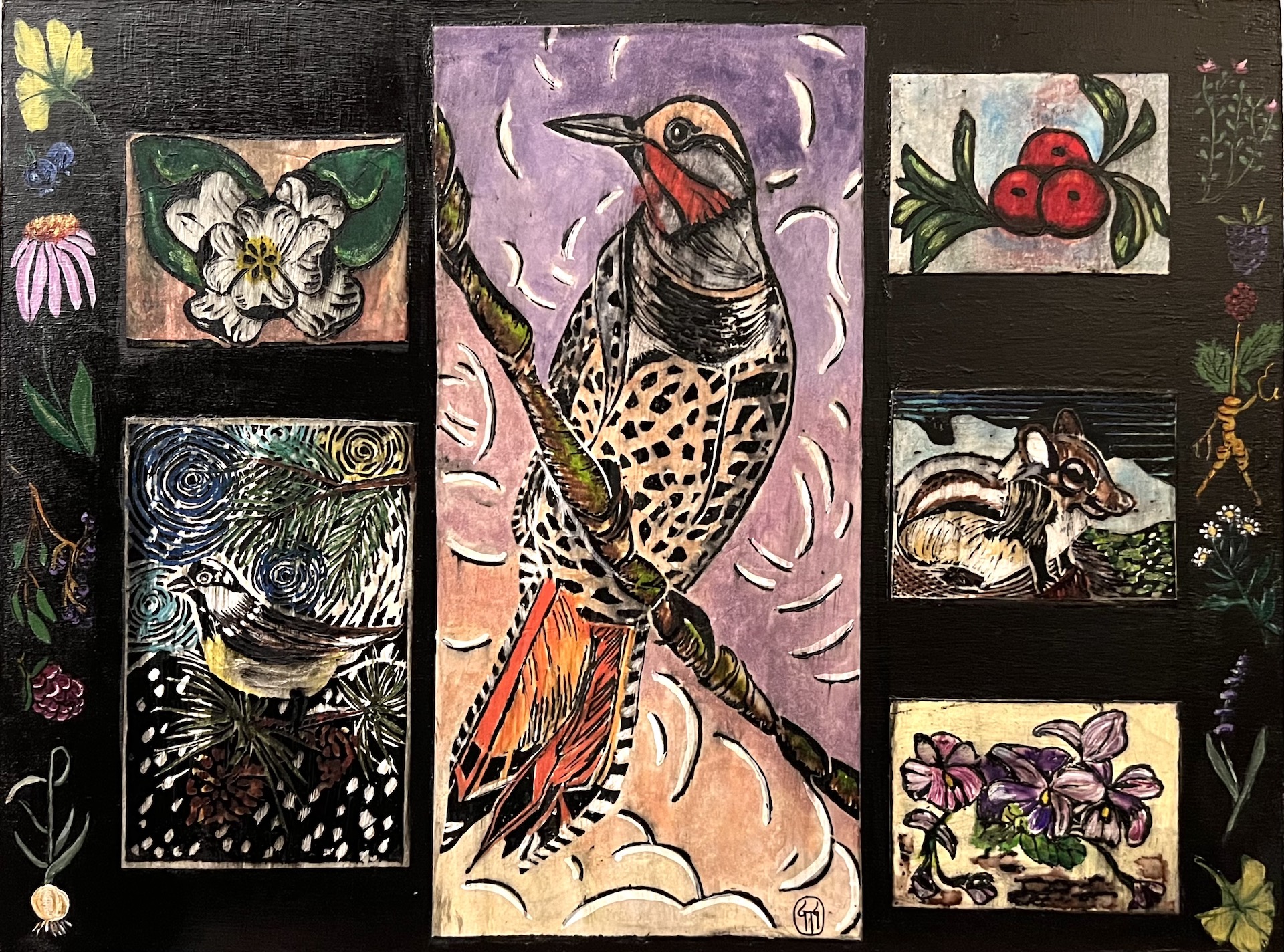
Gloria Goguen
My New England Roots
Inspired by: Lionel Reinford, Winter in New England Winslow Homer, Gathering Berries Robert Adams, Bulldozed Slash
mixed media: block prints, watercolor, and acrylic on cradled wood panel
12″ x 16″
2023
Inspired artists who have endeavored to capture the beauty of the natural world through art. I have captured my “New England Roots” in a folk-art style with inspiration from Lionel Reinford’s “Winter in New England”. They are views of my cherished landscape. Block prints capture the casual wonder my environment holds for me. Like Winslow Homer’s “Gathering Berries” wood engraving, they are my observations of the beguiling nature existing in daily life. The margins depict familiar medicinal plants. Our ancestors considered them sacred for health wellbeing, therefore protected them. They can endure once left alone to reestablish in spite of all our wanton destruction of their habitats. Taking a cue from Robert Adams photo “Bulldozed Slash, Tillamook County, Oregon” the regrowth of our natural environments holds the key to our vitality. We knew it many generations ago and we hope it is always there for those who come after us.
@gloriajgoguenart
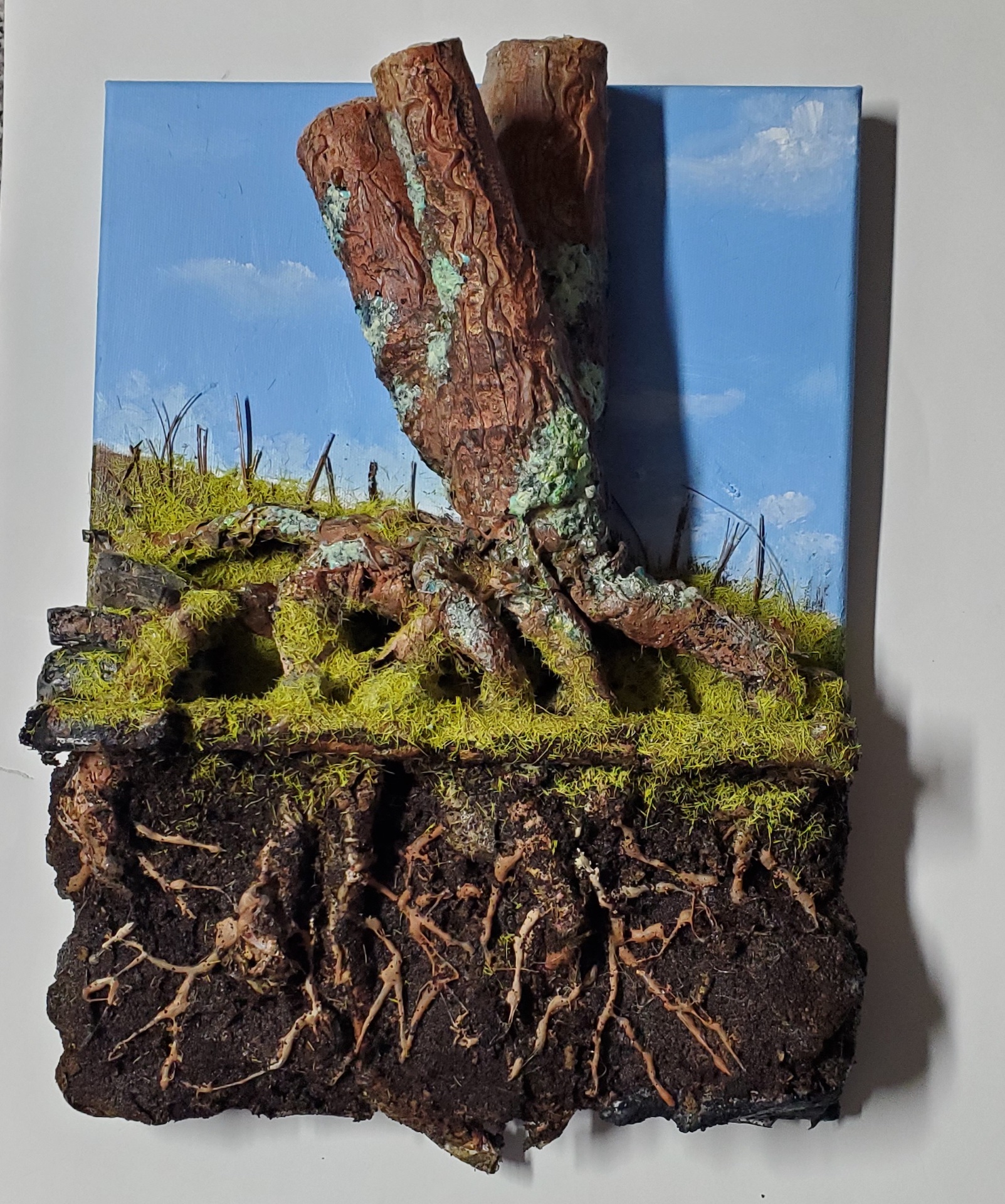
Libia Goncalves-Quintero
Entangled with the Earth
Inspired by: Robert Adams, Bulldozed Slash
mixed media: paper towel roll, Styrofoam, newspaper, saw dust, coffee grounds, rope, hot glue, and acrylics on canvas
12″ x 16″
2022
Without trees, life is not possible. The roots anchor the tree, they search deeply for nutrients to nourish it, because they still do not know there is no tree anymore, irrationally, man cuts them down. The roots continue to be entangled with the earth, in winter, it is a storehouse for essential food, reserve needed by the tree when spring comes, to render the foliage, but the roots do not know somebody without compassion clipped the tree. Tenaciously, they continue tightly entangled to the soil, until one day, they also die because of loneliness and without their fundamental purpose “supporting the tree.” As the tree we also have strong roots, which are our foundation, where does it lie our experience, our inner determination, and our self-confidence. They provide a strong and sturdy home right where we are planted.
Dcolorex.com

Donna Gordon
Trashed Sidewalk Flowers, Brattle St., Cambridge
Inspired by: Robert Adams, Bulldozed Slash Evelyn Rydz, Gulf Pile John Willis, Recycled Realities 1
digital print on Nepalese paper
16″ x 20″
2022
I was walking in my neighborhood in Cambridge, MA, when I came across a bouquet of flowers strewn on the sidewalk outside a large house set back from the road. The flowers had been thrown down and had begun to decompose, but some of their colors and structural beauty remained. I wondered about the moment when whomever had entertained or sat solitary with them, had chosen to throw them away. Their accidental beauty was compelling and I stayed a little while and made several photographs. The image is printed on Nepalese paper, a handmade paper worn at the edges that seems to suit their fragile, wasting state. I was drawn to three images in the loan–that of Robert Adams, Evelyn Rydz, John Willis–for the same reason I was attracted to the trashed flowers. All share the complex quality of what remains after being used up and disrupted by human hands.
Instagram donnagordon8994 FB. donnasgordon

Miranda Greenhalgh
Portland Sky 2023
Inspired by: Robert Adams, Bulldozed Slash Evelyn Rydz, Gulf Pile
acrylic on canvas, mixed media collage
16″ x 20″
2023
“Portland Sky 2023” is an acrylic and mixed media collage for submission in ArtsWorcester’s Impact show. This piece is inspired by two of the Fitchburg Art Museums pieces – “Bulldoze Slash, Tillamook Oregon” and “Gulf Piles.” I was born in just outside Portland with extended family in the area. In this piece, Mt. Hood dominates the Portland skyline, but all natural elements are replaced by trash and plastic, where the man made buildings and road are made up of natural materials. Thank you to my cousin Darrell Gossett for reference photos to work from.
@MirandaGreenhalghArt
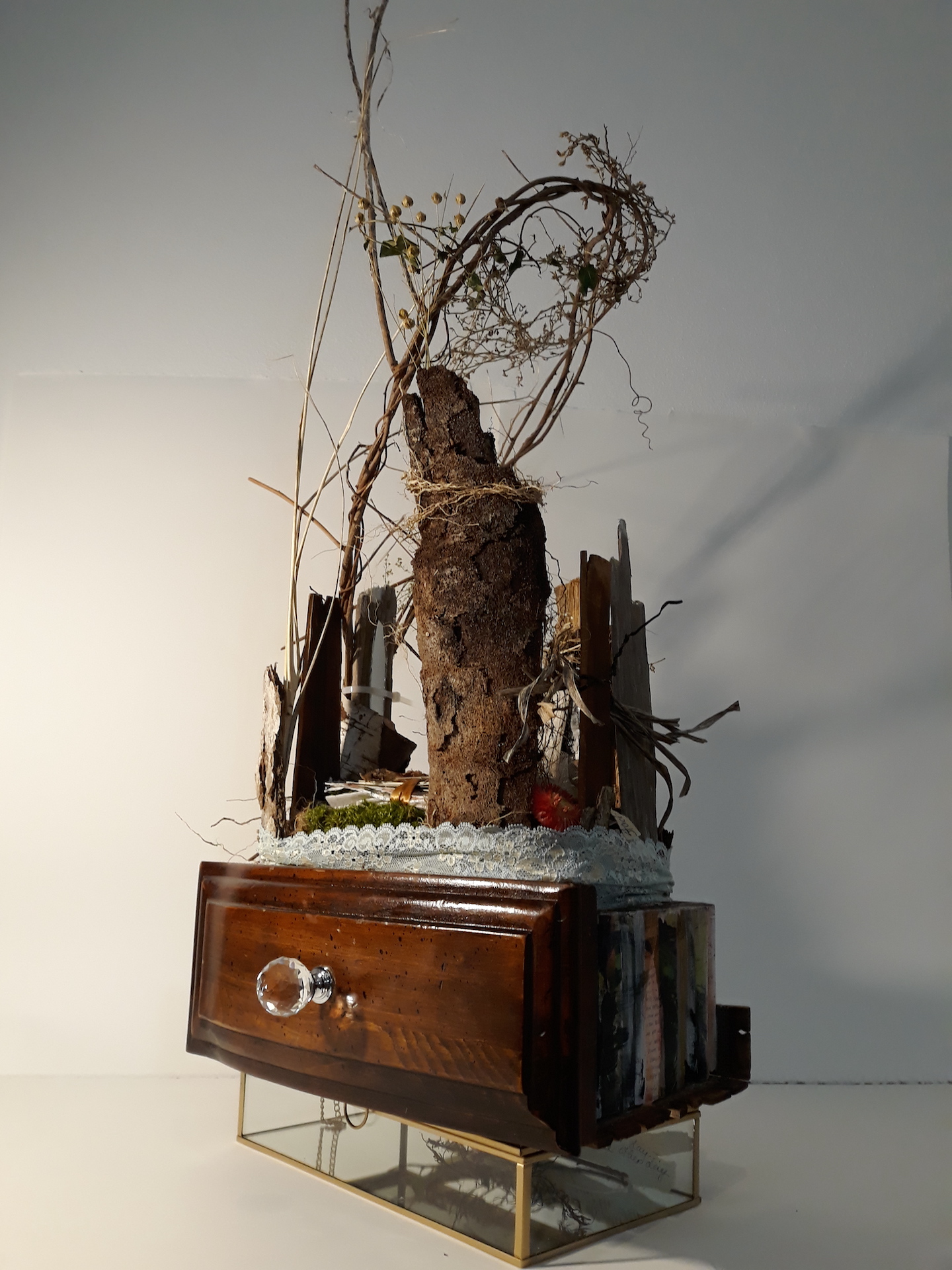
Martha Hauston
Memoir Experienced
Inspired by: Lionel Reinford, Winter in New England
sculpture
38″ x 13″
2023
Nature engenders memories and emotions, providing a quiet structure of containment and inviting reconnection with the self. Giant pine trees support cathedrals to the sky where light and imagination come and go like clouds or shimmering window candles in winter. “The world as he [we] would like it to be” is portrayed in Lionel Reinford’s peaceful, ordered winter landscape painting. As non-traditional “mature” persons working with under-served and vulnerable populations, the natural world has cradled and comforted Reinford and me through times when we could perhaps find no sense or control in the “real world.” Our encounters with nature have supported reflection, solace, and sense of order. Collecting sticks, moss, memorabilia, and fibers found in the woods, on beaches, or even discarded on a stranger’s front lawn, orders my world. Disparate pieces reconstructed illustrate “an inner world I [we] can affect but not control.” Loss, durability, and remembrance is messy.

Lisa Hayden
Winter by the Water in New England
Inspired by: Laura McPhee, The Blue Lagoon Lionel Reinford, Winter in New England
acrylic on canvas
24″ x36″ x 1.5″
2023
People have always loved to live along the water for its beauty and utility. As we enter an era of a changing climate, New England will experience sea level rise and more extreme precipitation events every winter. Learning to adjust to this new environment will be a challenge faced by local communities which have been right at the water’s edge for hundreds of years. As a lifelong New Englander I was drawn to both Winter in New England with its old fashioned idealized winter (a type of cold winter that will be less frequent) and The Blue Lagoon with the thought of how people live near and use the water near them.
@meltedtheory
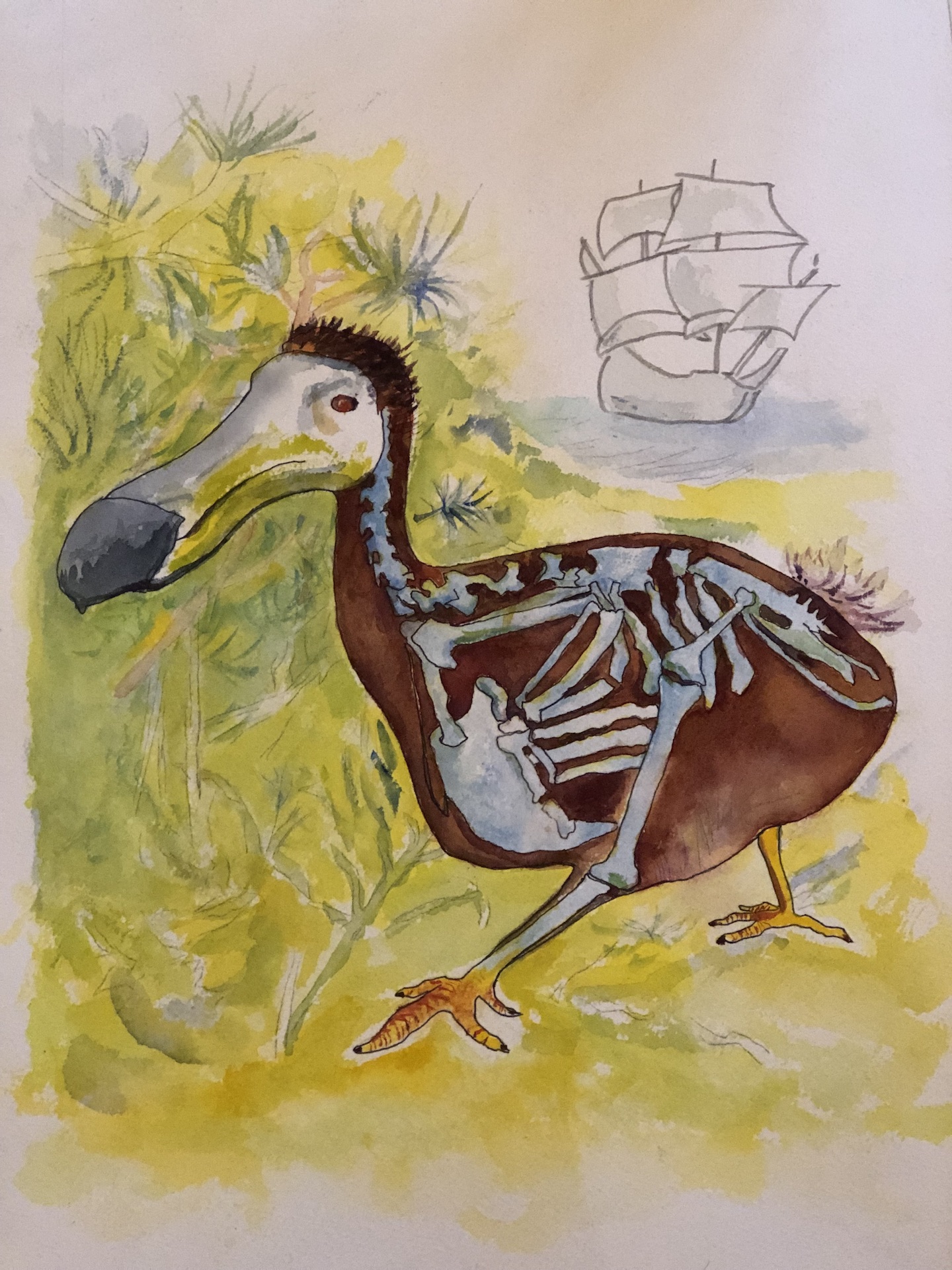
Robert Hopps
Dodo Puzzle
Inspired by: Robert Adams, Bulldozed Slash
ink and watercolor on Arches paper
14.25″ x 18.25″
2023
In my artwork titled “Dodo Puzzle,” I use ink and watercolor to ask what humans can learn from the extinction of this species – or any species. Should we look at the “fitness” of their species? (Dodos had survived and evolved for hundreds of thousands of years). Should we just count them among the 99% of species that have gone extinct on earth? (Dodos died out 65 years after humans settled the island of Mauritius around 1598. Dodos had no predators before the humans arrived. No rats, cats, dogs or agriculture.). Are they no longer relevant in this age of technology? (Humans arrived on their island using the latest in technology, sailing ships). Will the part Dodos played in the ecology of the island be lost forever? Inspired by the artwork “Bulldozed Slash”. Because all we have left of the dodo are skeletons.

Nikki Howland
Using Bio-Remediation to Eliminate the Gulf Pile
Inspired by: Evelyn Rydz, Gulf Pile
found plastics from beaches in MA, needle felted roving wool, glue
15” x 10” x 6”
2023
Did you know that there are mushrooms growing in our backyard and forests that have the ability to break down plastics in a matter of weeks? Considering the estimated lifespan of plastic is over 400 years, this is amazing news! Bioremediation is the use of naturally occurring biological processes to help reduce the ecological damage we are faced with today. Based on the research of Paul Stamets and Susan Simrad whose work has exposed the incredible world of mycelium (root systems of mushrooms) this sculpture depicts the trash in Evelyn Rydz’s drawing Gulf Pile being eliminated by Blue Oyster Mushroom mycelia. Wouldn’t it be wonderful if one day we could compost plastics in our own backyards?
@nikkihowland

James Hunt
Artillery Platforms at the Quabbin Reservoir, Gate 52, Ware, Massachusetts
Inspired by: Robert Adams, Bulldozed Slash
digital photography, archival inkjet print
20″ x 24″
2023
Clashes between the environment, health and human behavior are sometimes inexplicable. In the years from World War II through 1968, the Quabbin Reservoir, which supplies drinking water for 2 million people, was used as a testing range for weapons developed at the Springfield Armory. Large shells, made from a variety of substances, some incompatible with human drinking water, were routinely fired into the Reservoir. The guns are gone, of course, but the platforms remain. This submission was inspired by the FAM loan photograph, “Bulldozed Slash,” created by Robert Adams. Some human decisions and actions that may appear reasonable at the time, to some at least, can seem so incomprehensible when viewed from other perspectives.
@jameshuntphoto

Desmond Johnson
Tailpipes and Smokestacks
Inspired by: Laura McPhee, The Blue Lagoon Lionel Reinford, Winter in New England
inkjet black and white photograph on fine art paper
20″ x 16″
2022
Automobiles and most Electrical Power Plants are essential to modern societies yet they are two major contributors to the Green House Gases that are having a tremendous impact on the environment. The manufacturing of automobiles consumes a lot of energy and resources like steel, rubber, glass, plastics, paints, and many more materials. Also, the end of an automobile’s life doesn’t mark the end of its environmental impact. About 61% of the electricity generated in the United States is produced from fossil fuels (petroleum, coal, and natural gas) which emits combustion byproducts that have negative effects on the environment and human health. Inspired in contrast by Laura McPhee’s “The Blue Lagoon, Svartsengi Geothermal Pumping Station, Iceland” and Lionel Reinford’s “Winter in New England”.
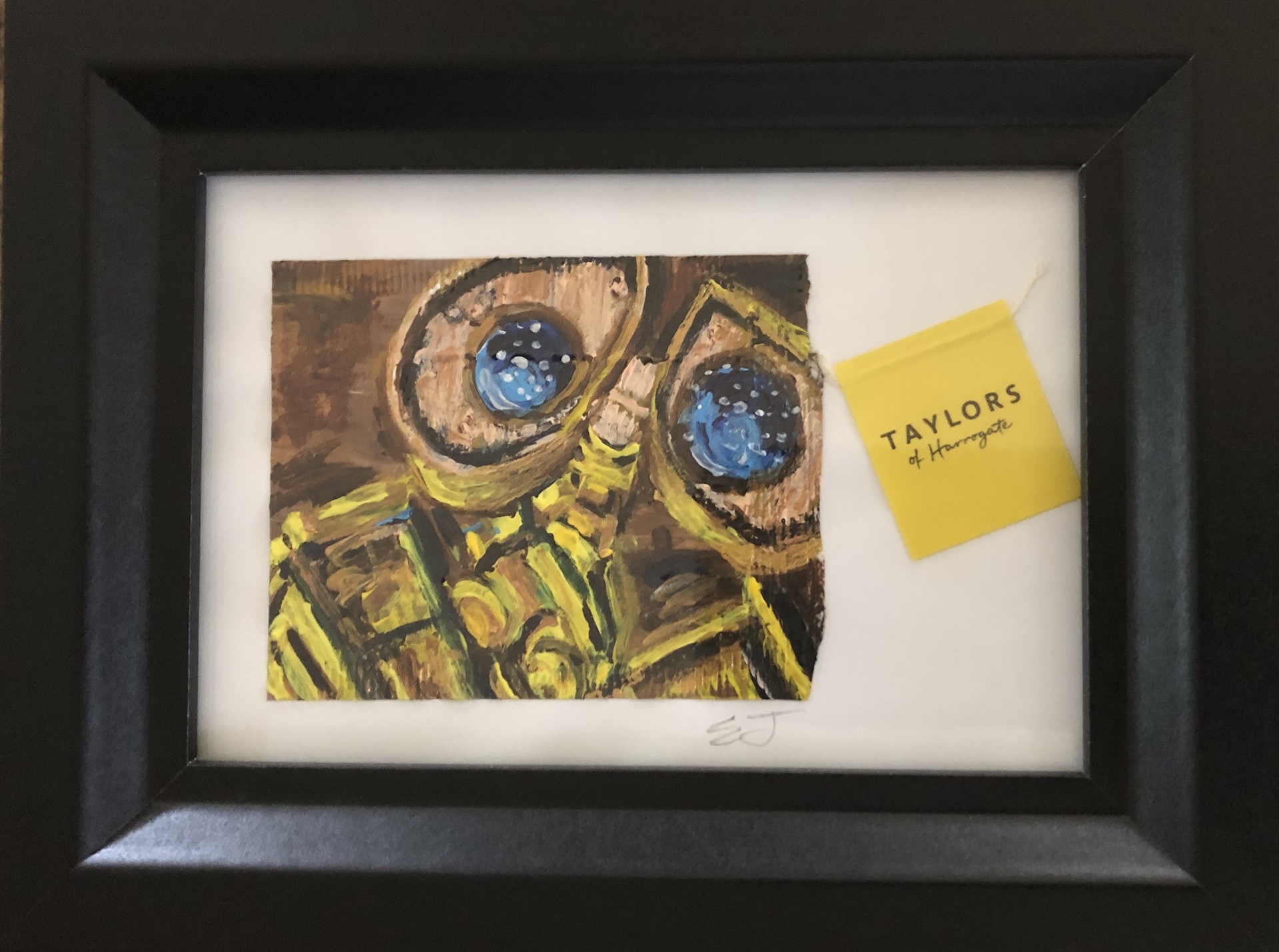
Elijah Johnson
WALL-E
Inspired by: Evelyn Rydz, Gulf Pile John Willis, Recycled Realities 1 Laura McPhee, The Blue Lagoon
acrylic on teabag
5” x 6 1/2”
2021
A dystopian Disney classic may be more close to reality than fantasy. A little yellow robot WALL-E is programmed to clean up the mess that humans left on Earth. We fall in love with this adorable character as he cleans and plays, falls in love and finds life among the rubble.
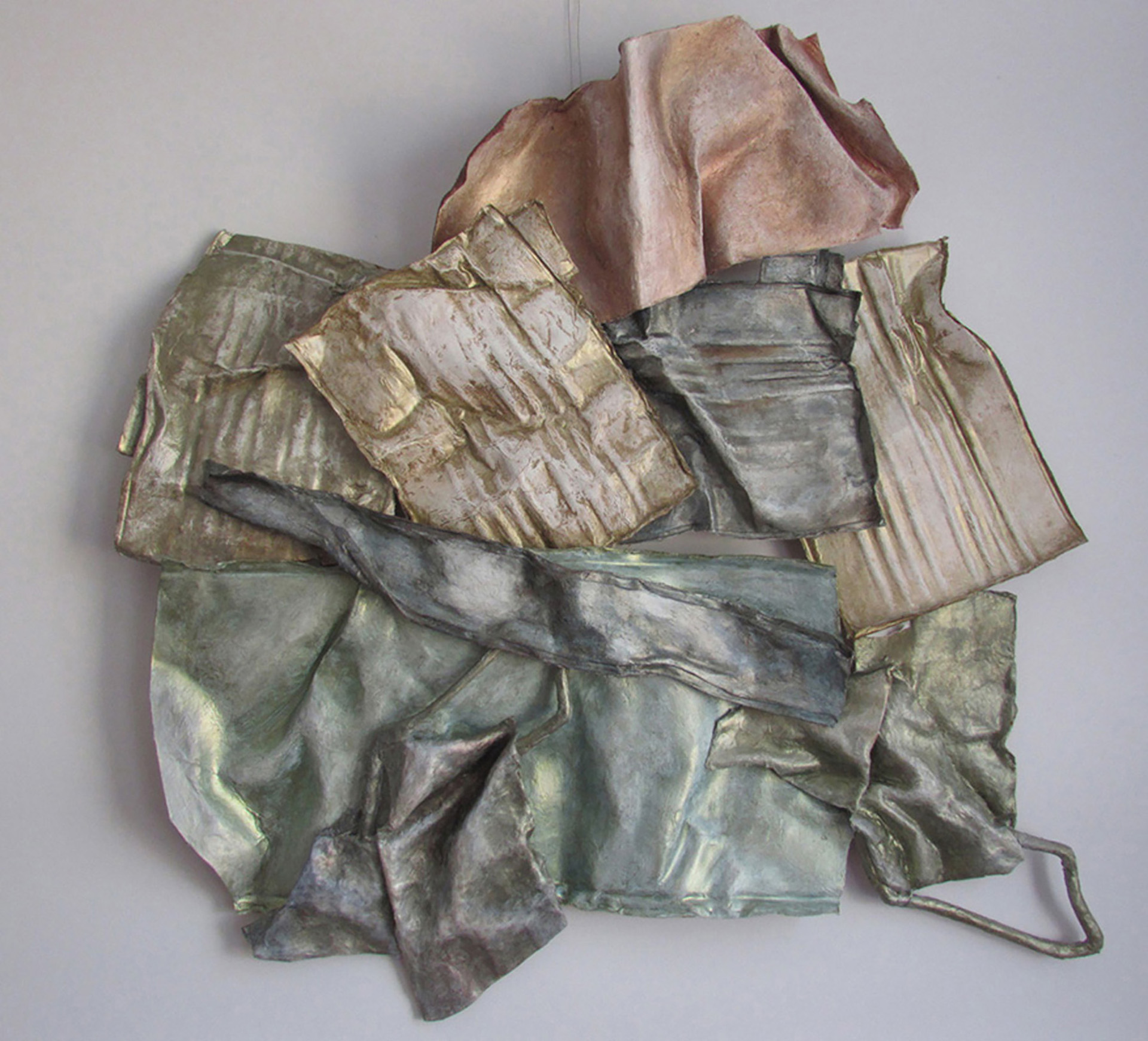
Lynne Johnson
A New Order
Inspired by: Evelyn Rydz, Gulf Pile John Willis, Recycled Realities 1
cast paper, acrylic paint
25″ x 25″ x 4″
2017
I was both fascinated and horrified to visit a metal recycling plant near home. Seeing all manner of metal objects, both large and small that had been discarded amazed me. School buses, heating boilers, signs as well as car parts and small cans were being crushed together into large cubes. When the plant was, sadly, being closed I selected a few small items to cast in paper and combine into a new configuration.
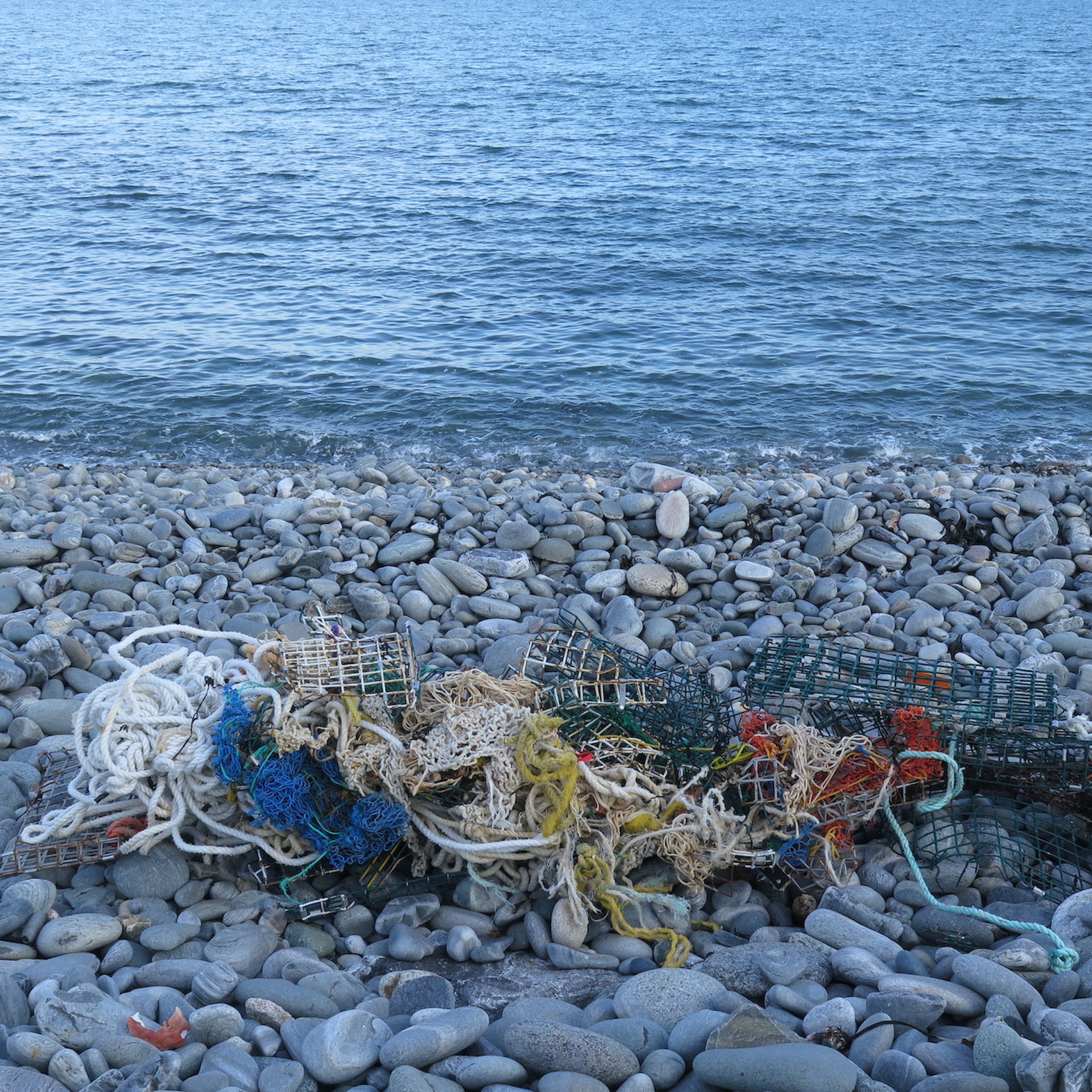
Timothy Johnson
Trap
Inspired by: Evelyn Rydz, Gulf Pile
photograph (archival inkjet print)
18″ x 18″ (image), 24″ x 24″ (framed)
2019

Beth Johnston
As Above, So Below
Inspired by: Unknown artist, Yellow Amber Beads
encaustic on wood with 24k gold leaf
12″ x 36″
2018
The description of Amber beads having “influence over cosmic light/shadow, attracting sunlight” speaks to the inspiration behind my piece. I’ve tried to capture the link between the galaxies and the cells found in all living organisms. Cells, galaxies and amber have an existence since prehistoric times and earlier. The encaustic medium has many connections to amber. Both include resin from trees, have a beautiful translucency and hue, and have a long history of being used by humans to beautify their lives.
@bethjohnstonart

Jack Keough
Recycled Soup
Inspired by: John Willis, Recycled Realities 1 Evelyn Rydz, Gulf Pile
oil pastels and mixed media on Strathmore paper and recycled materials
14.25″ x 22″
2023
I had started this painting a year ago of our in the house recycling paper bag that featured the Campbell’s Soup can prominently. (I’m not a huge Warhol fan). The recycling theme expanded for the “Impact” show and I used mainly personal effects on the frame including my last FAM artwork tag, and pieces of my “Work Series” show stands used in Boston and the Washington DC Mall to create the frame.
Instagram.com/Artist_Jack_Keough
Amanda Kidd-Kestler
Approaching Relic
Inspired by: Robert Adams, Bulldozed Slash Harvey Sadow, Fire and Flood/Sacred Sites
ceramic installation of 25 artist-created fossils
30 x 36″
2022
Approaching Relic is an installation of 25 artist created fossils. Each piece depicts a common weed, insect, or small animal native to North America. Ceramic stoneware is known for its resilience and durability. By pressing botanical specimens and linoleum printmaking plates carved with images of insects and small birds into the clay, a fossil is created that could last thousands of years. Will these species remain or become relics?
@twocatpress

Christopher King
Large Woven Panel #2
Inspired by: Unknown artist, Tapa Cloth John Willis, Recycled Realities 1 Evelyn Rydz, Gulf Pile
flat wool braid and round polyester rope weaving
less than 36″ x 36″ x 90″ in volume
2023
I upcycle textile waste into custom fabric, clothing, blankets, sound absorbing panels, and hammocks, using input material otherwise destined for the landfill. Large Woven Panel #2 is made from polyester upholstery fabric edge trim and the remnants of a braided wool rug. This panel, suspended, creates a two person hammock, giving a useful and valued second life to manufacturing byproduct and bulky household waste. This piece joins Gulf Pile and Recycled Realities #1 in a global effort to raise environmental awareness and serves as a local example of how waste materials can be made useful. As a finished product, Large Woven Panel #2 is similar to a hand knitted blanket from a grandparent. Initially warmed by the gift, later in life the grandchild is embraced by the memory of the grandparent when wrapped in the blanket. This blanket becomes a family treasure and heirloom, similar to the Tapa Cloth.
@kingchrisg

Mica Knapp
Under Pressure
Inspired by: Unknown artist, Yellow Amber Beads
mixed media drawing
19″ x 25″
2023
I was initially drawn to the beads themselves, so simple and elegant. But upon reading that amber’s source is fossilized tree resin and that the amber can encase and preserve insects, I became fascinated with amber’s formation. The mere fact that these beads origin could be 40 million years old stopped me in my tracks and made it difficult for me to start drawing. So I spent time looking at pictures of amber and learned that the oldest flying insect, still living, the mayfly has been found in amber. Also the resin heals breaks in the trees themselves. May that be how human cultures started regarding amber as a healing stone? The images I saw of amber inspired me finally to draw. Throughout the process I found myself feeling a kind of melancholy that these ancient processes that create such mystery and beauty could end. We would lose so much!
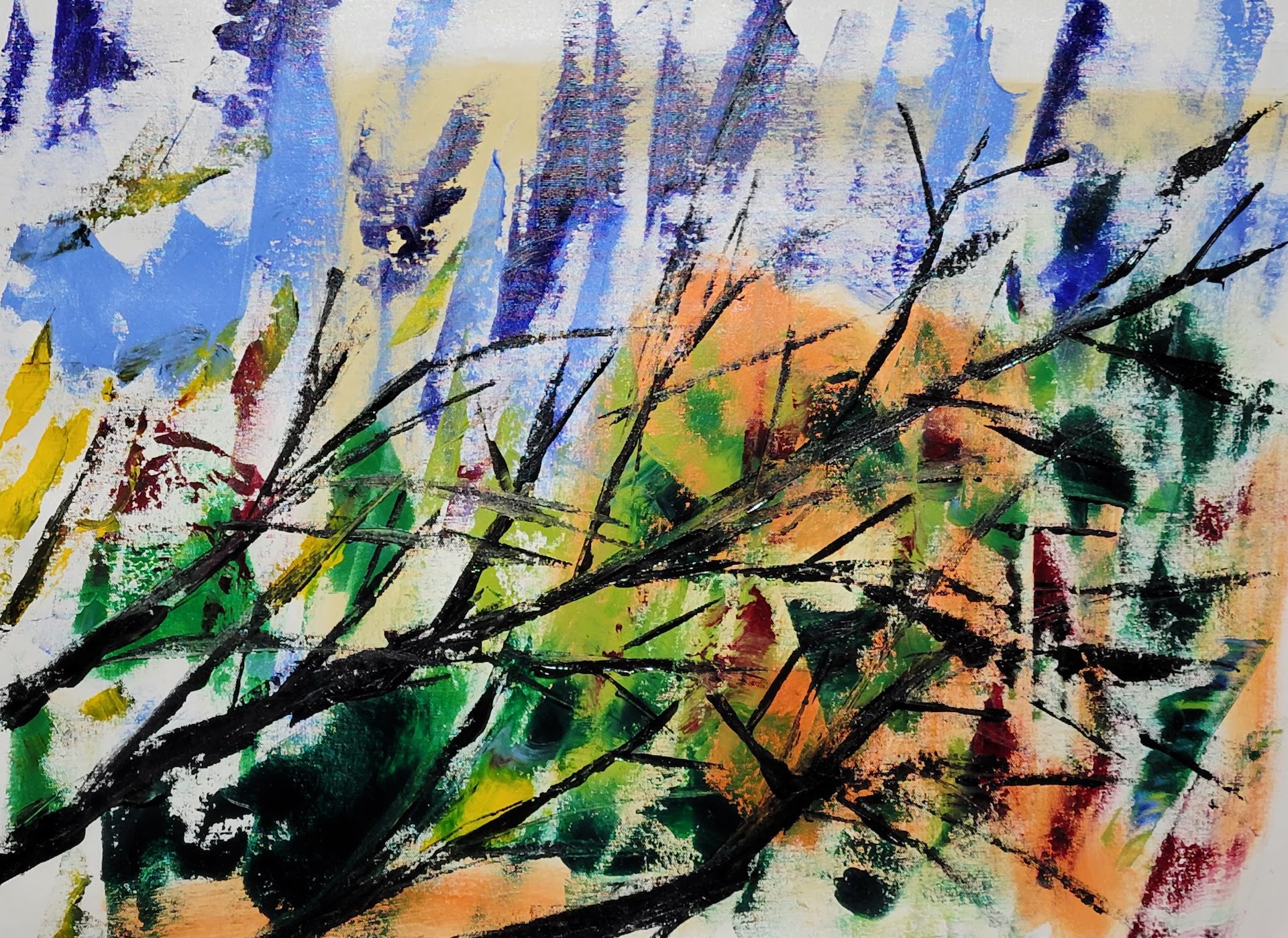
Roy Knight
Burning Trees
Inspired by: Robert Adams, Bulldozed Slash
oil on canvas
29″ x 21″
2023
Burning Trees represents man’s intrusion into the forest. Robert Adams’ silver print, Bulldozed Slash, starkly shows the destructive remains after logging against the background of regrowth in the untouched trees. The colors of yellow, orange, and red in my painting represent the death that fire brings, and green serves as the color of rebirth in the background.
Facebook.com/RoyKnight
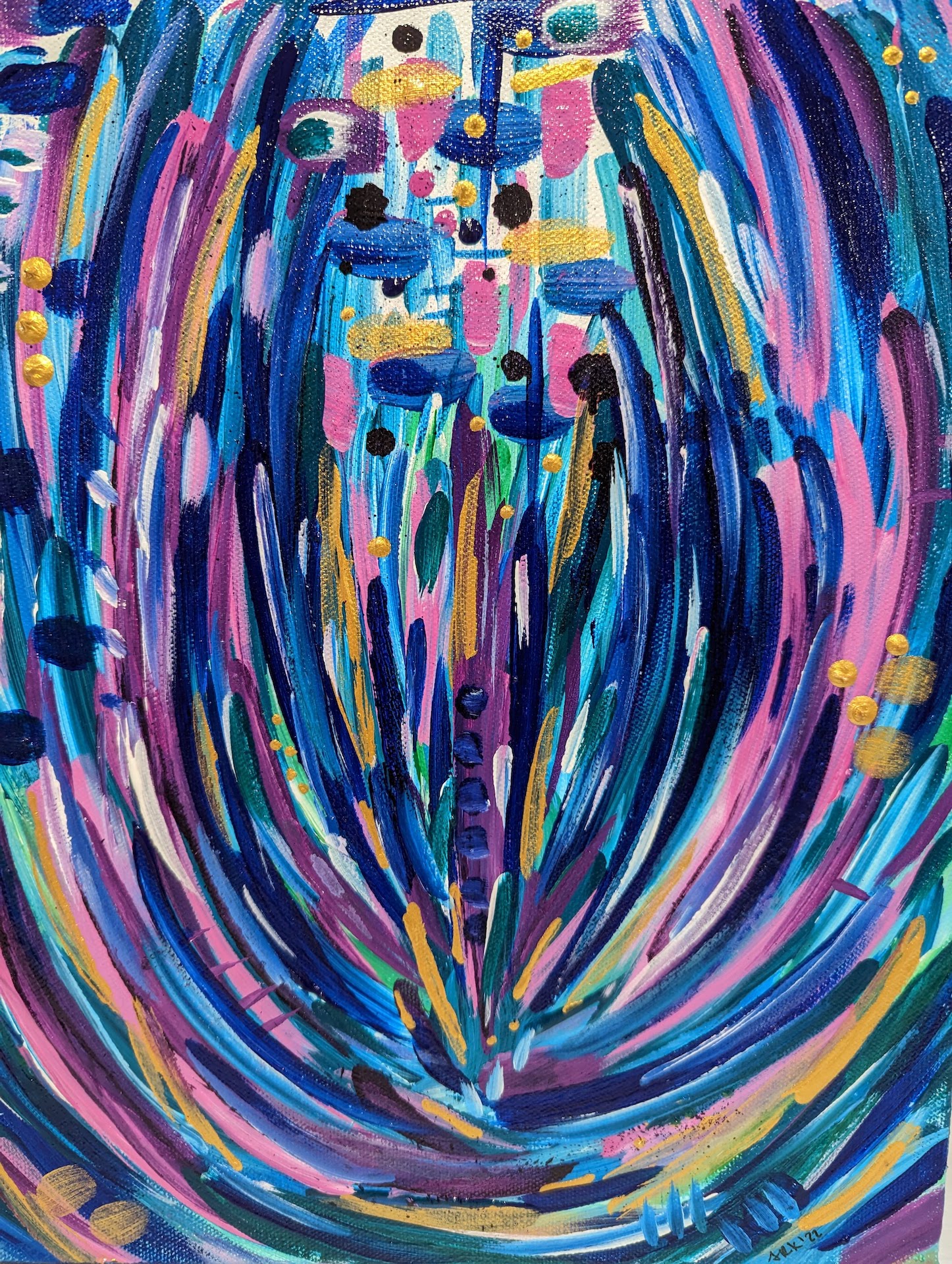
Stephanie Krist
Fire Nova
Inspired by: Harvey Sadow, Fire and Flood/Sacred Sites
acrylic paint on canvas
12″ x 16″
2022
Fire Nova was inspired by Harvey Sadow’s Fire and Flood/Sacred Sites. The interaction of the layers of glazes caught my interest, with the cracking and blending and unexpectedness of the relationship. In Fire Nova, I explored the layering and movement of paint and ink together and thought these two pieces would exist nicely together.
instagram.com/stephanie_ritacreative
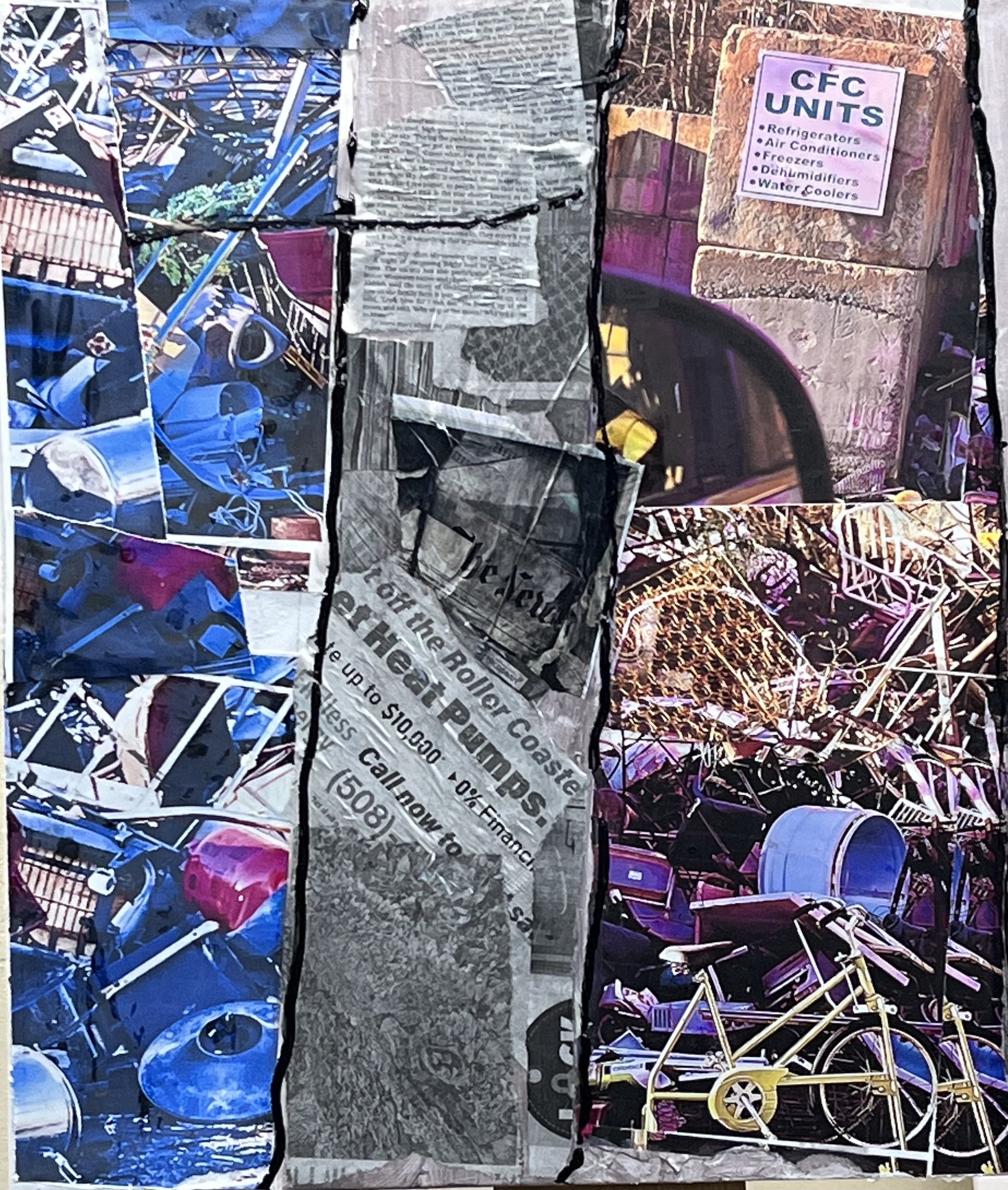
Teresa Lamacchia
Discarded
Inspired by: John Willis, Recycled Realities 1
acrylic paint, digital photographs, newspaper collage, oil paint sticks on canvas
24″ x 24″
2023

Joseph Landry
Dune Shack
Inspired by: Winslow Homer, Gathering Berries
multi media construction
22″ x 17″ x 11″
2017
“Dune Shack” is a 1/8 scale hyper realistic construction based on details of a number of historic Provincetown dune shacks. It relates to Winslow Homer’s “Gathering Berries” by depicting respectful coastal recreation—in “Dune Shack,” gathering beach glass rather than berries.
Stevie Leigh
The News
Inspired by: John Willis, Recycled Realities 1
upcycled denim scraps, metal zipper
22″ x 26″ x 2″
2023
After studying Recycled Realities 1 by John Willis, Stevie Leigh made a direct correlation to her own work which involves upcycling denim scraps from tailor shops that would have otherwise been sent to a landfill. This jacket is made from upcycled material, however the fashion industry is one of the top polluting industries in the world. This paradox is the same as the paradox of the newspapers in Recycled Realities being recycled but also causing pollution. Every Stevie Leigh design is named after a song title, and this design has the lyrics “Shut your eyes, but it won’t go away” from the song The News by Paramore which aptly relates to many people’s views on waste. They put trash in the bin and forget about it without thinking about the bigger problem of excess and consumption in our lives. This issue is explored in both Leigh’s and Willis’ work.
@ItsMeStevieLeigh
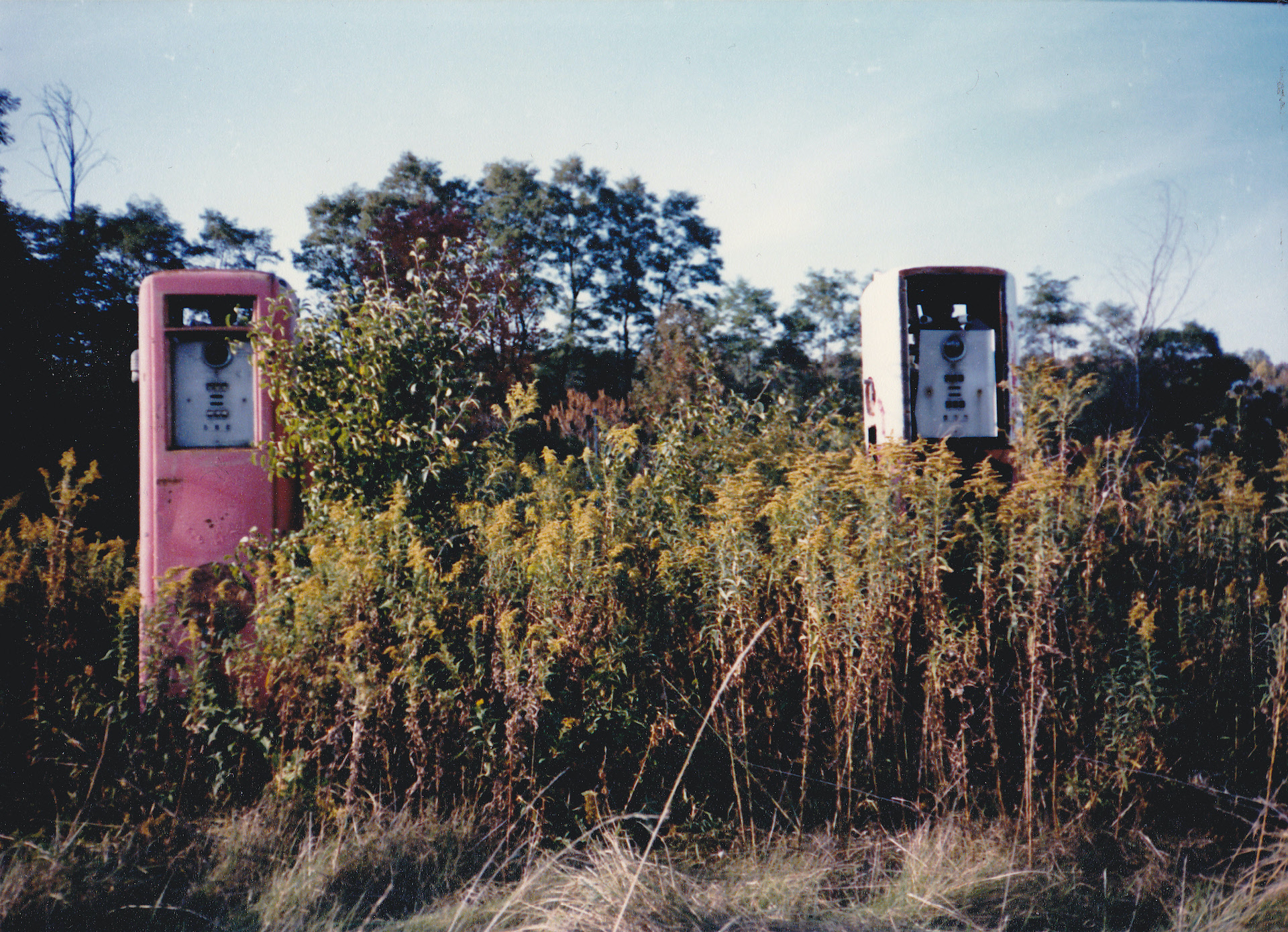
Edward Lilley
Fill Her Up
Inspired by: Robert Adams, Bulldozed Slash
photo. digital print.
11″ x 14″ (unframed), 20″ x 16″ (framed)
2022
Time passes. Things come and go. Do we notice? We still drive cars. What is the future? But nature and regrowth never stop.
Tedlilleystudio.com
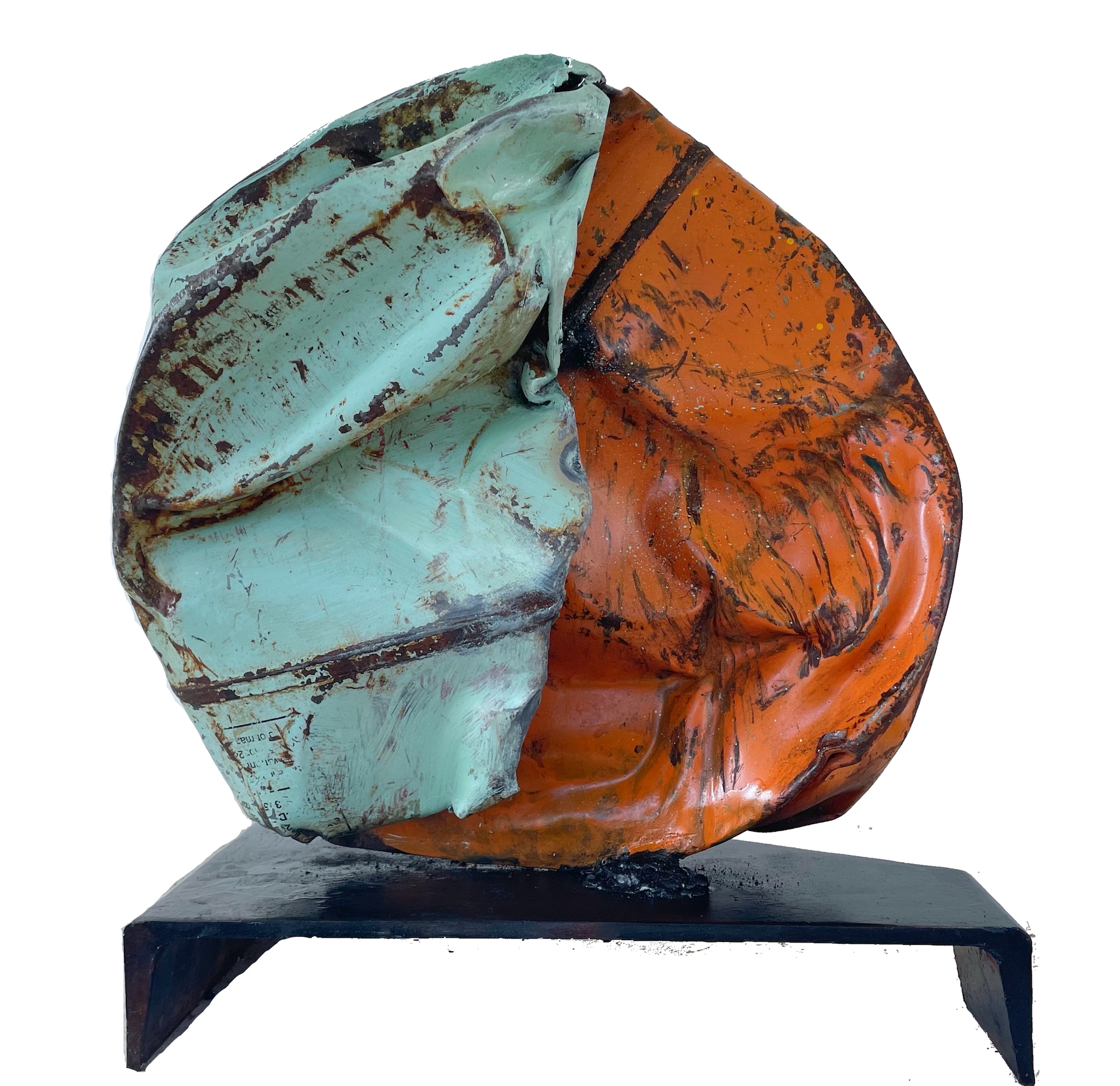
Madeleine Lord
Global Warming or Moldy Tangerine
Inspired by: Harvey Sadow, Fire and Flood/Sacred Sites
welded found steel
16″ x 14″ x 10″
2022
I worked on this piece a week before the Call from Fitchburg. It is simple in visual connection but took several days of pounding, welding and re-welding to create the image.
@madeleinelordmadimetal
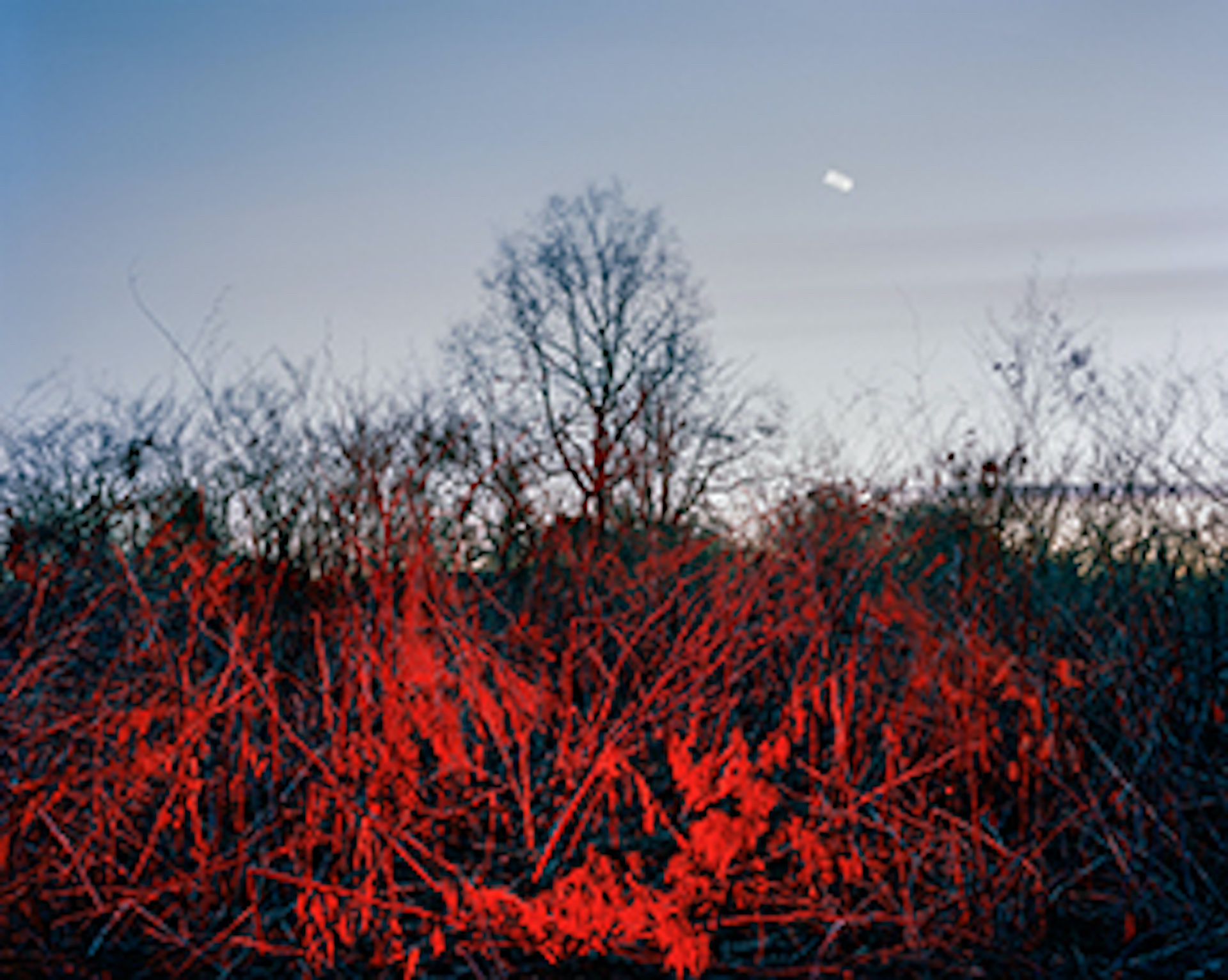
Caterina Maina
Red Dawn
Inspired by: Robert Adams, Bulldozed Slash Harvey Sadow, Fire and Flood/Sacred Sites
archival inkjet print from 4″ x 5″ color negative
28.5″ x 33.5″
2020
Combining abstraction and artificial lighting, I transform landscapes to produce feelings of uneasiness. I want the viewer to interact with the images and create their own responses to the environments I create. Through imagery and personal thoughts, I explore feelings of anxiety about the climate crisis and how we have detached ourselves from the underlying issue. This photograph, “Red Dawn”, simulates the act of burning in nature. Though it is a natural process environments go through, climate change has caused an imbalance within this system. Like Harvey Sadow’s “Fire and Flood/Sacred Sites,” I examine humans’ devastating impact on these cycles. I also relate my work to Robert Adam’s “Bulldozed Slash, Tillamook County, Oregon” by using developed woodland in my hometown of Rhode Island and reflecting on its environmental impact.
@4x5junkie
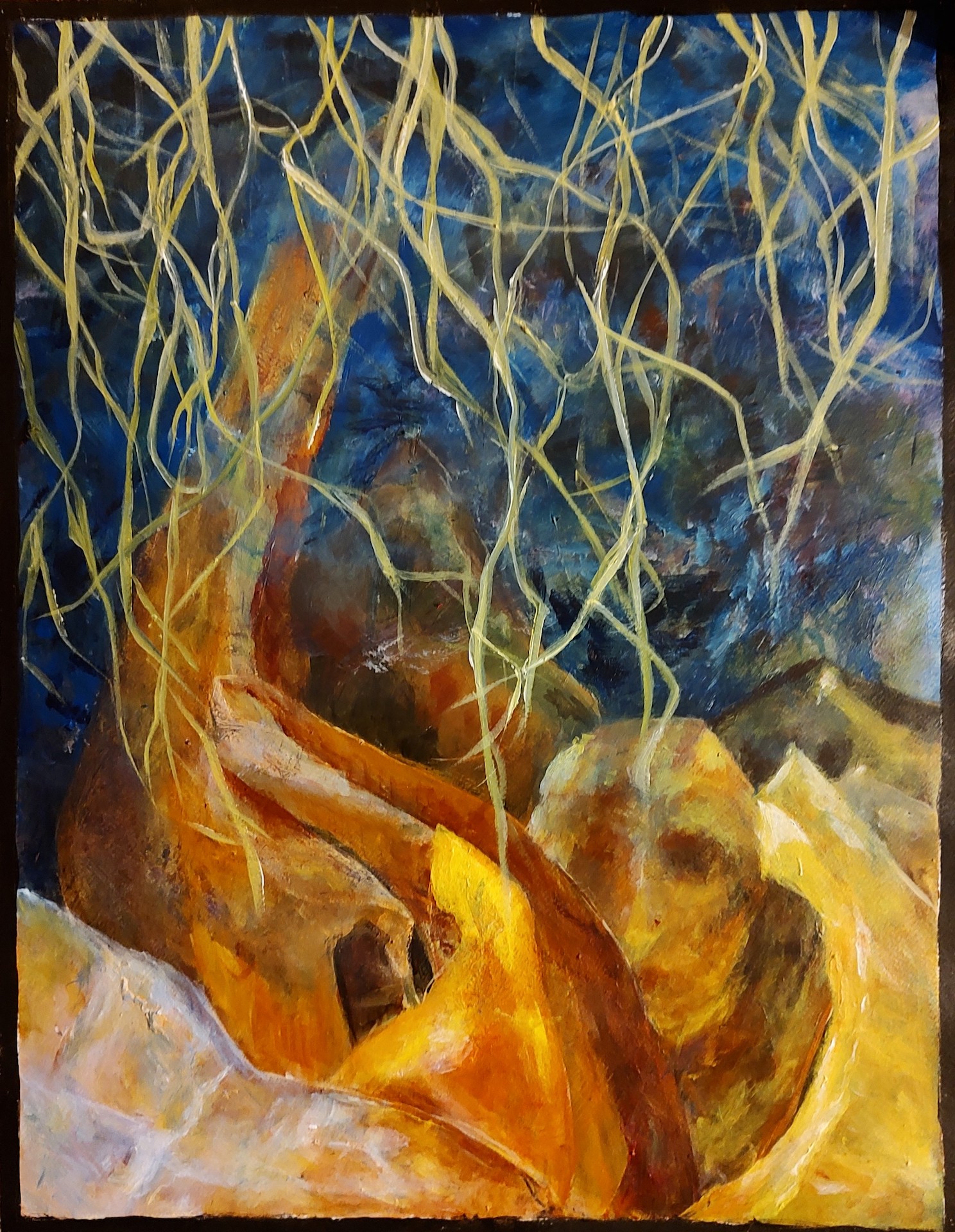
Kailey Mattus
Hot Knife
Inspired by: Harvey Sadow, Fire and Flood/Sacred Sites
acrylic
18″ x 24″
2023
This piece was created from maquette box of found and recycled objects. It is a close up view of broken glass, a bandana, and Spanish moss, which investigates the way the psyche transforms unfamiliar and abstracted shapes and colors into impactful and familiar images. The image was rendered from both life and imagination, and making it provoked memories of a place buzzing and full with vivaciousness, creatures, and noise.
@kaileymattus
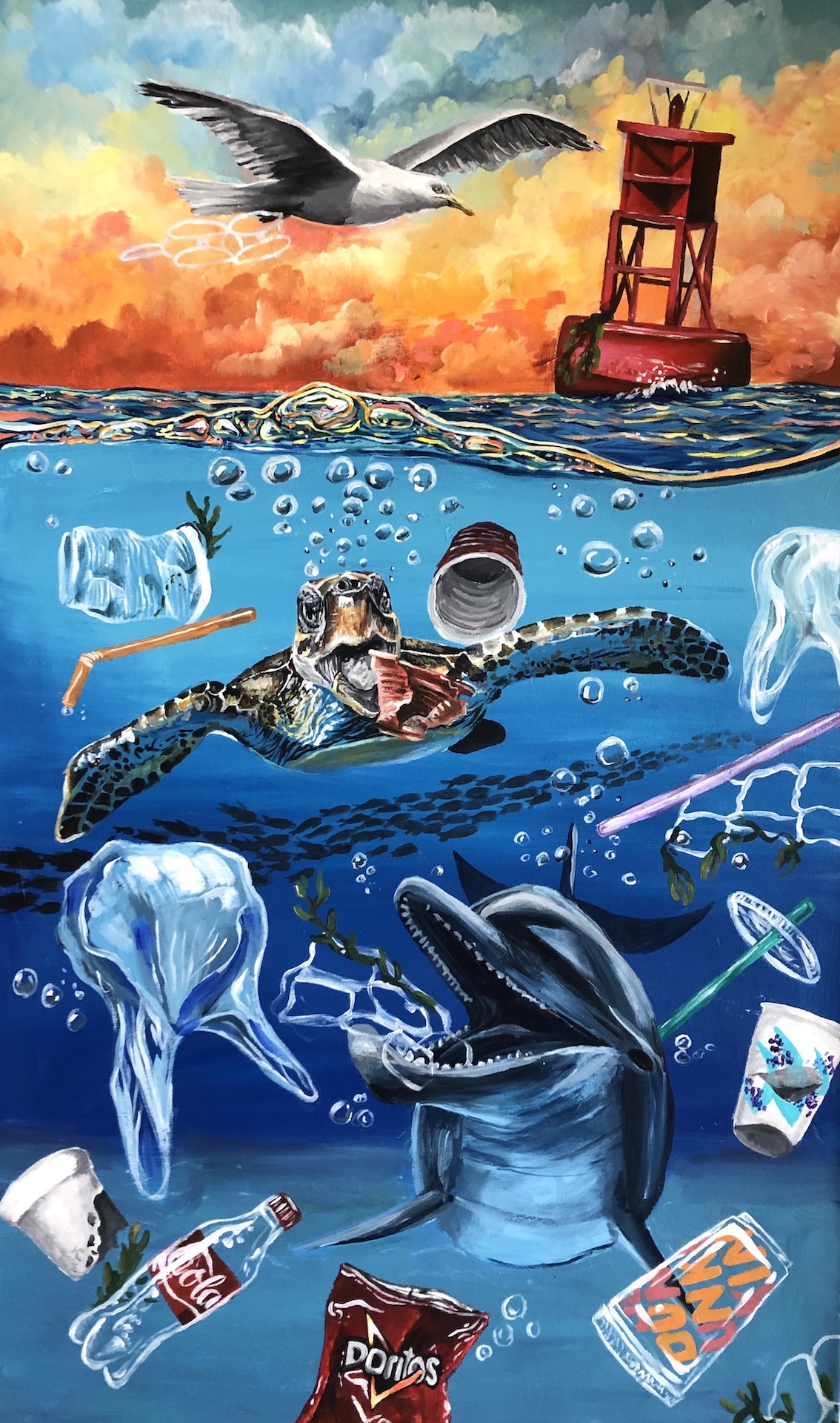
Serena McCarthy
Trashed
Inspired by: Evelyn Rydz, Gulf Pile
acrylic on canvas
40″ x 24″
2021
As a society we are so quick to see the beauty in the natural world but many times end up glazing over the real tragedies occurring on our Earth. At first glance, this piece appears to depict the beauty of our oceans, but upon further inspection, the beauty is overwhelmed by trash and pollution. If society continues to overlook the issue at hand, plastic bags will become the new jellyfish.
@serenamccarthy_ @studioxserena
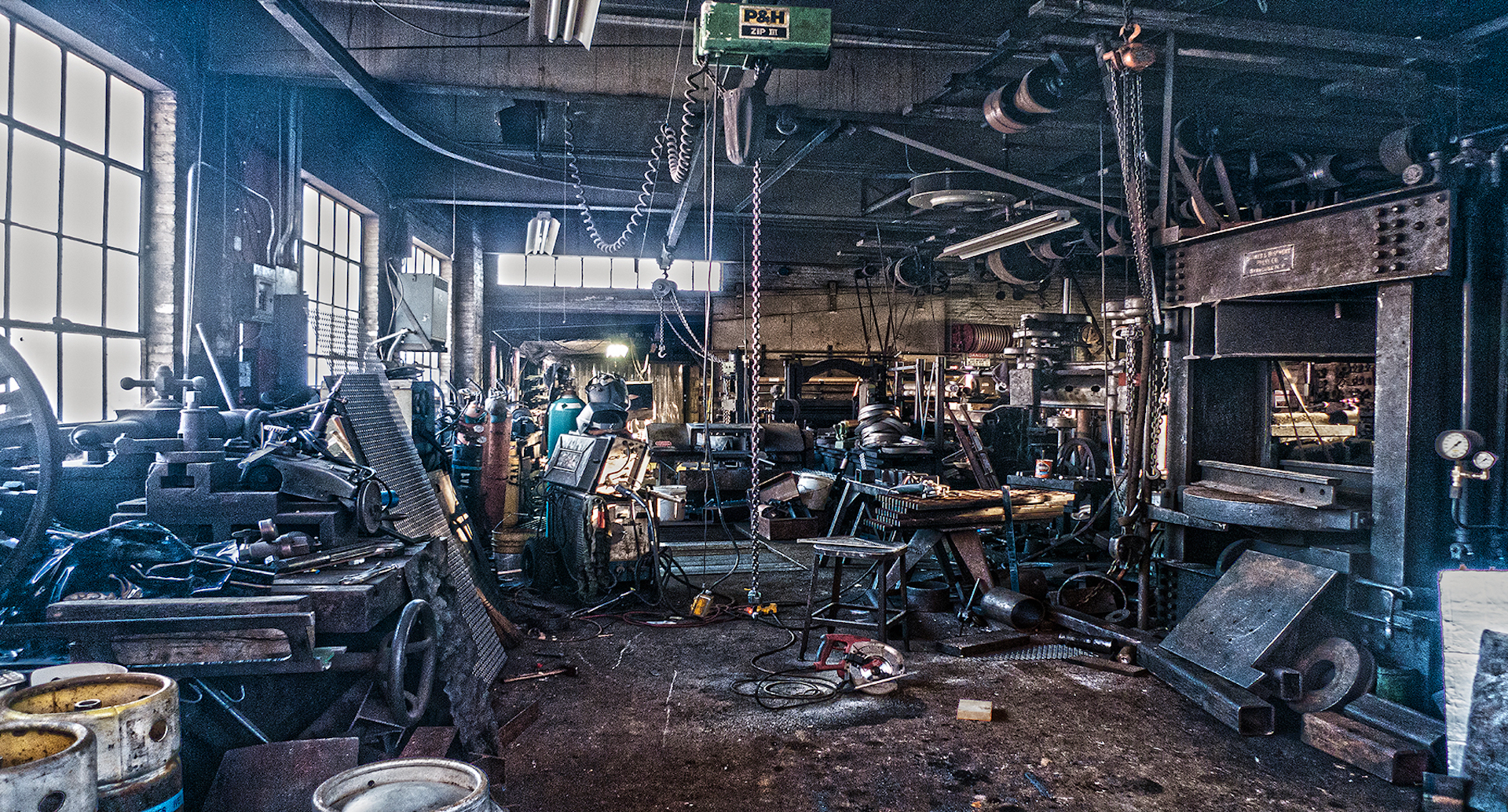
Vernon McClish
Machine Shop, Our Enduring Legacy
Inspired by: John Willis, Recycled Realities 1
inkjet photograph
32″ x 20″
2022
John Willis (American, b. 1976) Recycled Realities #1 has inspired me to submit this image. This image is my ode to a facet of our insensitivity to our environment, the constant destroying and transforming of earth’s treasures (iron ore, natural gas etc.) for our own selfish needs. “Machine Shop, Our Enduring Legacy” is a visual metaphor for our theft of natural resources and the un-erasable scars and objects that we haphazardly discard on our planet.

Julia Mongeon
Blueberries
Inspired by: Winslow Homer, Gathering Berries
mixed media
15.5″ x 12″
2023
“Blueberries” was inspired by Winslow Homer’s “Gathering Berries.” It is colorful rendition of the woman displayed in the far right of Homer’s piece. The light-hearted piece celebrates the relationship between humanity and nature.
@allie.and.jules
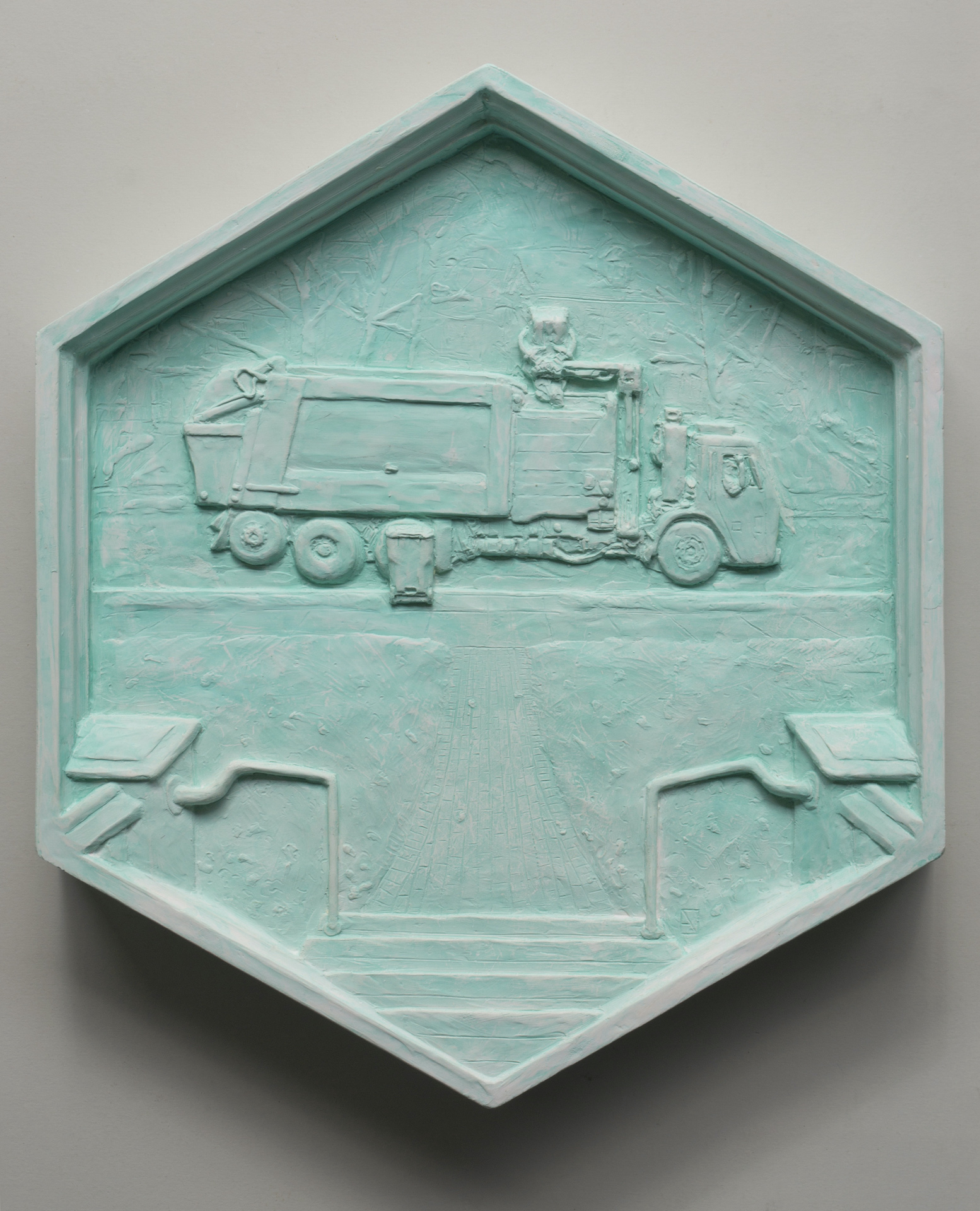
Evan Morse
Garbage Truck
Inspired by: Evelyn Rydz, Gulf Pile John Willis, Recycled Realities 1
plaster, pigment
18″ x 16″ x 2″
2018
This relief sculpture depicts an everyday scene, a garbage truck picking up household waste. Usually, once our trash is out the door we forget it ever existed, but it’s something that certainly impacts our environment. Where does our household waste go and how much of it actually gets recycled? It’s easy to take a garbage service for granted, but just having regular garbage pickup is a luxury much of the world goes without, and this leads to more trash entering the environment.
@morsesculpture

Elizabeth Murphy
Cultivation verses Corrosion: The Dichotomy of Two Strengths of Water
Inspired by: John Willis, Recycled Realities 1 Winslow Homer, Gathering Berries
oil paint
12” x 12”
2023
This image depicts the dichotomy of cultivation and corrosion; two powerful strengths of water. Water is deemed a critical necessity for creation and sustenance of life. The possibility of life existing is impossible without it. Humans’ control and redirection of earth’s water sources has a direct effect on the viability of life, both positive and negative. The top left of the painting represents cultivation as also shown in Homer’s Gathering Berries. In my painting cultivation is depicted with the lush vegetation on the bank of a pond and the ducks swimming in their natural environment. The bottom right portion shows the powerful corrosive force of water. The man-made, paint chipped water valve, humans attempt to control, divert, and manipulate the natural flow and course of water, is rusted, eroded, and damaged. As questioned in Willis’ Recycled Realities #1, what is the balance of the natural environment and human intervention?
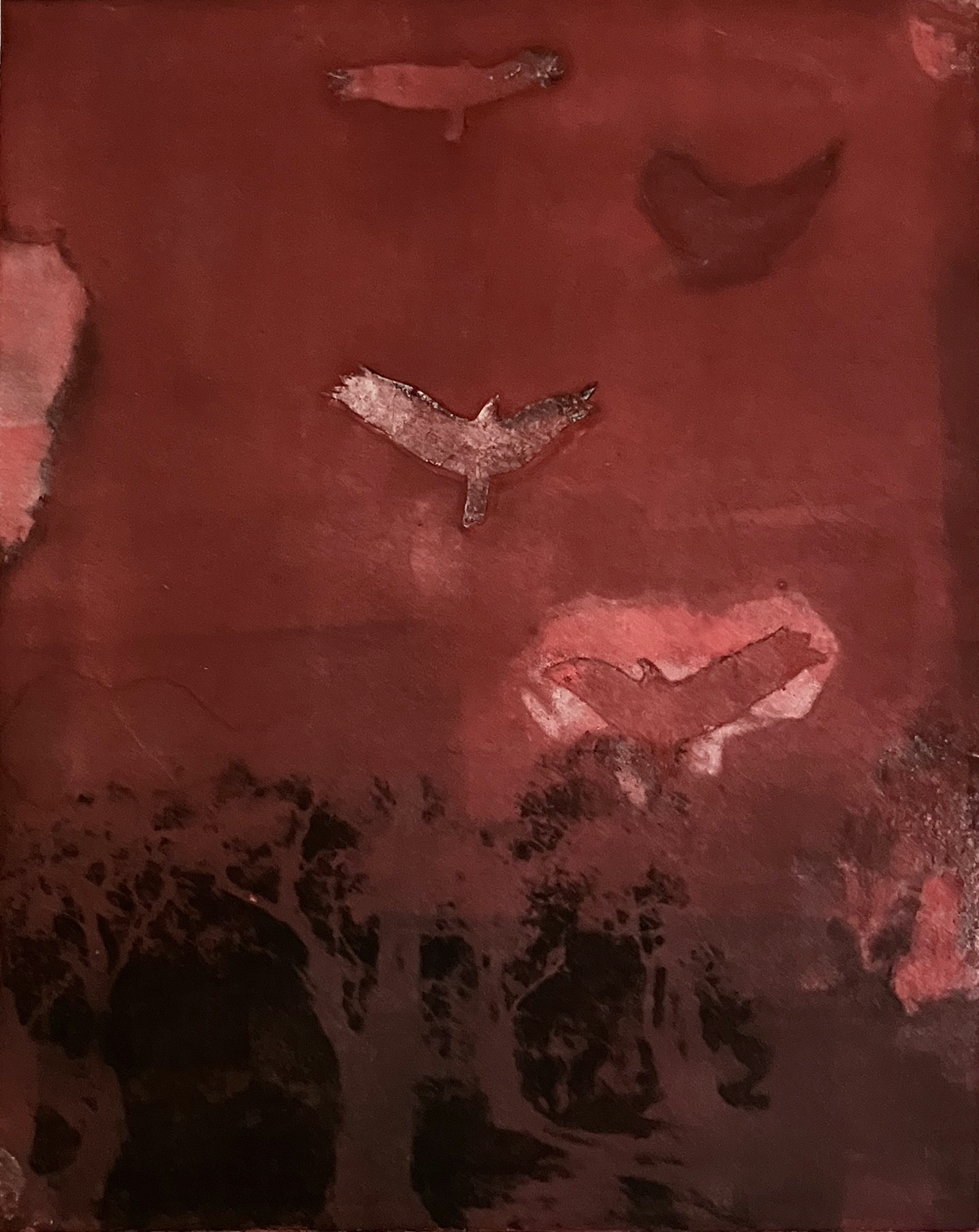
Kathy Murray
Fire Escape
Inspired by: Harvey Sadow, Fire and Flood/Sacred Sites
monotype
12″ x 14″
2021
I was attracted to Harvey Sadow’s piece Fire and Ice for both its subject matter and use of color. I chose to respond to the devastation created by wildfire along with the hopeful fact that most birds fly to safety. The color used in my monotype corresponds to a fire in the Berkshires in 2021 when many New Englanders marveled at the rose-colored smoky skies that blanketed the region.

Carrie Nixon
Concerned
Inspired by: Esther Solondz, Untitled (Rust Portrait)
recycled/reclaimed oils on translucent mylar
19” x 31”
2023
I was inspired by Esther Solondz’s “Rust Portrait” and her use of an organic substance to create a sensitive portrait. To approximate rust, I only used 4 recycled/reclaimed oil colors by Gamblin (plus a white): Torrit Grey, made of dry pigments collected from their factory air filtration system, and 3 Reclaimed Earth Colors-reddish, purplish, and dark browns-extracted from toxic coal mining residue in Appalachian Ohio. I eschewed the distancing factor of photography and painted the “Concerned” model, Tom, from life. First, this gave me a personal connection with him, as a young person whose future will be affected by climate change and environmental issues. Second, it led to a more trial and error process, with searching “pentimenti” lines and drips. This capricious painting process echoes the uneven human attempts to reclaim and heal our damaged environment.
#carriepainter1518

Bethany Noel
Over Troubled Water
Inspired by: Robert Adams, Bulldozed Slash Winslow Homer, Gathering Berries
acrylic paint, pencil, chalk pastel, and white gesso on canvas
30″ x 30″ x 2″
2021
I create emotional, subtly surreal large-scale acrylic paintings about my chronic migraine disease’s neurological symptoms as I experience them in nature. I experience a myriad of different neurological symptoms, including Alice-in-Wonderland-esque effects such as macroscopia, microscopia, and ocular aura. I developed my own adapted divisionism painting technique to represent what my neurological migraine optical distortion looks like and feels like. I seek out nature to find beauty and peace. What is intolerable in a CVS’s flickering florescent light is joy in the woods. I choose the eerie joy of my mirage-like otherworldly vision, finding hope and solace despite the pain that is my constant companion. I am choosing to see my world a la Winslow Homer, and ignore the realities of human industrialization, as exhibited in Robert Adams’s work.
@bethanynoelart
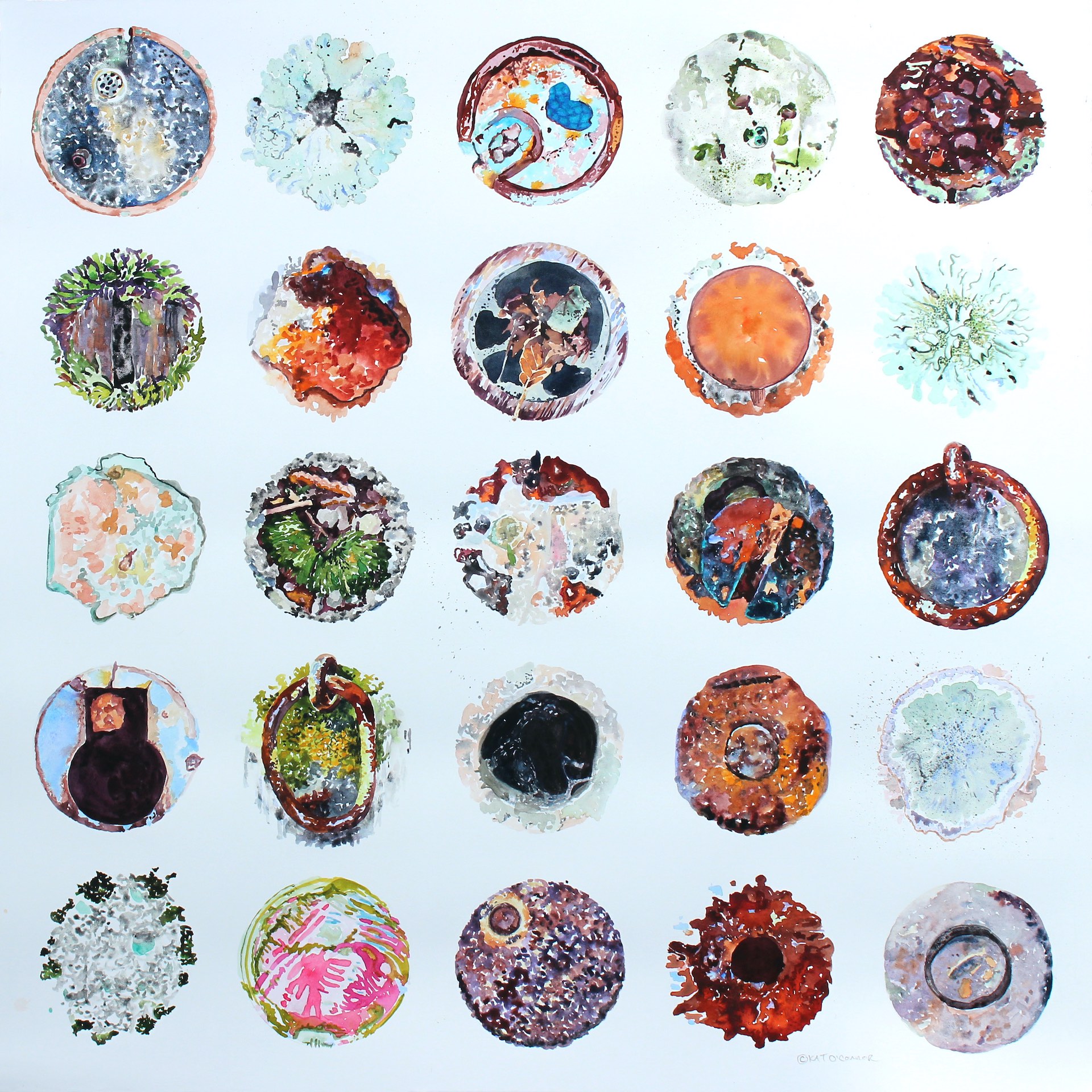
Kat O’Connor
American Reclamation Project
Inspired by: Robert Adams, Bulldozed Slash Unknown artist, Tapa Cloth
watercolor
22.25″ x 22.25″
2022
Robert Adams’ Bulldozed Slash, Tillamook County, Oregon hit home after seeing a trail that I often rode horses on destroyed. Trees were knocked over and piled up to use as temporary roads for logging equipment to move into an area that had previously been full of wildlife and beautiful, peaceful, spaces. Daily I walk through several neighborhoods in Worcester. Thinking of the repeating designs on the Tapa Cloth, I sought out circular shapes that evidenced nature’s tenacity in reclaiming space altered by human beings. Lichen and moss grow back on rocks moved to create walls and architectural elements. They cover and begin to erode walkways and macadam. Erosion from water, ice, wind, rust, and even human activity (vandalism, bullet holes, or changes in planned use) all indicate that nature is constantly in a state of reclaiming her space. American Reclamation Project is a small bit of hope for the future.
@katopaints
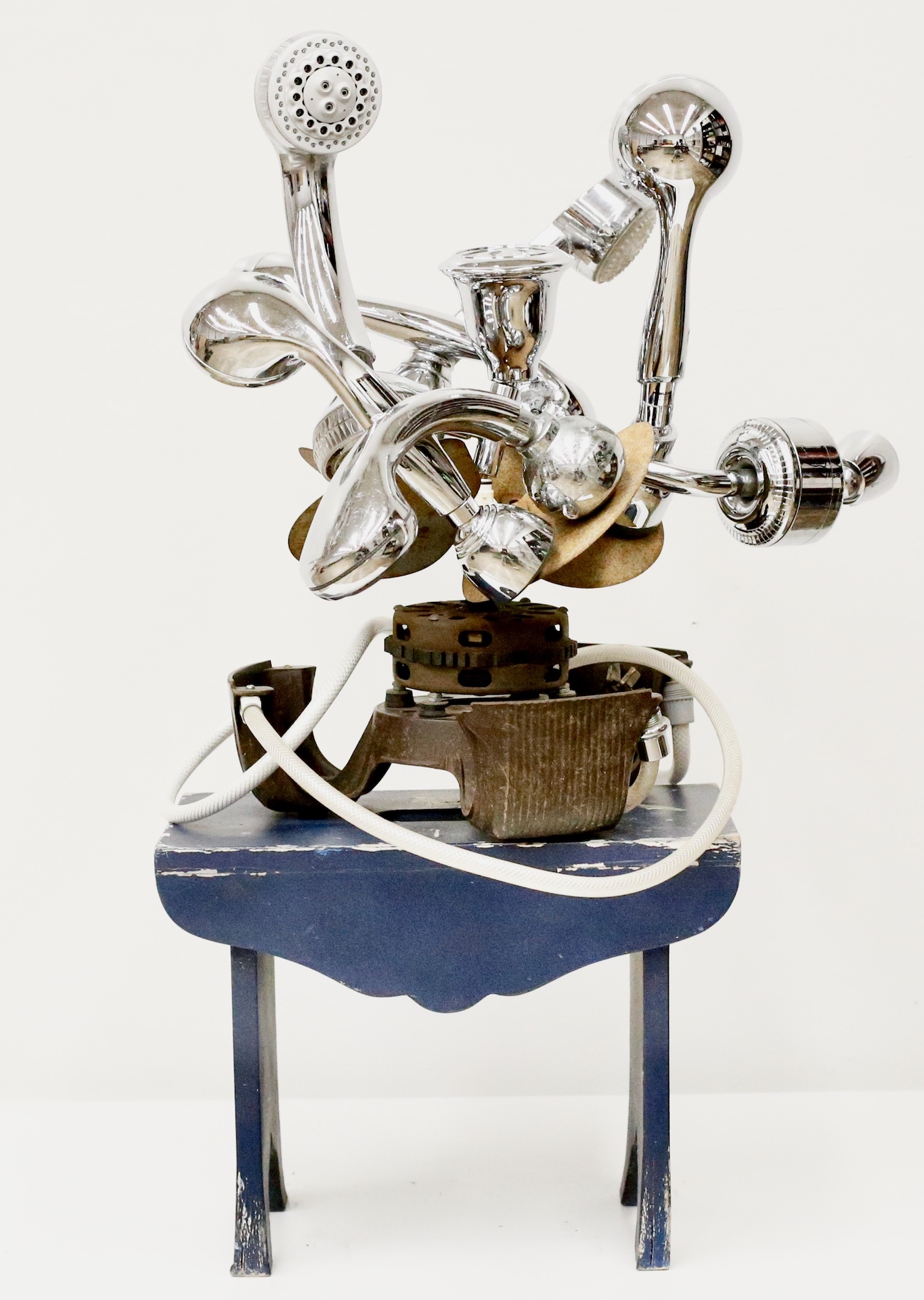
Emmanuel Opoku
Fountain
Inspired by: Unknown artist, Yellow Amber Beads Evelyn Rydz, Gulf Pile John Willis, Recycled Realities 1
found objects: shower pipe, shower heads, broken fan, and wooden stool
34″ x 25″ x 24″
2020
My sculpture explores the role of the found objects in contemporary art and in a global context. Growing up in a Ghana, there were electronics and appliance shops everywhere, but despite these sources for commodity exchange, there was always a belief that all broken objects still have value. As an artist, I incorporate this viewpoint into my practice. My nostalgic memories are transformed into a continuous experience with everyday objects, whereby I navigate issues of commodity and utility by weaving and joining objects. Inspired by Marcel Duchamp’s Fountain 1917 as well as Constantin Brancusi’s shiny sculptures, the piece investigates culture as a form of reflection. Inspired by Giacomo Balla’s Dynamics of Boccioni’s Fist, 1914, the work suggests my understanding of cultural dynamism as a diasporic artist, and how space and time shape identity. The use of sarcasm in terms of how Duchamp and Brancusi considered form, critically informs my sculptures.
@emmanuelmanuopokuart
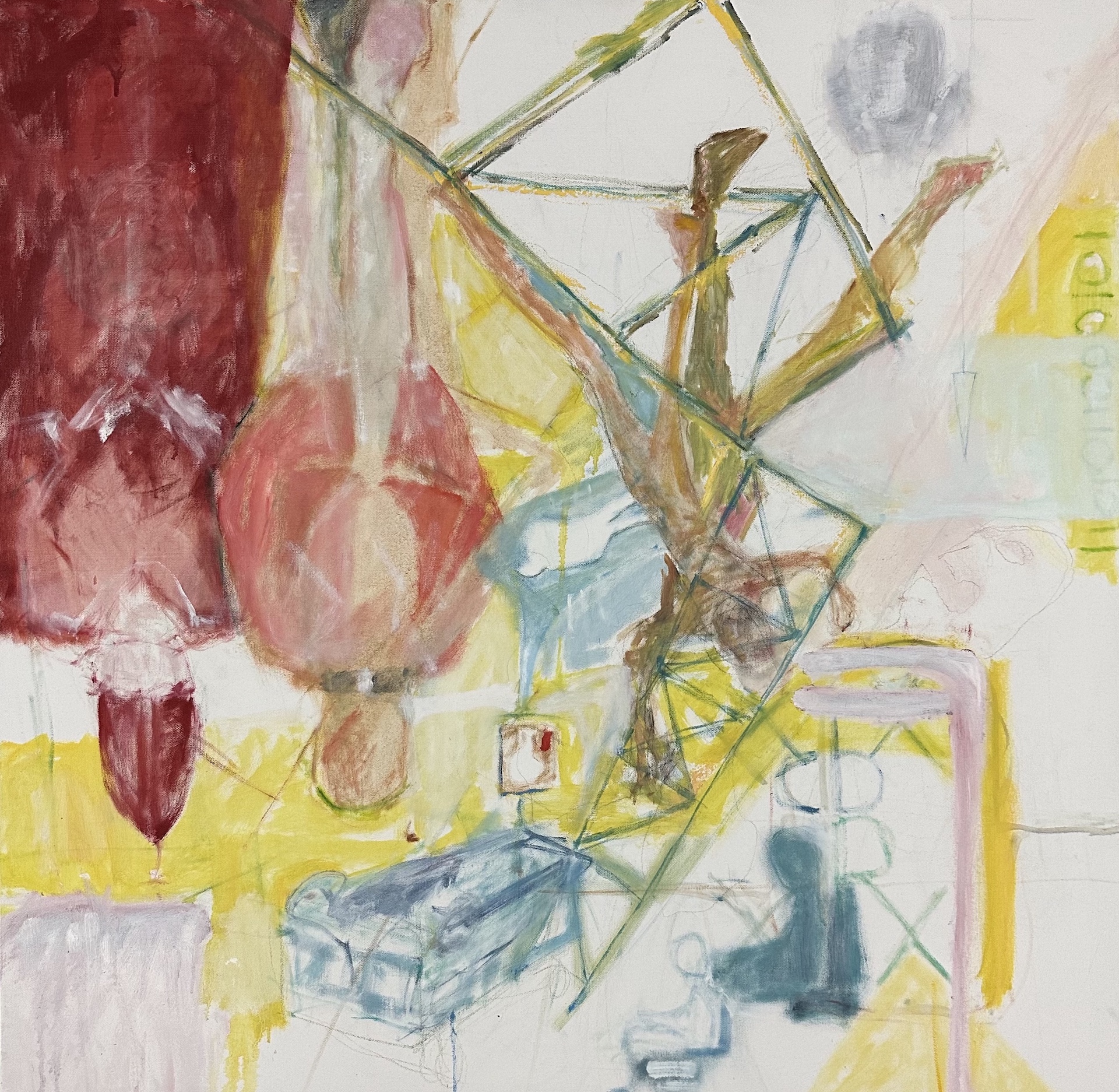
John Pagano
Untitled
Inspired by: Laura McPhee, The Blue Lagoon Robert Adams, Bulldozed Slash
acrylic on canvas
36″ x 36″
2022
An upside down world in so many ways.
johnpagano.info

Melissa Parent
Third Planet Blues
Inspired by: Winslow Homer, Gathering Berries Laura McPhee, The Blue Lagoon Harvey Sadow, Fire and Flood/Sacred Sites
mixed media collage on wood
12″ x 30″
2023
Third Planet Blues is a work that explores the beauty of Earth’s natural life cycles, decay and rebirth into renewed resources. These resources are essential to our existence and maintaining the biodiversity which makes the third planet so special. This work depicts the feeling of nature’s constant motion showing both power and fragility in a delicate balance of rejuvenation.
@mparent_art
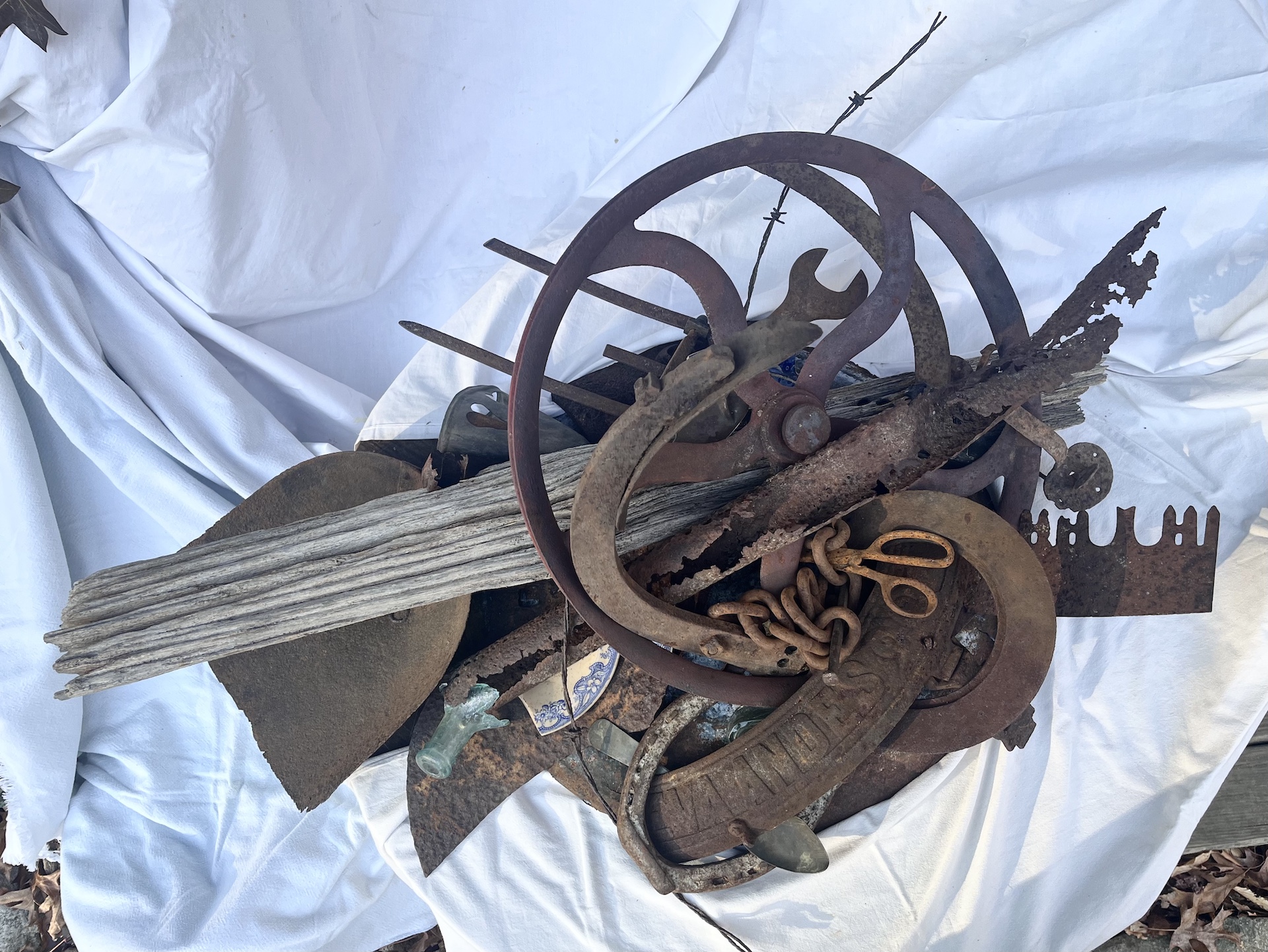
Stephen Paulson
At the Old Homestead
Inspired by: Evelyn Rydz, Gulf Pile
found objects, metal, wood, glass, ceramic
36” x 15” x 26”
2023
Evelyn’s work reminded me of abandoned homesteads in New England where household items and farm tools are scattered about and are gradually reclaimed by nature.
Instagram, stephenpaulson48

Anju Pillai
Gasp!
Inspired by: Evelyn Rydz, Gulf Pile
acrylics and repurposed plastic waste on panel
17” x 21”
2023
In my artwork titled ‘Gasp!’ I have used acrylics and repurposed plastic waste to create a powerful visual representation of the overwhelming amount of plastic pollution in our oceans, much like the artwork titled ‘Gulf Pile’ that inspired me. In my mixed media piece ‘Gasp!’, I portray a woman drowning in an ocean surrounded by plastic waste and rotting fish. My intention is to evoke a strong emotional response in the viewer, encouraging them to reflect on their consumption and disposal habits and convincing them to contemplate and change. ‘Gasp!’ serves as a poignant reminder of the impact of our actions and a call to individuals and society to take responsibility for protecting our oceans and the life within them; otherwise all of us will be left to ‘Gasp’ for air!
www.Instagram.com/artaesthetics_by_anju_pillai
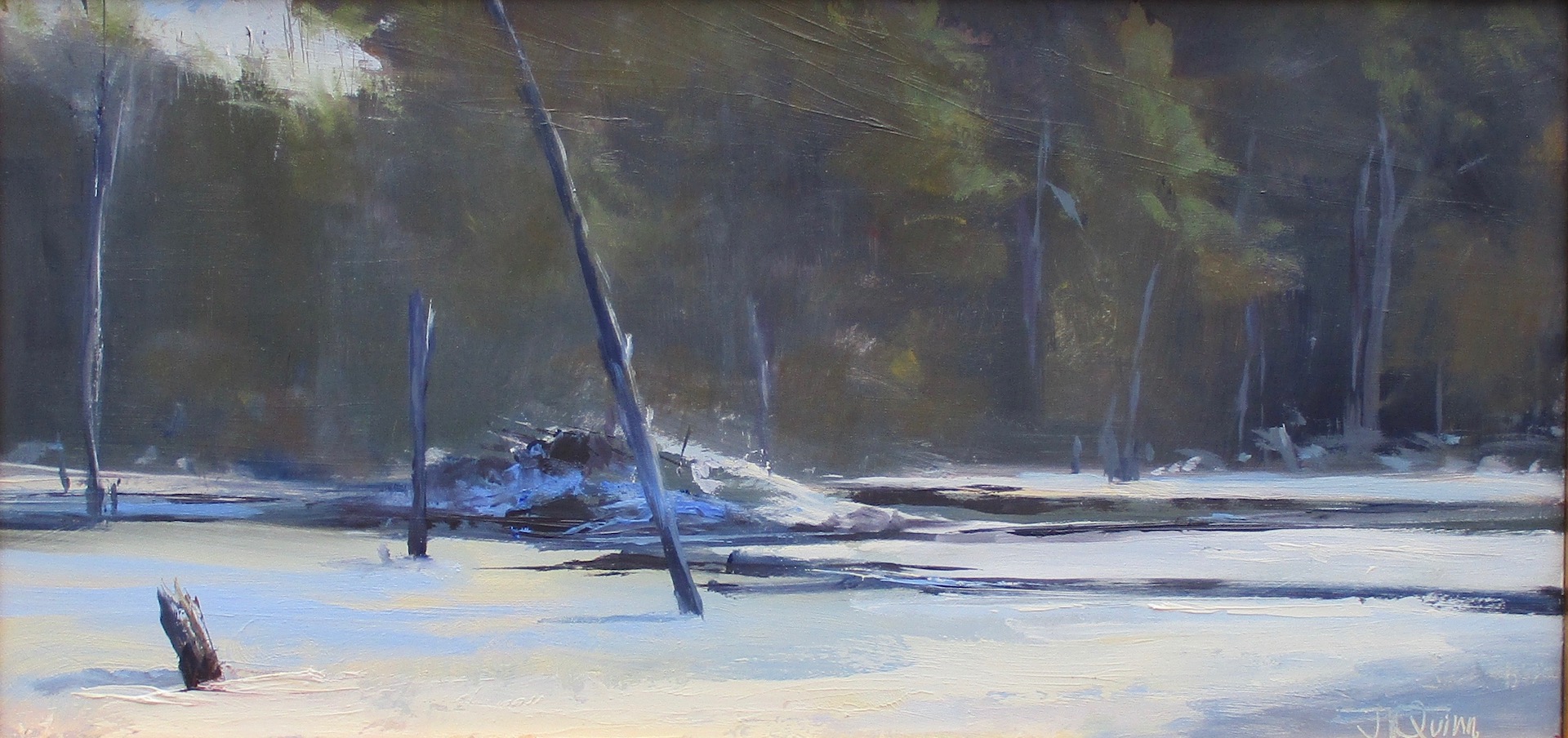
Joanne Quinn
Beaver Hut/December
Inspired by: Robert Adams, Bulldozed Slash
oil on panel
6″ x 12″
2022
I have chosen to write about the photograph, Bulldozed Slash, by Robert Adams and compare the photo’s documentation to the oil painting Beaver Hut/December. By comparison, the two images are both of the natural world and both landscapes of woodlands. Contrasting the two pieces, the Beaver Hut/December shows a peaceful scene of a beaver lodge, an animal’s creation made from wood and mud. Bulldozed Slash shows a scene of trees bent and broken, knocked down, man made destruction. Humans, of all the creatures on earth, continue to cause the most destruction to the environment. Beavers on the other hand, continue to enhance and create wetlands that help enhance water quality and create homes for a variety of wildlife and plant species. Their work is a sign of good ecosystem engineering. I feel that there is more of an awareness of environmental issues now and hope they can be addressed.
@joannetalbotquinn

Carolyn Quirk
Summer Morning
Inspired by: Lionel Reinford, Winter in New England
oil and acrylic, crushed glass beads, and medium gloss on gesso watercolor paper
9″ x 12″
2020 – 2021
My Response is to Mr. Lionel Reinford, Winter in New England. I met Mr. Reinford several years ago, my Aunt and Uncle had purchased several of his paintings and I admired his work. Mr. Reinford had an exhibit at the Fitchburg Art Museum featured in the Main Gallery, I also was in an exhibit in the community gallery that ran along side of the main gallery, I went to see Mr. Reinford’s exhibit and in his show there was a smaller exhibit and it was a portrait that he had been commissioned to do of my Uncle Bernie surrounded by other paintings that were meaningful to him, my uncle had passed and Mr. Reinford had remembered him in his show and I thought how cool is that. So my response is to the detailed work of Winter in New England with a abstract of a Summer Morning in July.
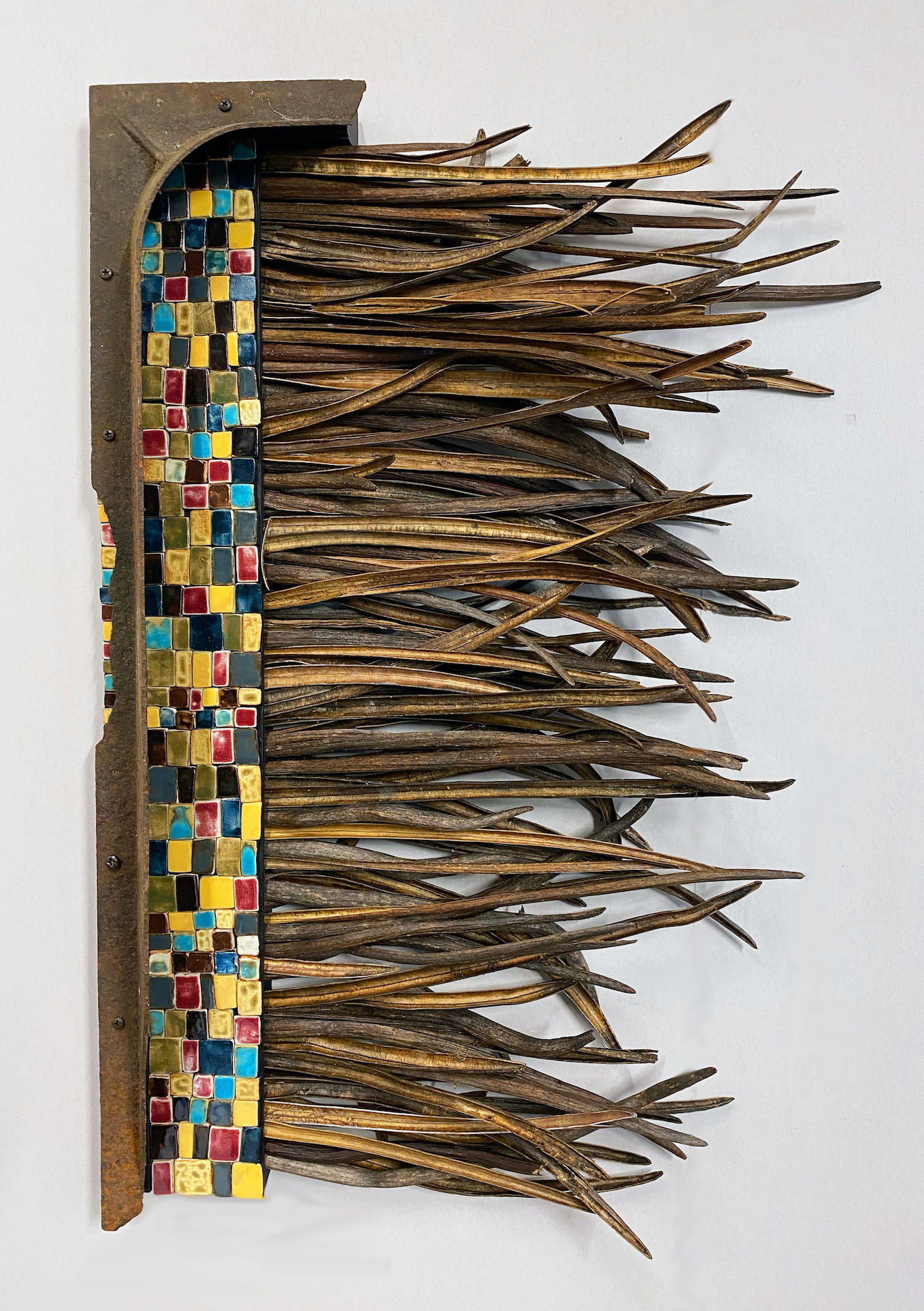
Danielle Ray
Reseed II
Inspired by: Harvey Sadow, Fire and Flood/Sacred Sites Laura McPhee, The Blue Lagoon Esther Solondz, Untitled (Rust Portrait)
found metal, ceramic tile, catalpa seed pods
32.5″ x 22″ x 6.5″
2022
Nature offers us extraordinary examples of growth and decay. This cyclical process has always fascinated me, Reseed II is a work that encapsulates our human response to this paradox. This piece incorporates three aspects, human trash, our ability to manipulate natural material, and ephemeral organic debris. The use of a piece of corroded found metal from a trash pit in the woods provides the framework. Ceramic tiles made from clay, a malleable organic material that can be manipulated, fired, and preserved forever, are matched with catalpa seed pods that have already split and shed their seeds. Together these elements are transformed into a new creation, one that celebrates growth and acknowledges decay– I see this juxtaposition as crucial to our evolving existence.
@danielleraystudios

Erin Reid
ODE TO MOON #18: JUNE 12, 2022, Hayesville, NC
Inspired by: Lionel Reinford, Winter in New England
watercolor on paper
11″ x 14″
2022
I planned to break from painting. Not long after I accepted to put down the brush, I began a new cycle during the peak of a lunar journey and at the end of one very personal. I sat for days watching the strawberry moon rise from behind the hazy blues of the Appalachian Mountains. I couldn’t believe how fast she rose, and ran for a sketchbook. To be in harmony with nature feels like an immense privilege at a moment in time when it’s survival is in dire straits. Despite the impact of our destruction, the way the moon always seems to rise feels like a promise. Like Lionel Reinford, I am in the pursuit of capturing nature’s generosity. These paintings are my promise back to nature — to remember it’s serenity. A moment to pause. A breath boundless in time.
@erinreidart
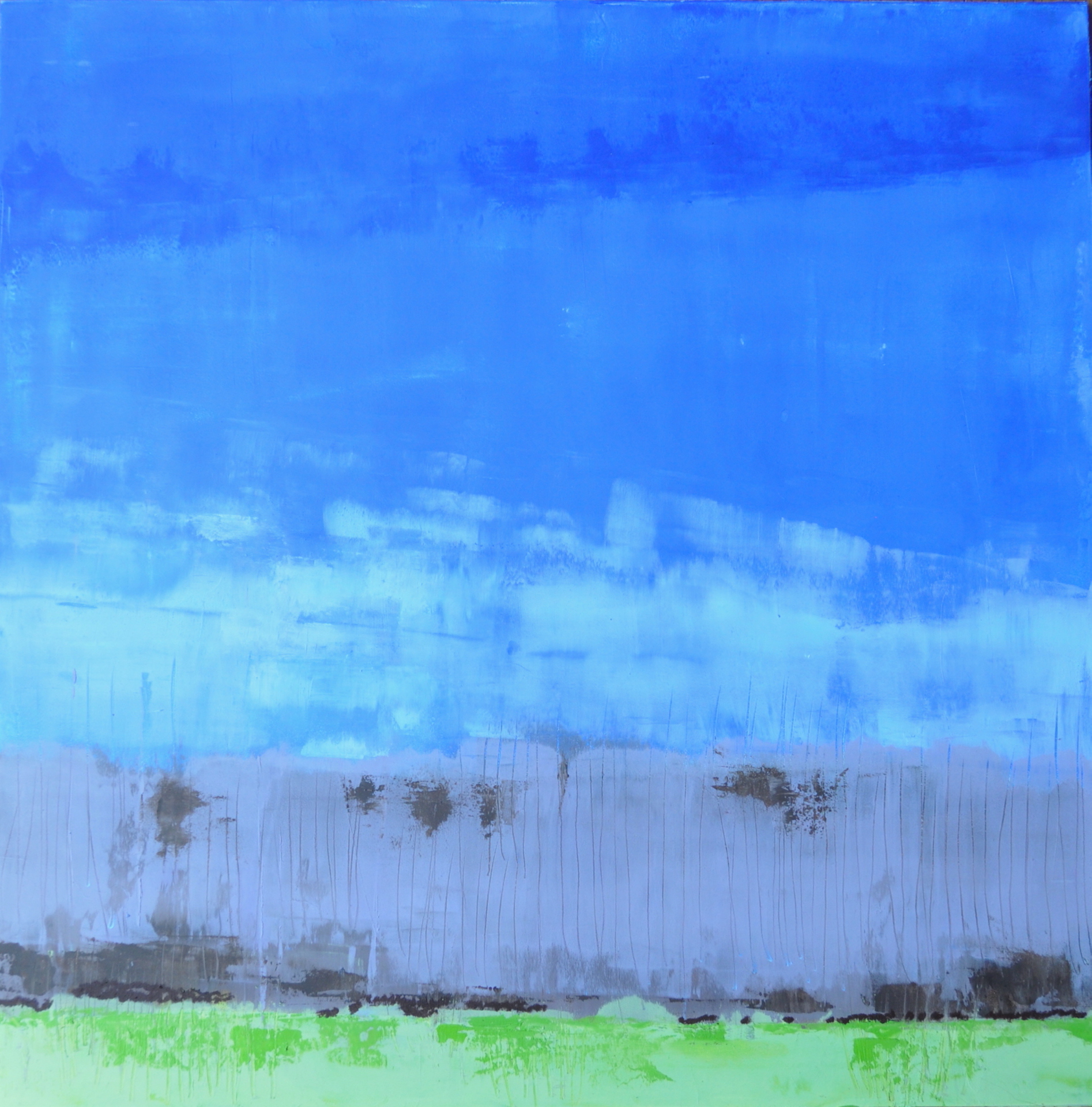
Karen Reid
Mid Spring
Inspired by: Robert Adams, Bulldozed Slash
oil and wax on panel
16″ x 16″
2022
This piece was inspired by daily walks. When winter is just starting to turn into spring. “Rebirth.” Fresh, new, early marks that begin to grow after the long destructive season that winter can bring.
@karenreid4012
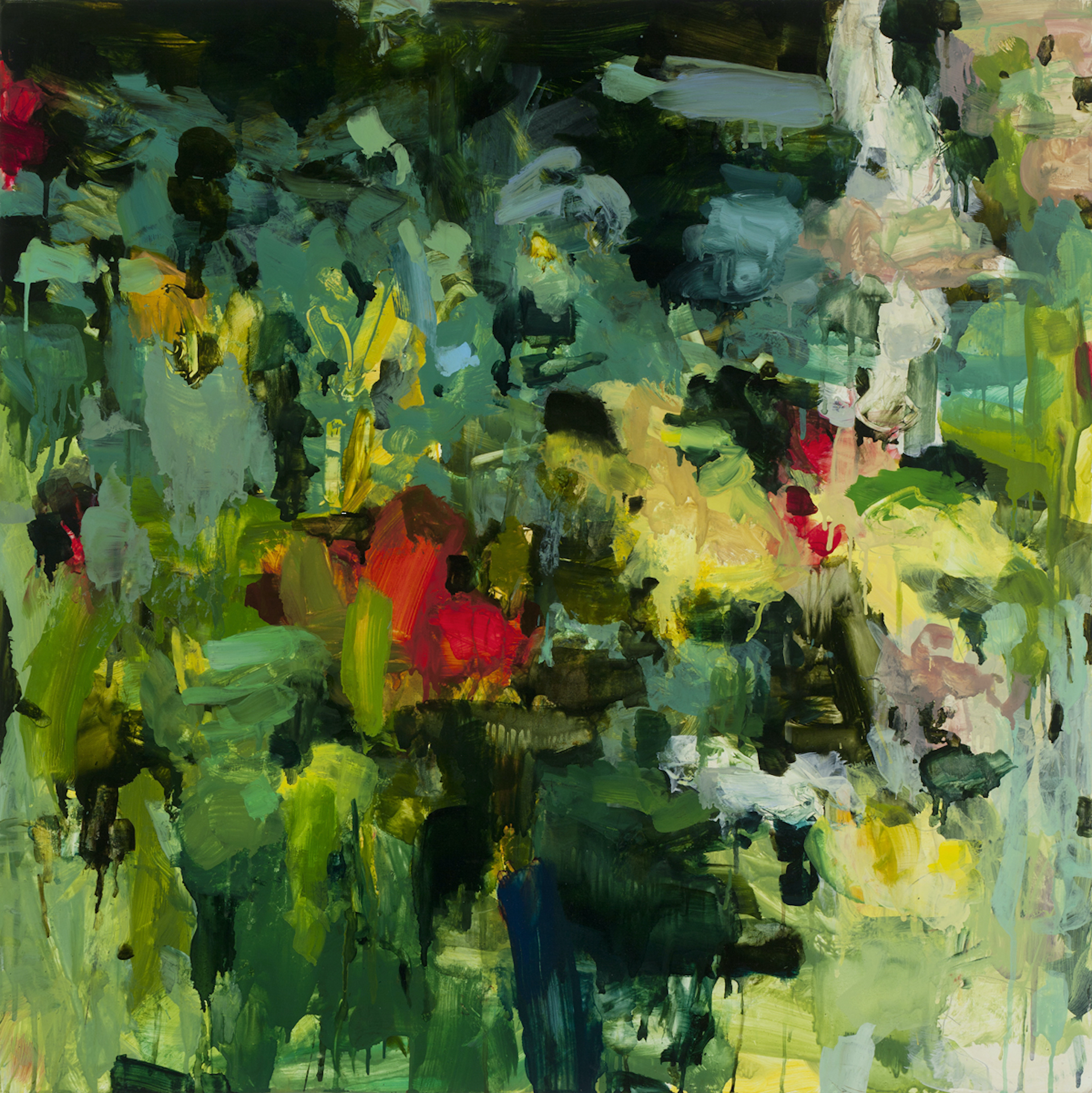
Robin Reynolds
Into the Forest We Go
Inspired by: Robert Adams, Bulldozed Slash
oil on panel
36” x 36”
2021
Robert Adam’s photograph, Bulldozed Slash, Tillamook County, Oregon encases the very essence of why I paint outside in nature. The complexities are found everyday, between the beauty and the disasters that are ongoing everywhere. The simple question, “Will my garden grow?”, takes on more significance as the climate crisis has yet to be taken as a real threat to the environment. As a plein air painter, I embrace this notion of beauty and create luminous, lush layered surfaces manipulating paint to create a dance between abstraction and representation. In my painting, Into The Forest We Go, I was fascinated with the depths of the dark woods against the beauty and fragility of the burgeoning lilies. The yellow flowers encapsulated my vision of hope through their growth, bloom and decay.
@robinreynolds7259
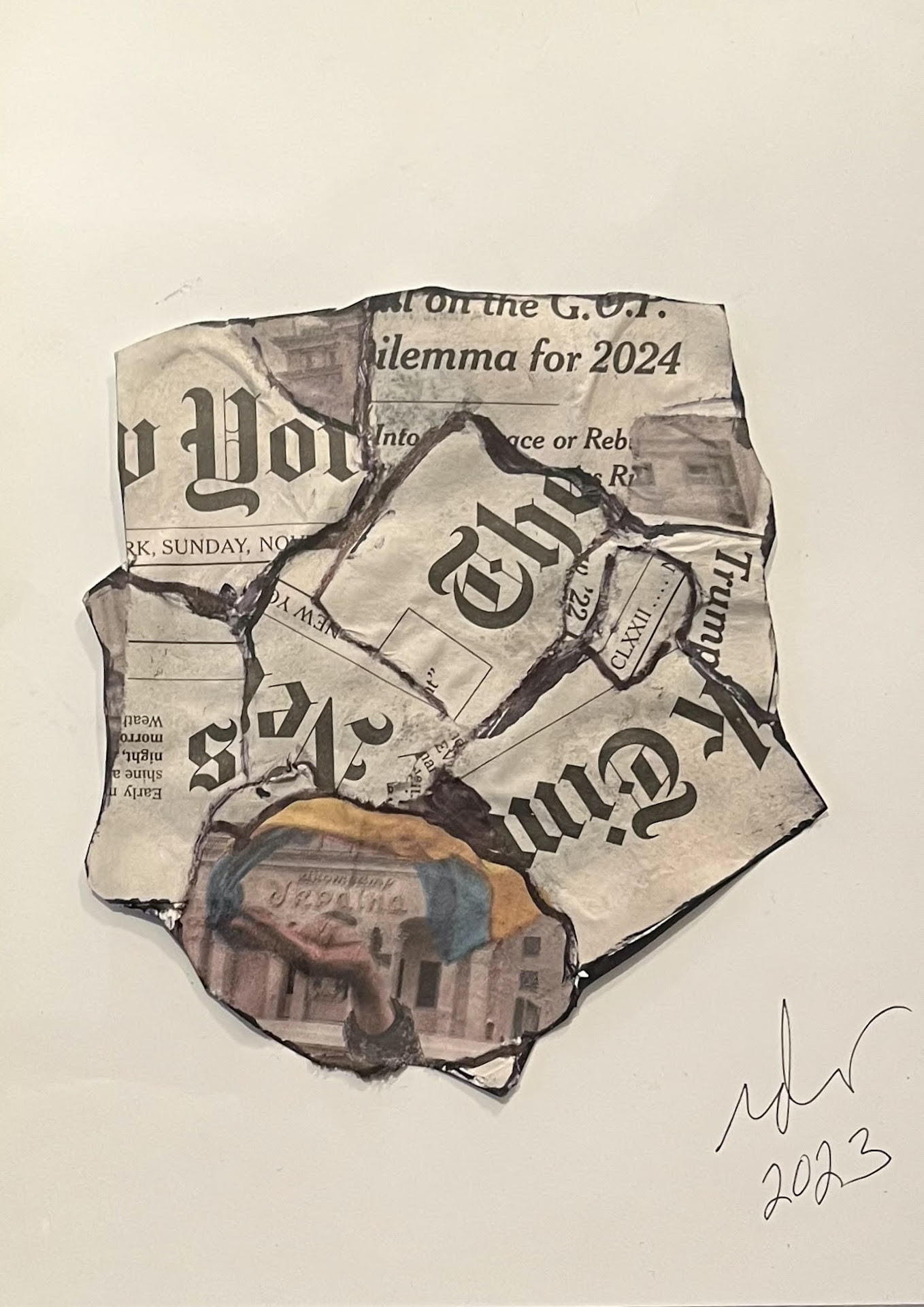
R. Douglass Rice
Who Decides What We know?
Inspired by: John Willis, Recycled Realities 1
collage on paper
8.5″ x 10″
2023
Every day millions of events happen in the world. News media organizations have to decide which of these are, in their opinion, the most important to inform their audience. These decisions are based on their positions in society, their biases, and reasons for publicizing these events. Since the early nineties, I have been making collages using the Masthead and headlines from the New York Times to emphasize how we get our information and who controls that information decision.
Instagram: @r_d_rice
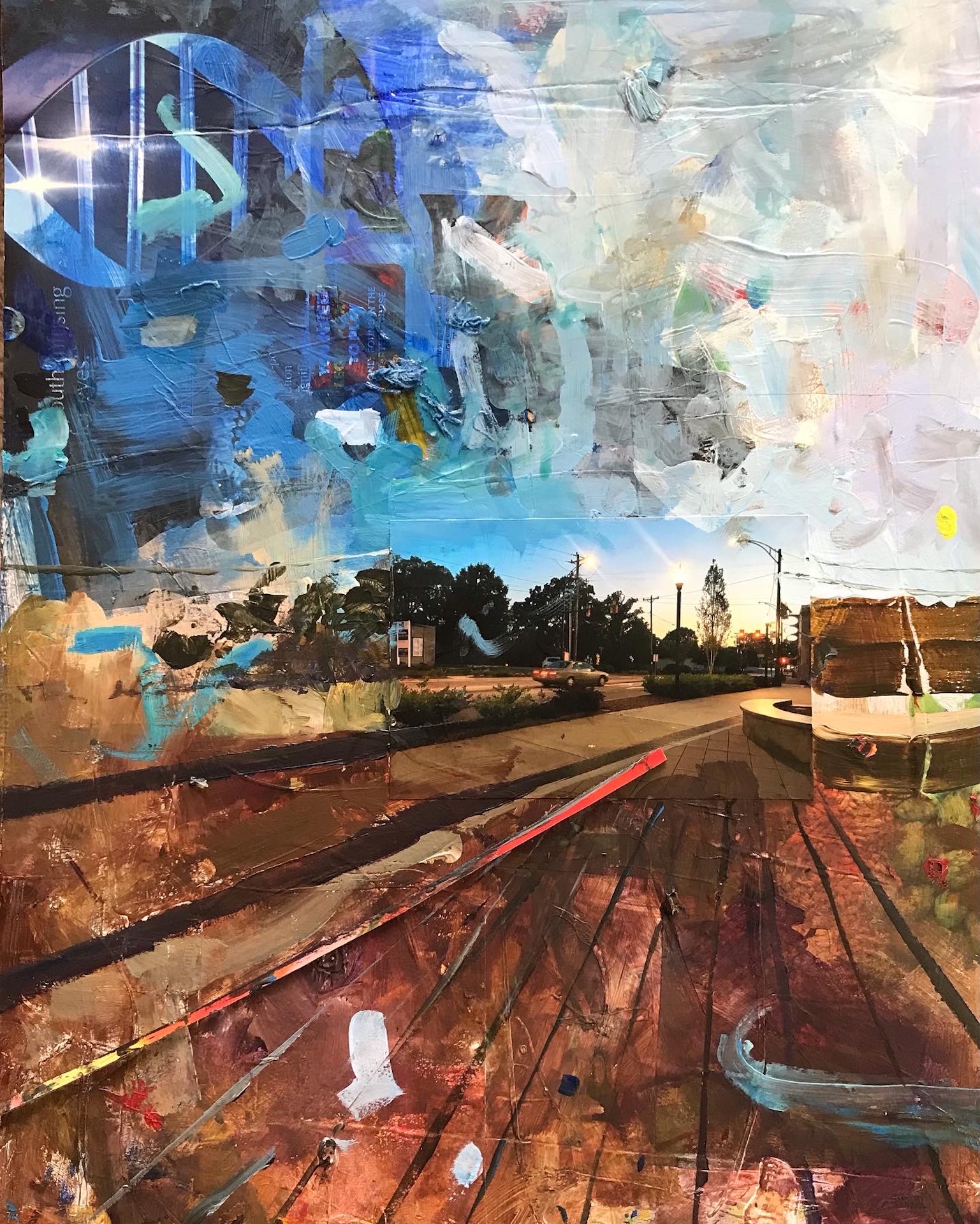
Rachel Rinker
Perspective Is(n’t) Everything
Inspired by: Laura McPhee, The Blue Lagoon Evelyn Rydz, Gulf Pile
collage and acrylic on foam board
14″ x 20″
2023
My piece, Perspective Is(n’t) Everything, is a result of the accumulation of materials – my process is heavily rooted in upcycling and reducing studio waste. This speaks to Evelyn Rydz’s Gulf Pile, and a desire to showcase an awareness of consumer waste culture’s impact on the environment. I use intense layers in my work to accentuate history and human connectedness from an array of sources, whether incorporating junk mail, old house paint, or discarded party decorations. Though our sensibilities are quite different, Laura McPhee’s stunning photograph of The Blue Lagoon, Svartsengi Geothermal Pumping Station, Iceland is also inspiring and uplifting. Her composition is stunning and I relate to her sensibilities in highlighting this landscape that shows a very human cross over of natural and manmade infrastructure. I include the dichotomy of these things in my painting here, where elements of infrastructure sink into the larger landscape cut in half – sky, ground.
@rachelrinker1
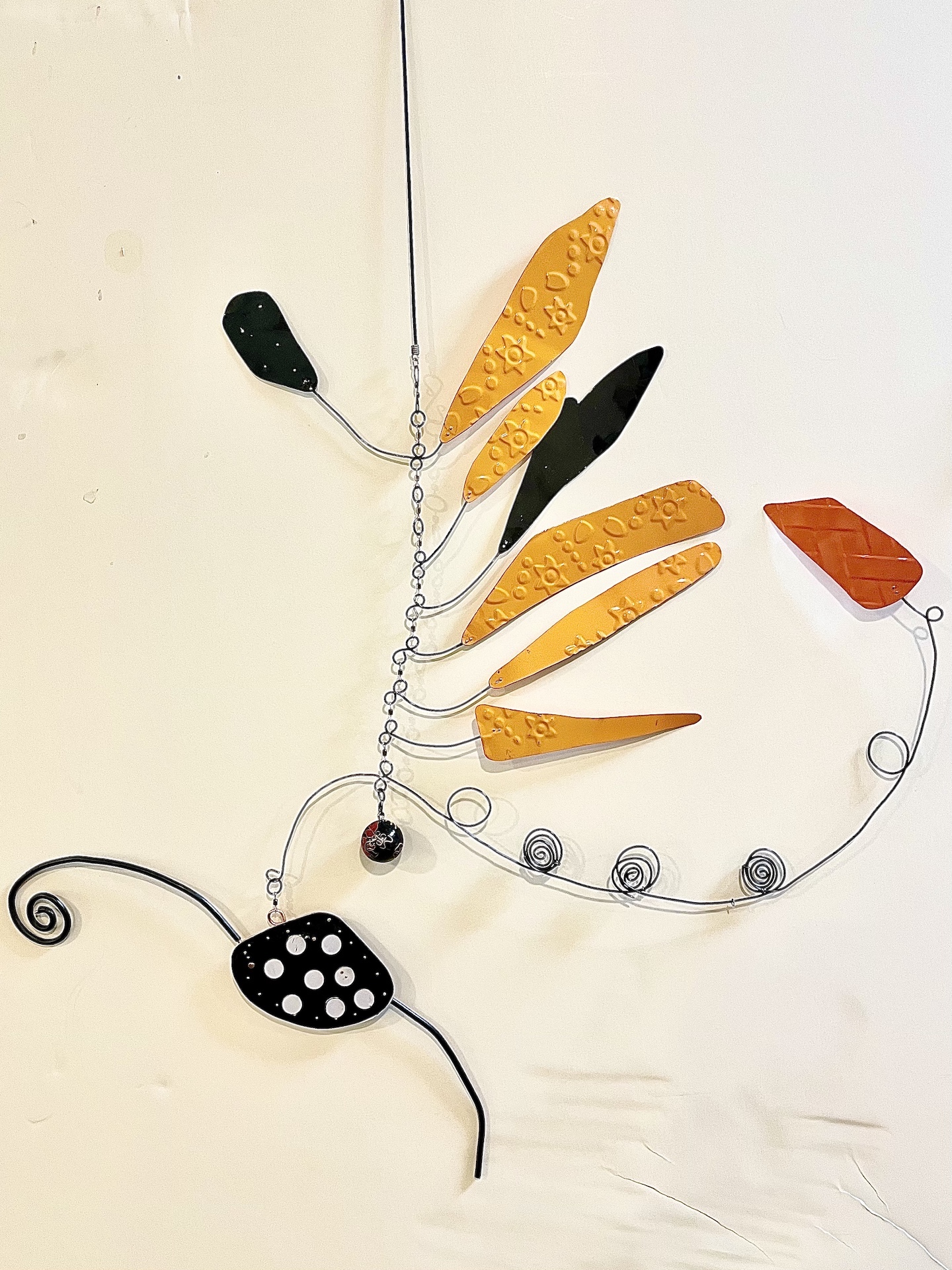
Donna Rudek
Monarch: Recycled Rebirth in the Face of Extinction
Inspired by: John Willis, Recycled Realities 1
recycled decorative tin and wire mobile
24” x 30”
2023
Willis’ work examines how recycled material can be used to highlight our destruction of our environment. Here I use repurposed metals to remind the viewer that we are destroying the environments of species by using GMO development of corn that allows farmers to destroy the butterfly’s food source. Monarchs are one of the most widely recognized symbols of the fifth mass extinction on our planet and a potent reminder that we have direct agency in this phenomenon.
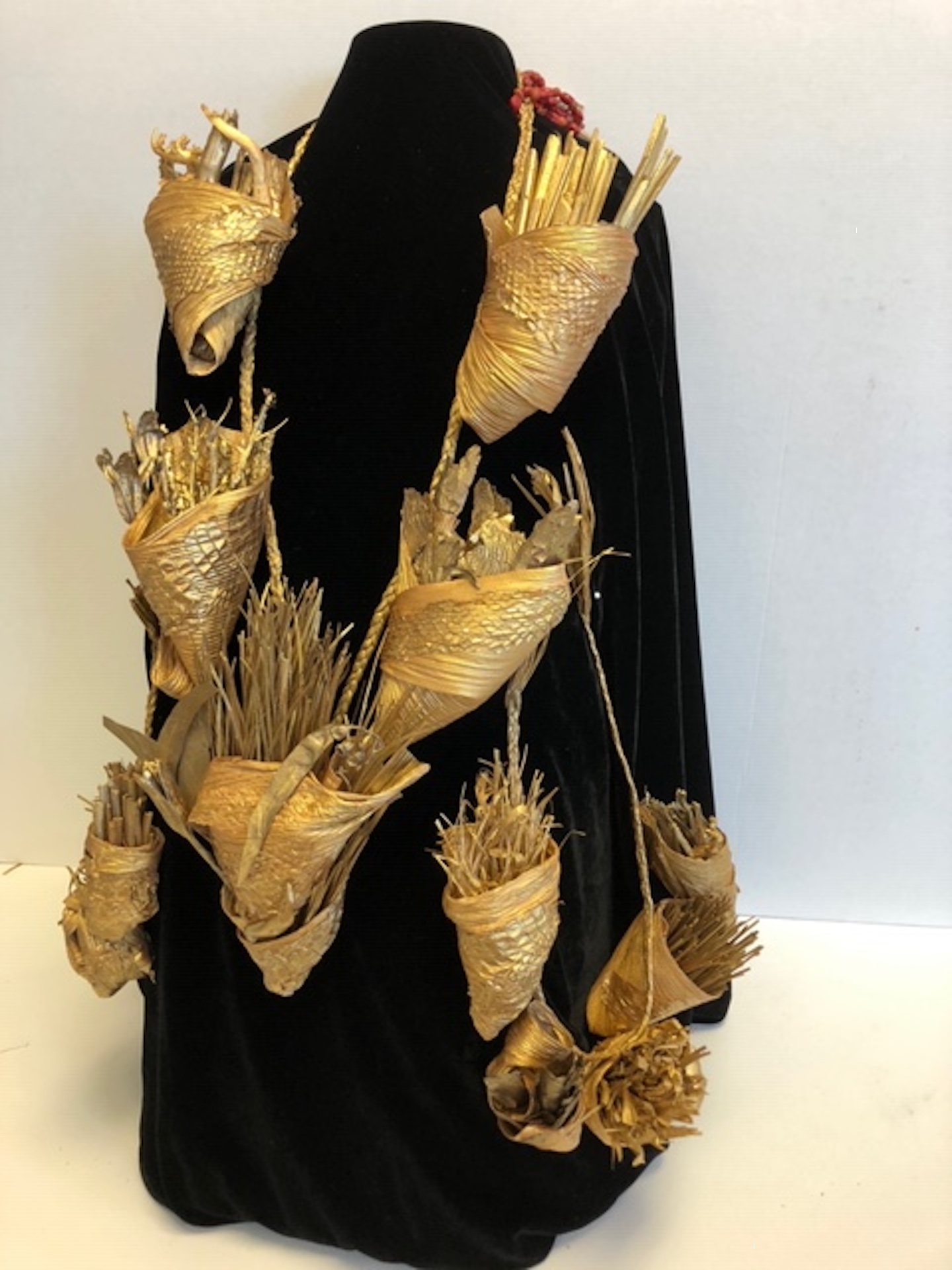
Pamella Saffer
The Root Doctor’s Jewels
Inspired by: Unknown artist, Yellow Amber Beads
ecdysis (naturally-shed snakeskin), corn husks, raffia, and other plant materials: lemongrass, sweetgrass, pine needles, eucalyptus, twigs, bark, plant pods
13″ x 14″ x 27″
2023
The antiquity and significance of the Fulani amber beads inspired me to likewise honor plant life and those who have recognized and understood the value of plants on our planet for millennia. The Root Doctor brings comfort and healing through her close relationship with the plant world and her bags of gathered materials. I selected plant materials for their accessibility, healing properties, significance in our cultures and for their textural beauty. I included ecdysis (naturally shed snakeskin) for its symbolism, globally, for millennia: transformation and healing. I am grateful to the naturalist who presented them to me and I was inspired with awe to handle them.
www.pamellasaffer.com
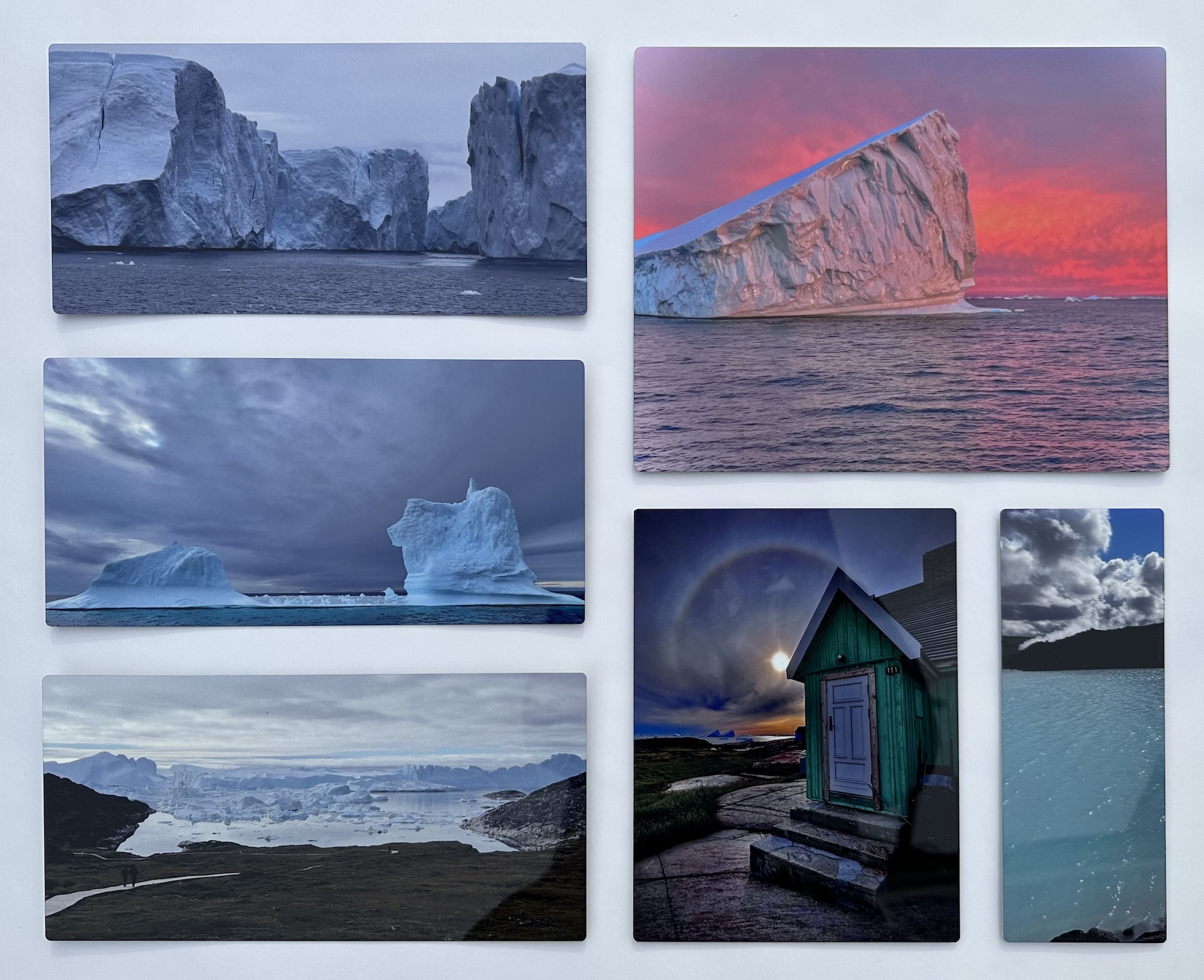
Ellen Salins
Global Warning
Inspired by: Winslow Homer, Gathering Berries Laura McPhee, The Blue Lagoon Harvey Sadow, Fire and Flood/Sacred Sites
photography on aluminum
22″ x 18″
2022-23
This Iceberg photo-collage is about the duality of a spectacular getaway experience combined with the inescapable knowledge that what is being seen is also part of our greatest existential threat. The ice-scapes were so beautiful and enjoyed in the way the people in the Winslow Homer are one with their surroundings that looked out to vistas that capture the popular imagination. The Laura McPhee location of the Blue Lagoon is again ‘quoted’ in this photo narrative here to be read as a final image, with the idea of imparting a feeling of warm water submersion, as a potential end result of our relationship with fossil fuel technology. There is color inspiration taken from Harvey Sadow’s ceramic with contrasting colors that represent fire and water, and in this photo piece, the warming sun and melting ice.

Donalyn Schofield
Fire and Flood / The 6th Extinction
Inspired by: Harvey Sadow, Fire and Flood/Sacred Sites
artist-altered book
10″ x 14.5″ x 1.25″
2023
Harvey Sadow’s beautiful pot immediately drew me in with its rich colors and textures. Both fire and water are elemental. Both can be horrifically deadly and yet both are essential for our very existence. After a fire, seeds sprouts. We need water to nourish what has sprouted. My altered book is a vintage copy of A Day in the Life of America photographed by 200 of the world’s leading photographers on, May 2, 1986. The photos are very nostalgic. While the problems of climate change are almost on the verge of catastrophe. Since I mentally processed what I added to the book, I have some hope for our little blue planet. But we need the will to change our ways and convince our governments and corporate entities to put the planet first: it’s people, animals and biodiversity over profits. Let’s hope we can.
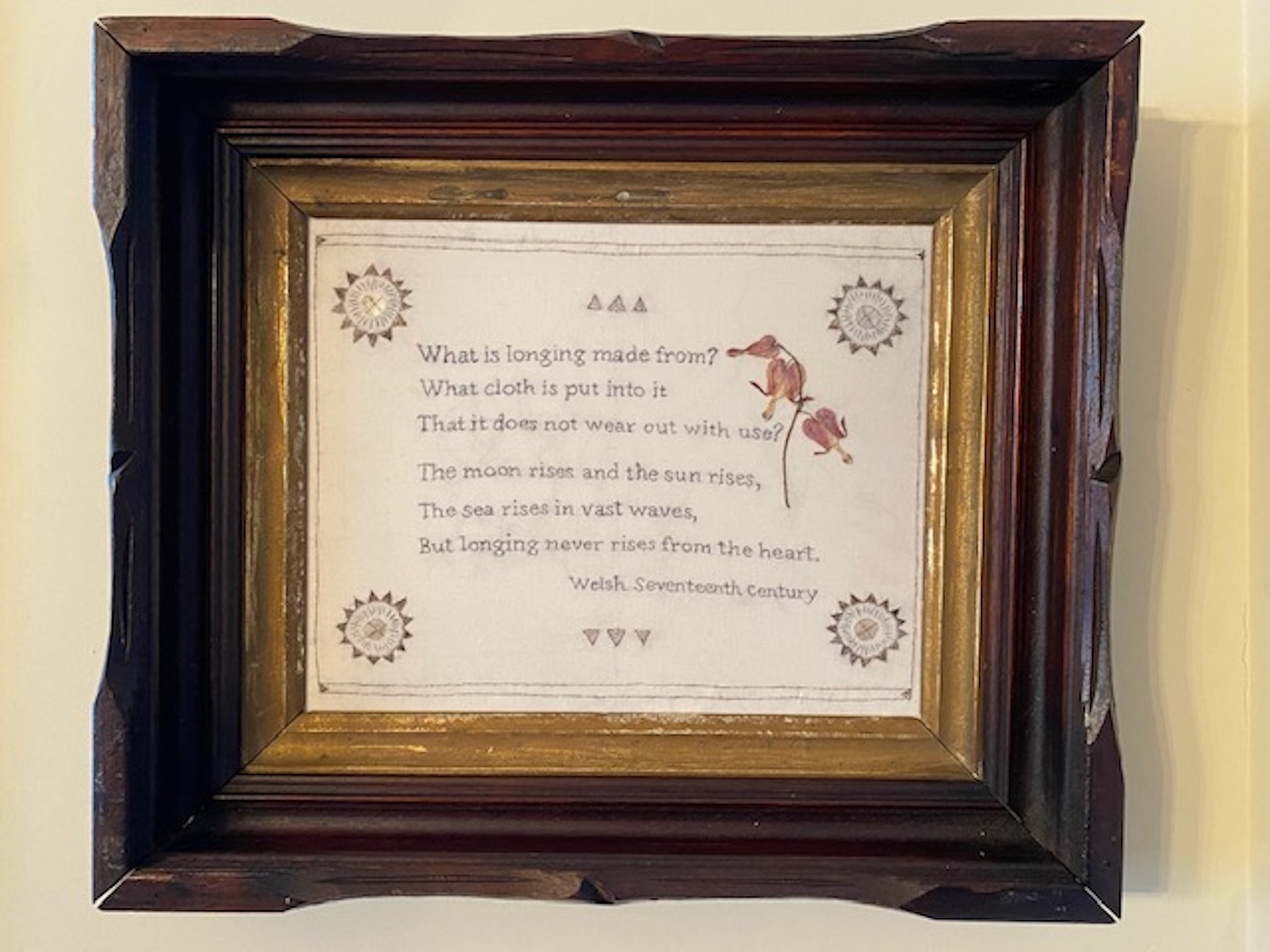
Leslie Schomp
What Is Longing Made From
Inspired by: Unknown artist, Tapa Cloth
hair, mica, pressed bleeding heart flower, on muslin in walnut frame
12″ x 14″ x 2″
2023
I am moved by the materiality of drawings and so was drawn the natural elements of the Tapa cloth (mulberry fiber, pigment and arrowroot binder). Such natural materials and processes create, in me, a longing for the natural world and so I choose to draw a quote about these feelings I have when I see such works. I used layers of mica from a rock I found in a mine, a pressed bleeding heart from my garden, my hair and a beautiful antique mahogany wood frame I found. These materials are filled with memories, a tension between fragility and strength and a reminder that the natural world is vulnerable but everchanging.
http://www.leslieschomp.com/
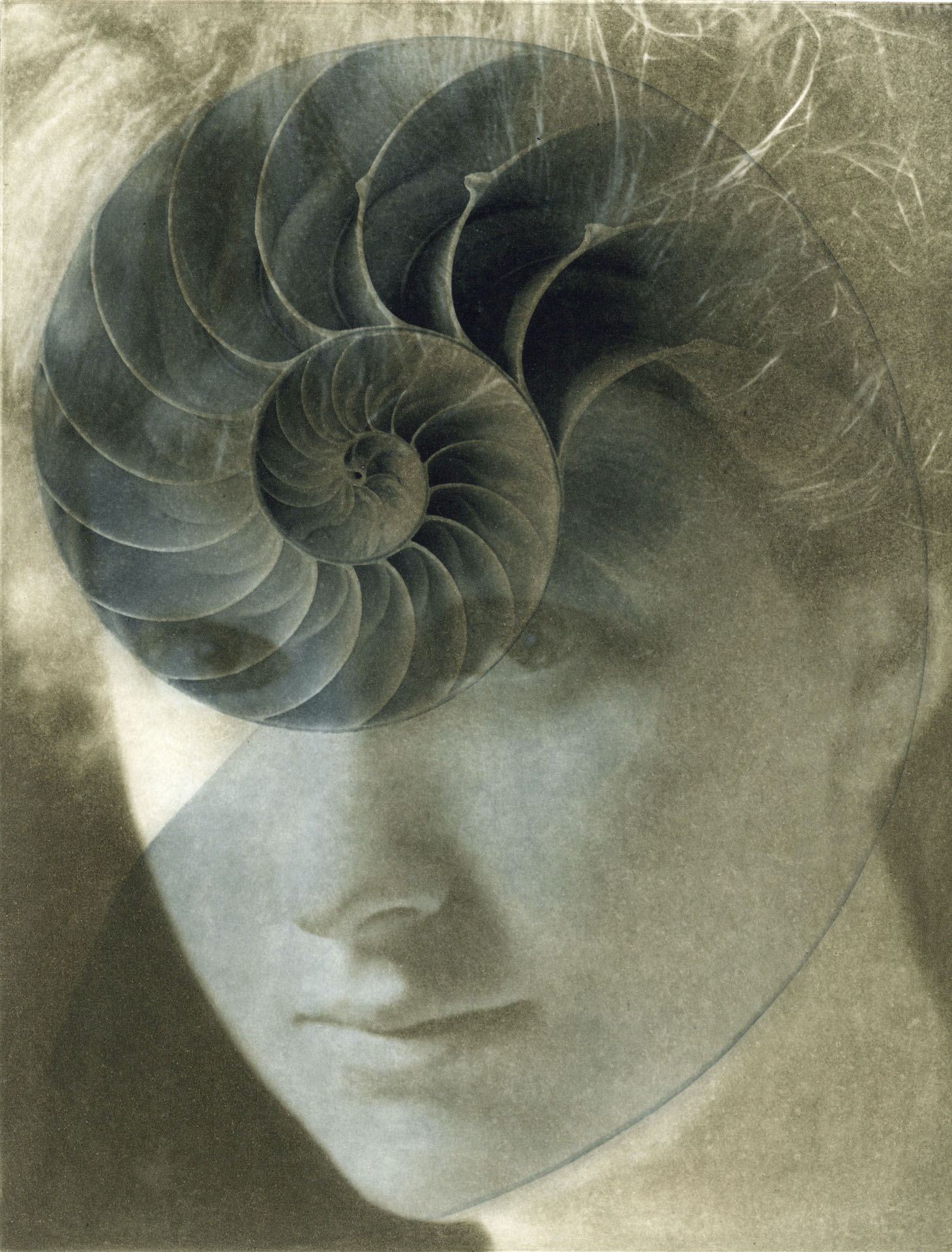
Fay Senner
Ancestral Healing
Inspired by: Robert Adams, Bulldozed Slash Esther Solondz, Untitled (Rust Portrait) Unknown artist, Tapa Cloth
limited edition photo-polymer print
15″ x 19″
2020
My photographic work spans the better part of 30 years, including pinhole images taken with a hand-made camera, manipulated Polaroid SX-70’s and photo-transfer. I utilize my digital imagery into various other applications to further merge and alter the final image. I am currently returning to the process of photo-etching and printmaking to further explore my creative self-expression.
https://www.facebook.com/faysenner; https://www.instagram.com/faybreed/
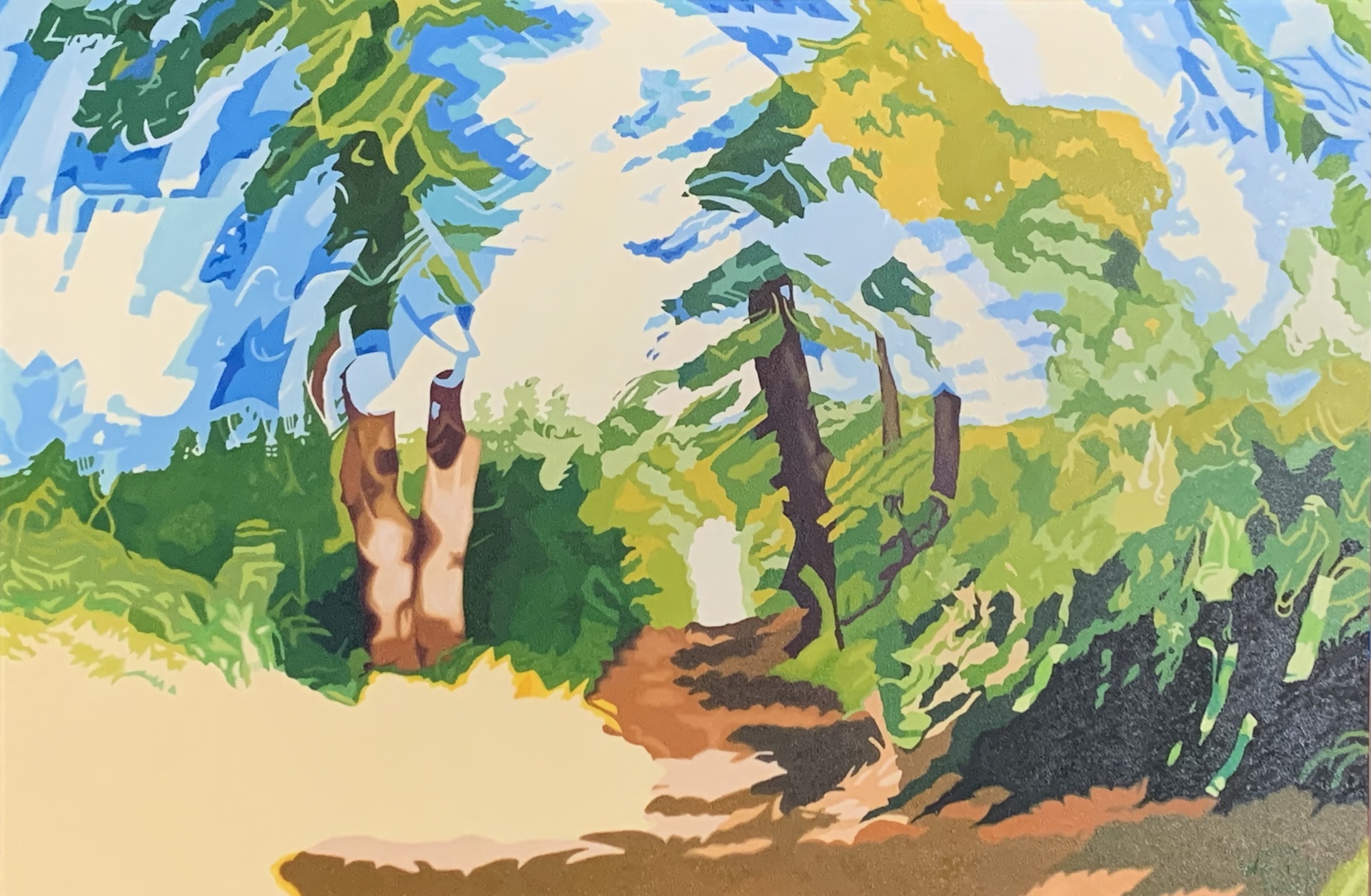
John Wesley Small
Too Much
Inspired by: Robert Adams, Bulldozed Slash John Willis, Recycled Realities 1
oil on stretched canvas
24” x 36”
2023
@john.wesley.small
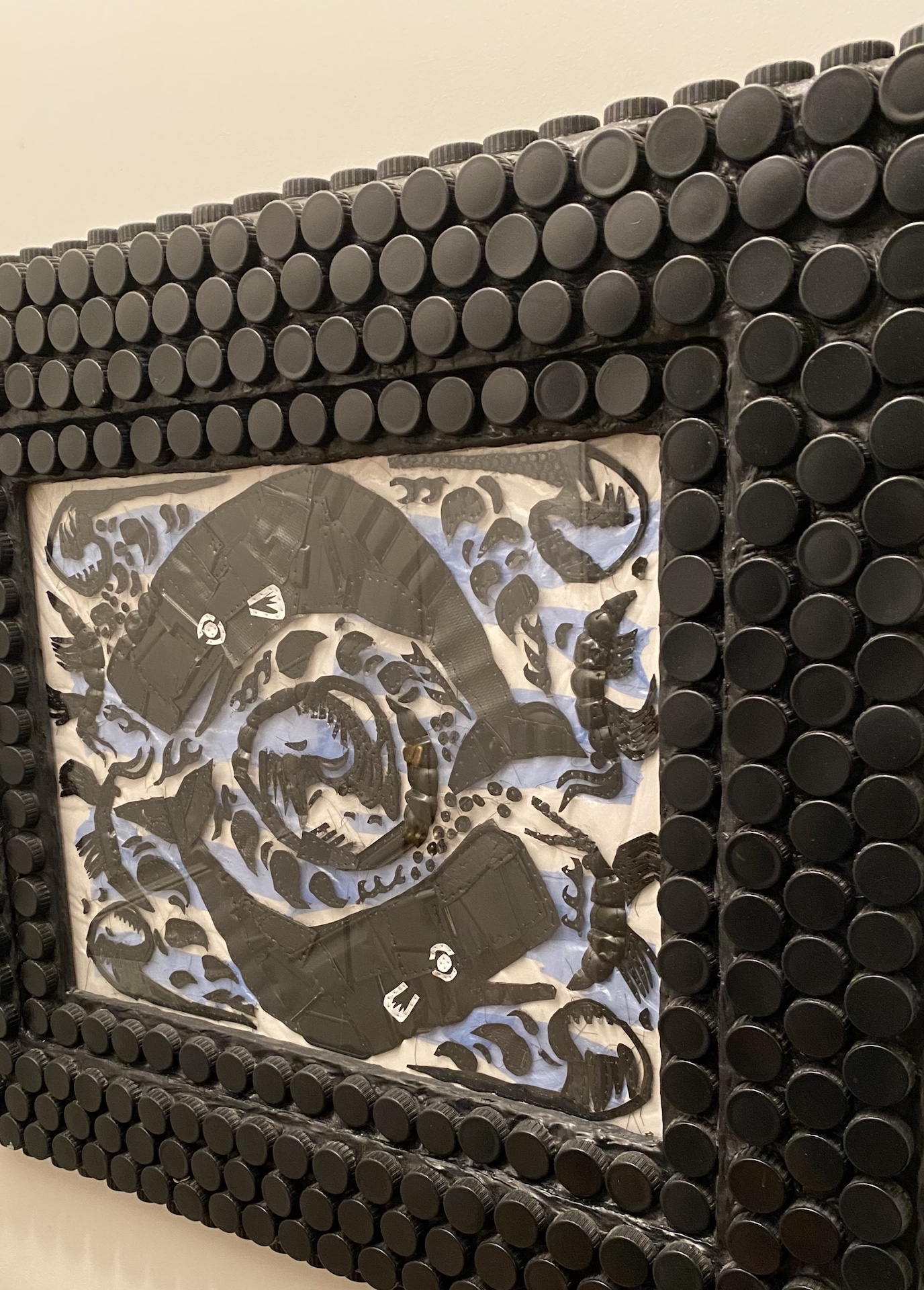
Catherine Smith
Whale Project #9
Inspired by: Evelyn Rydz, Gulf Pile
upcycled plastic, wood
30″ x 26″
2022
The Whale Project started in response to the now all-too-common sight of a dead whale washed up on shore with a belly full of plastic. As one of many who have been horrified by this sight, I decided to try to eliminate plastic from my life as well as save and make art out of that plastic I could not avoid buying. I saved one year’s worth of plastic and have made ten pieces in the last six years from that refuse. I feel a kinship to the work by Evelyn Rydz, Gulf Pile, who brings attention to plastic pollution on our beaches and the harm it does to the environment.
@Catherine Smith
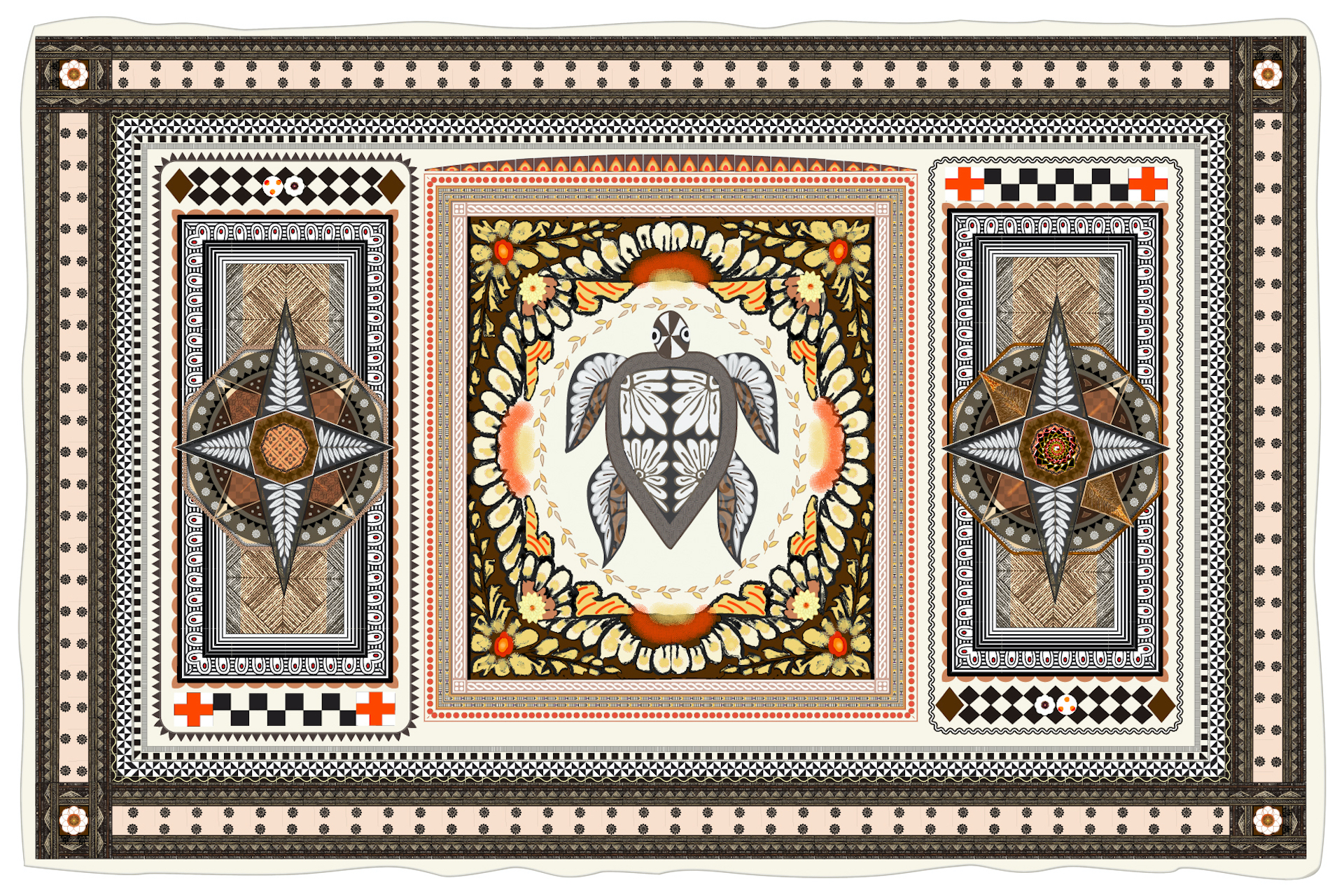
Edwin Smith
Tapa #2
Inspired by: Unknown artist, Tapa Cloth
digital drawing, pigment on paper
34″ x 28″
2023
I am intrigued by what seemed to be a fragment of a border of a much larger piece, and what did that look like? Is this all that’s left? The entire Togan village made cloth by peeling and beating tree bark with mallets, then gluing the resulting strips together. The overall pattern was transferred onto the cloth with inked rollers and wood blocks. This contrasted with me sitting at a computer with stylus and keyboard. Working with grids and repeating patterns, however is not different. Artists also rely on a community for hardware, media, services to produce work.
esphotodesign.myportfolio.com
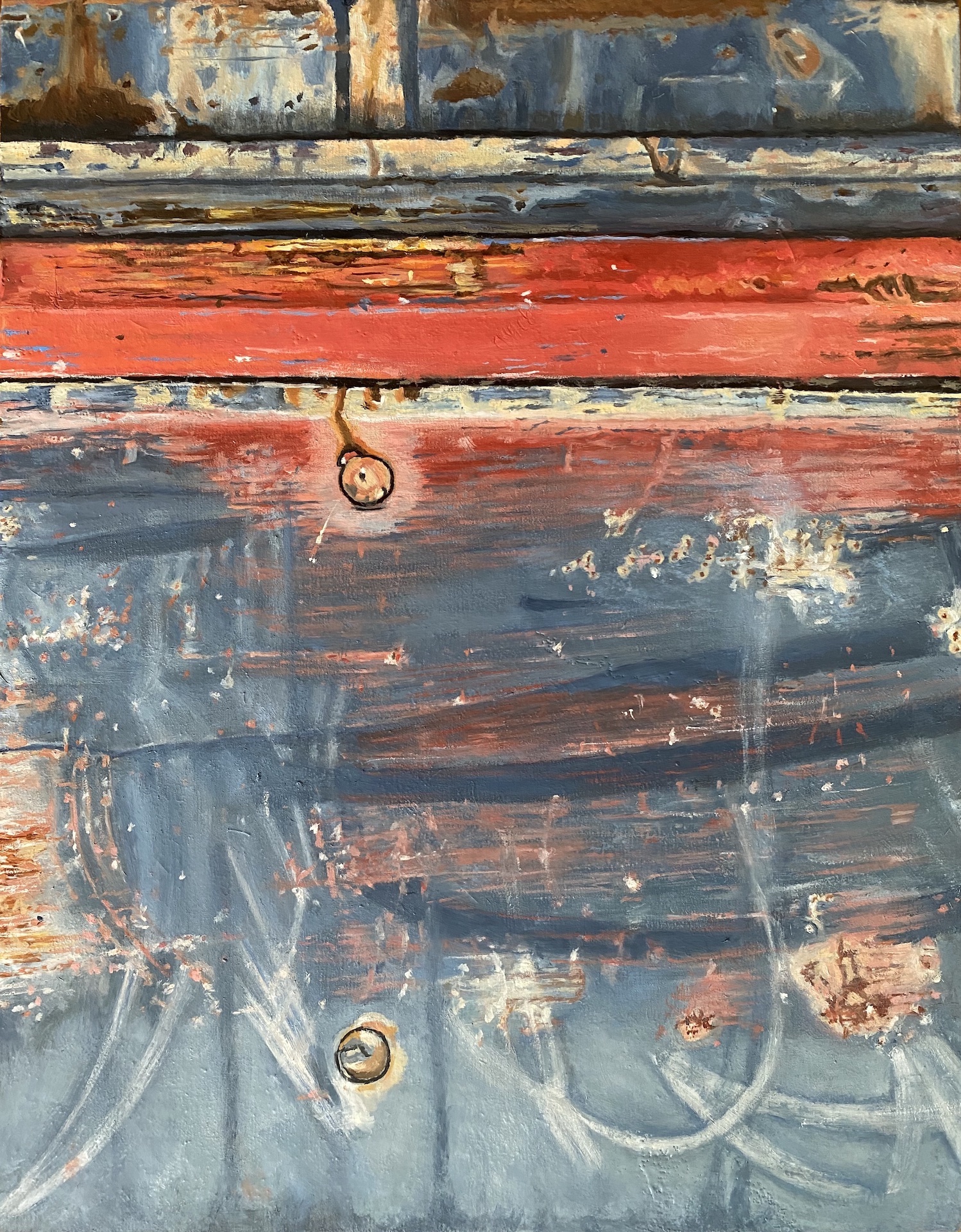
Tracy Spadafora
Dumpster with Red & Blue
Inspired by: Harvey Sadow, Fire and Flood/Sacred Sites
oil and encaustic on braced birch panel
14 x 11 x 1.5″
2023
When I saw Harvey Sadow’s Fire and Floods / Sacred Sites ceramic vessel I immediately felt a connection to the color and texture. This may have been because I had recently taken a photo of a metal garbage dumpster that had some similarities. I have been photographing worn, rusting dumpsters for the past few years as subjects for paintings and drawings, and the texture in Sadow’s piece seems to have a lot in common with the aged metal surfaces that I closely observe and meticulously recreate in my art. As Sadow’s vessel references the earth’s cycles of destruction and regrowth, I document the layers of deterioration of a metal vessel that carries waste.
www.facebook.com/tracy.spadafora
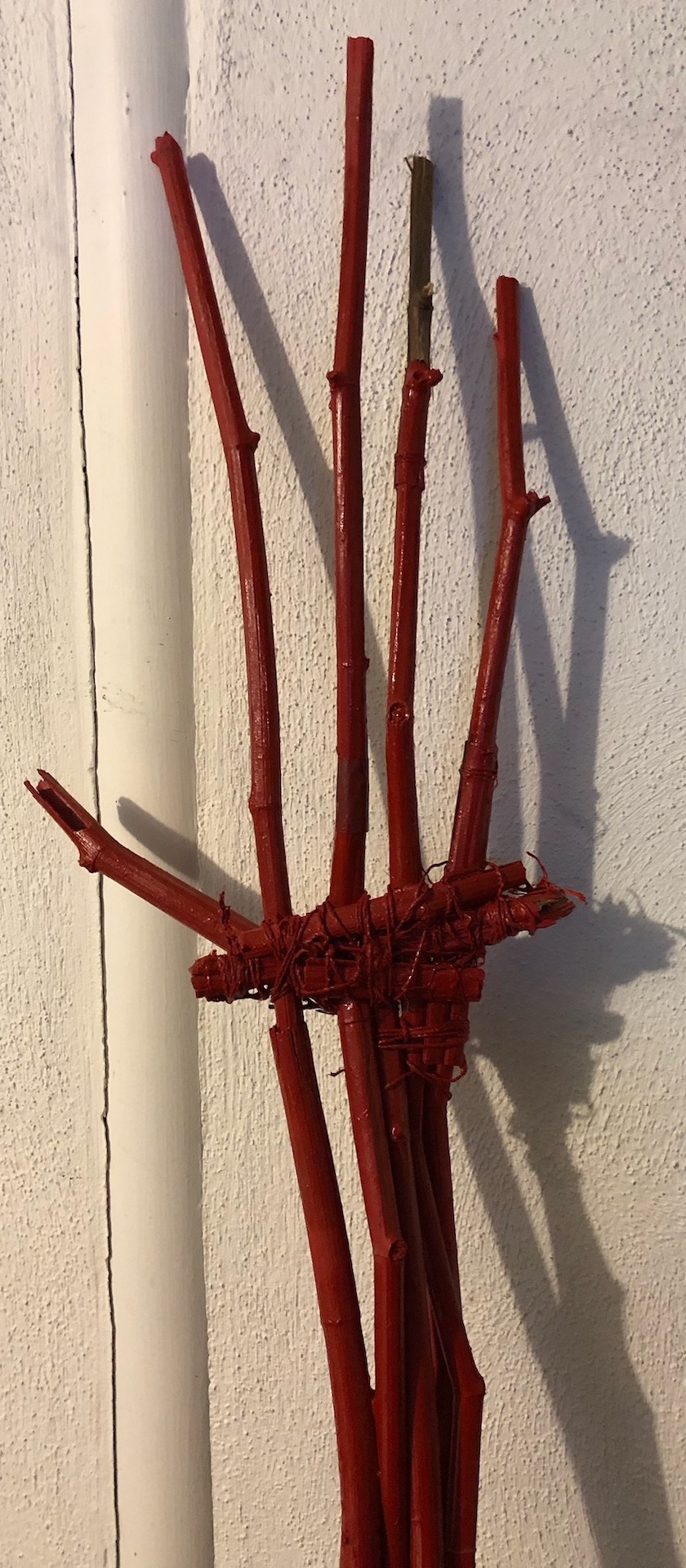
Lawrence Spezzano
Breaking Upward
Inspired by: Robert Adams, Bulldozed Slash Esther Solondz, Untitled (Rust Portrait) John Willis, Recycled Realities 1
dried Japanese knotweed stems, twine, and latex paint
70″ x 12″
2021
I am inspired by the unique shapes and structure of plants, especially invasive species, as they grow in and through our yards and communities. With infinite resolve, they spread into new spaces, even when we slash them back with tools and poisons. And the cycle continues with whatever remains from the wreckage. I often imagine how I feel in new spaces: scared, alone and defensive, yet persistent as I try to get a foot hold. As an artist, I work with whatever is available and enjoy building on the piece in whatever state it’s in! When I build with plant material, and I feel the brittle, fragile material give way, I quickly lash twine around the pieces, to keep it together, then add new material, and coat with thick paint, so the structure grows and stays together, in whatever form it becomes.
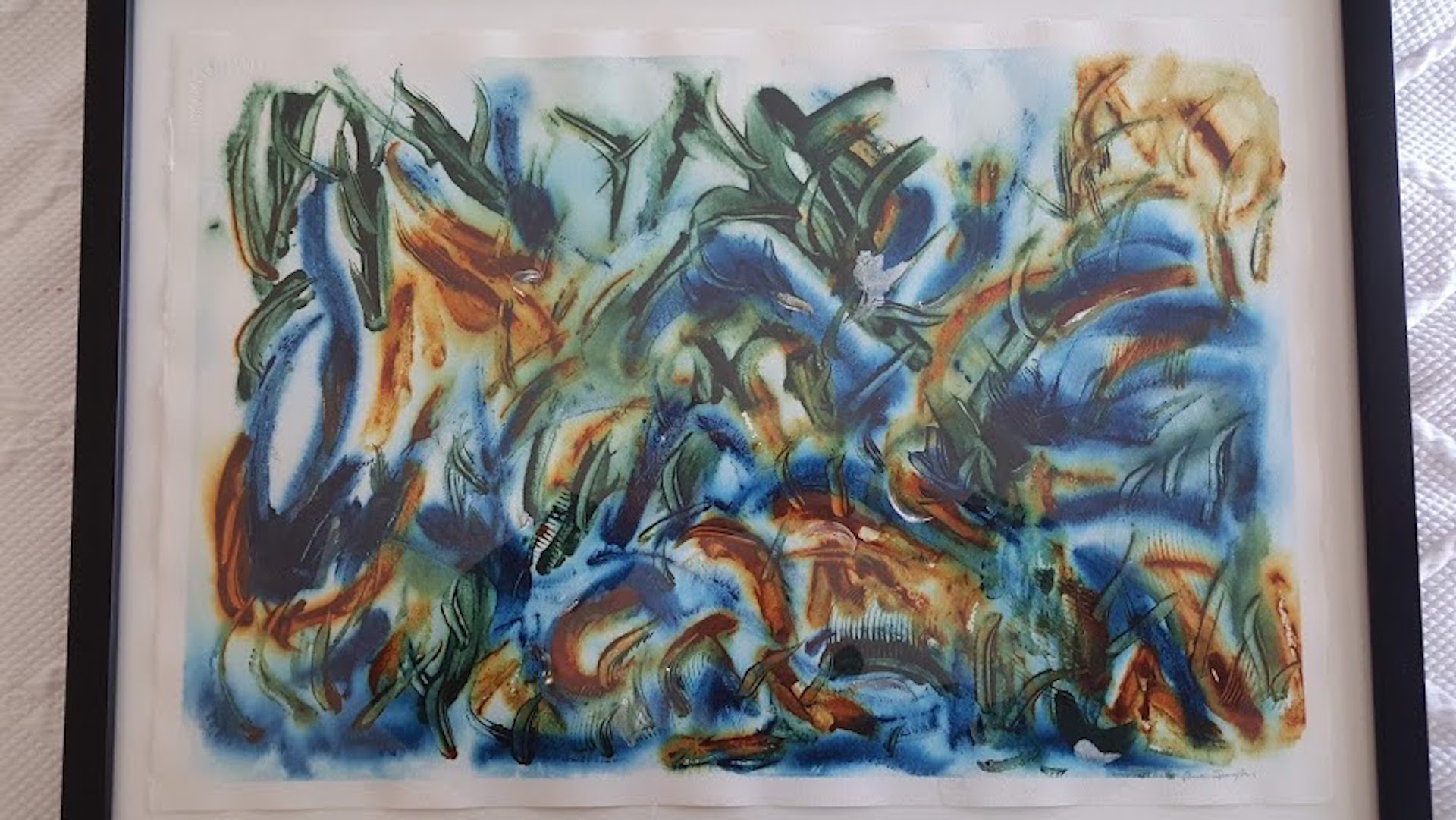
Catherine Spingler
Fire and Flood
Inspired by: Robert Adams, Bulldozed Slash
acrylic on paper
25″ x 19″
2023
While much destruction has been caused by wildfires and floods, this painting attempts to suggest that both elements, fire and water can stimulate regenerative growth.

Sierra St.Onge
Microcosm
Inspired by: Evelyn Rydz, Gulf Pile
acrylic paint, paint markers, watercolor pencils, and Christmas cactus water
8″ x 8″
2023
I looked at Gulf Pile by Evelyn Rydz and decided I wanted to zoom in on the plastics. What could be in there that we cannot see with a naked eye? Tiny flora and fauna blooming on the shell of discarded synthetic materials? Small beings thriving while devouring plastic pellets? Probably not, but it was fun to these concepts on canvas.
@sierraphantom
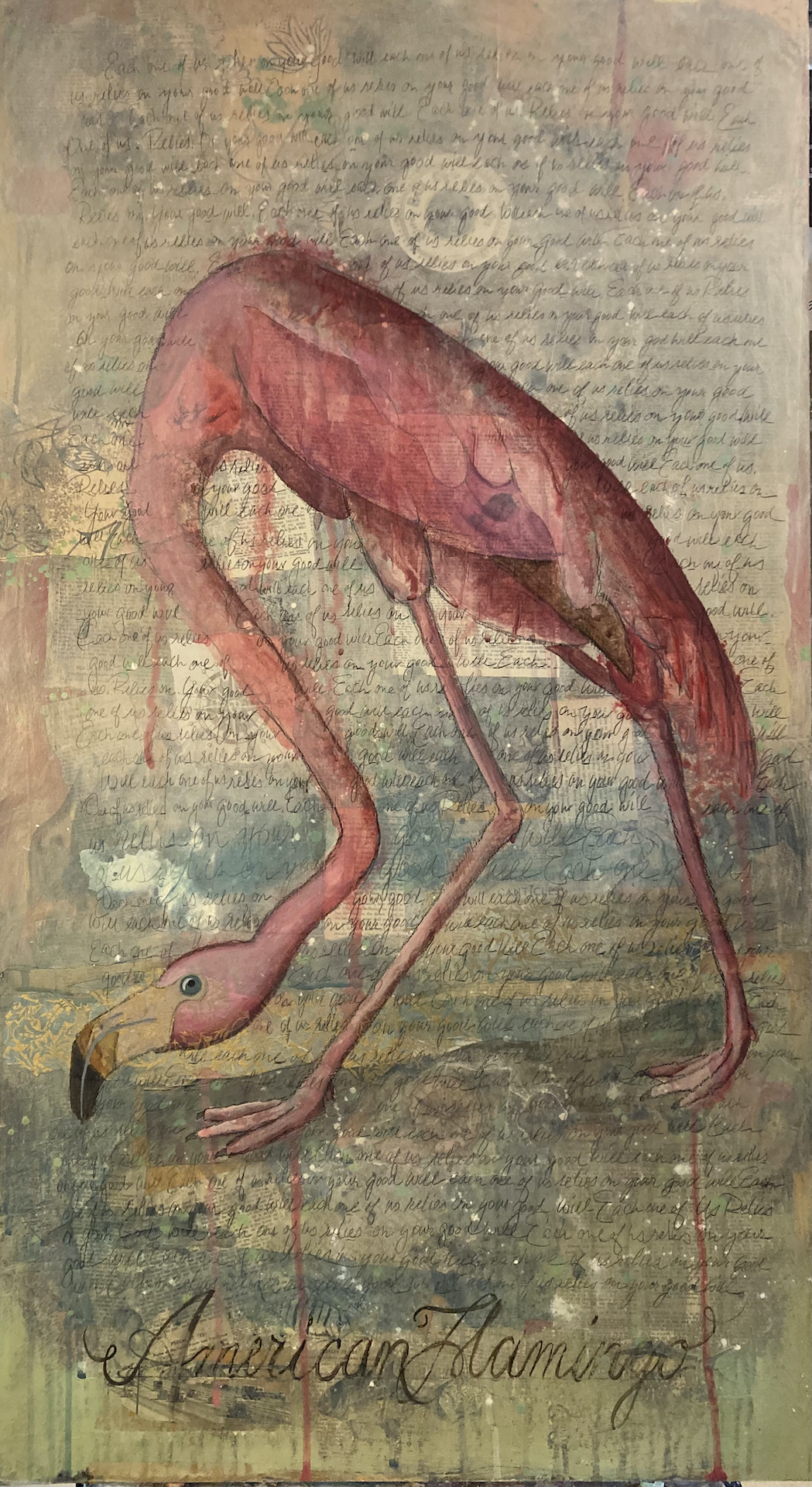
Jeanette Staley
American Flamingo
Inspired by: Laura McPhee, The Blue Lagoon Evelyn Rydz, Gulf Pile John Willis, Recycled Realities 1
collage, acrylic paint, pencil
44.5″ x 24.5″
2022
American Flamingo employs religious text, folk tales, bits of wallpaper and other detritus to reference the long history of environmental destruction caused by a capitalist, materialistic and patriarchal culture. The words of Dante, “each one of us relies on your good will” create another layer, as a plea from the flamingo, symbolizing our environment. The painted translucent image, referencing Audubon, seemingly disappears due to environmental destruction. Audubon is under new scrutiny as we struggle with his legacy as an anti abolitionist in addition to the complicated histories of other titans and myth makers of the 19th century, exploring the similarities with the tumultuous shifts of these first decades of the 21st. Blue Lagoon- draws on the tensions between environmental resources and societal needs Gulf Pile- the effects of capitalism, materialism and patriarchal culture on the environment Recycled Realities #1- the environmental effect caused by the detritus of society

Michelle Stevens
DEVILWIVES
Inspired by: Winslow Homer, Gathering Berries
acrylic and pastel on board
18″ x 22.5″
2021
In this piece, I reference a photo I took hiking at Devil’s Dyke in England, overlayed with reference of another friend walking in the city. It reflects on time, memory and how far people living in urban environments often need to travel to feel truly immersed in grand-scale nature. Both foregrounds in our pieces juxtapose their backgrounds. Homer’s “Gathering Berries” landscape uses labor, while mine leans more environmental and psychological. My work is most influenced by connectivity, sustainable intake, documentation, and psychology. I do relate to Homer in being part Illustrator, part fine artist, and it is noted his images show a “vision of America during an era of immense social, political, and technological transformation,” which feels very in line to how artists are still navigating the world currently.
@michellestevensart
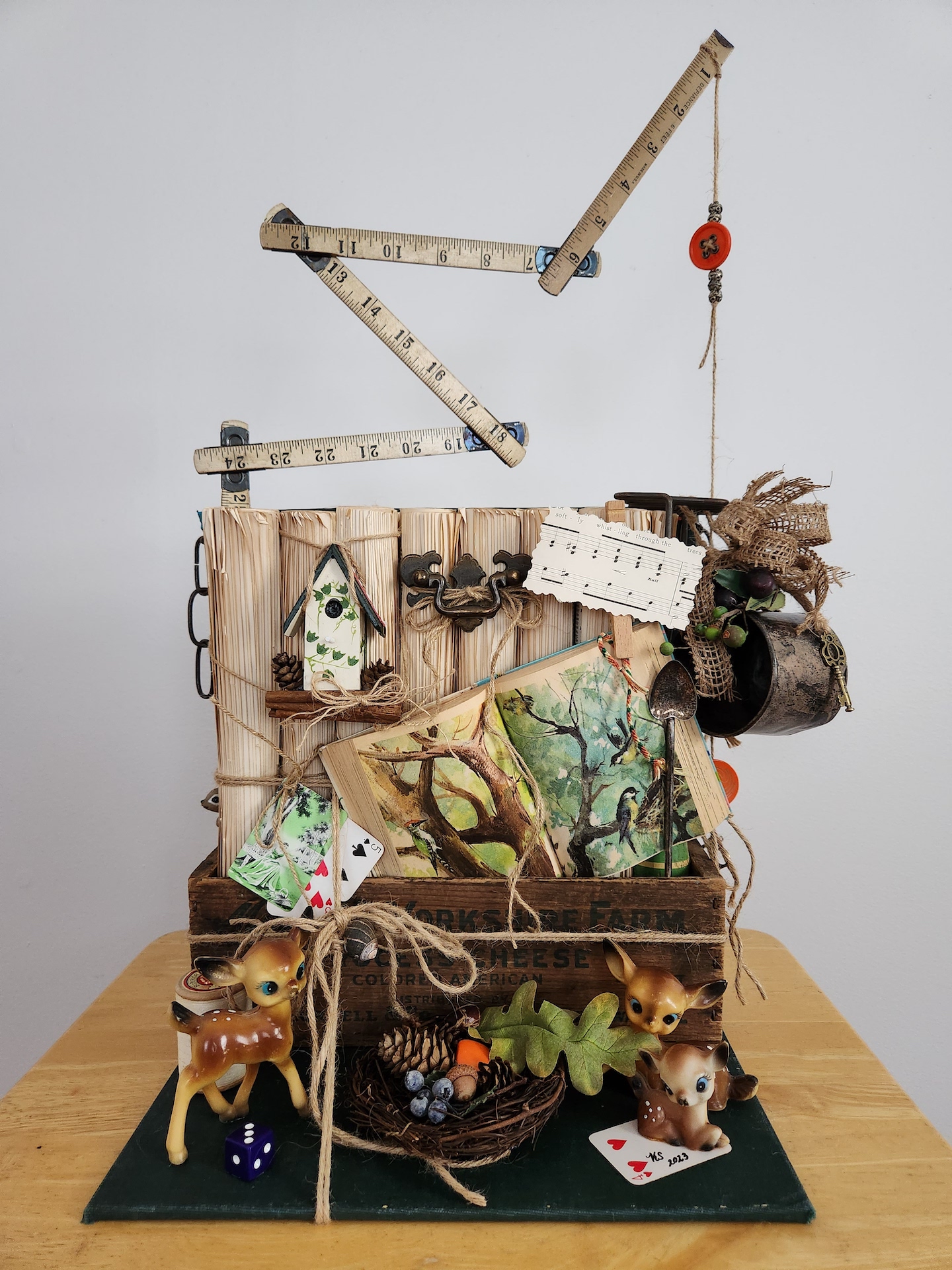
Karen Stokke
In Memory of Lost Trees
Inspired by: Robert Adams, Bulldozed Slash Winslow Homer, Gathering Berries John Willis, Recycled Realities 1
assemblage composed of altered, vintage, and organic found objects, mounted on encyclopedia cover with glue and string
23″ x 12″ x 14″
2023
When my father passed away across the country in early spring of 2021, I drew solace from the stand of tall, ancient pines and maples which grew just beyond the fence of our tiny yard in Massachusetts. Dad was a gentle man who shared an enduring love for nature with his family, and so I felt near to him under the trees. They were still full of birdsong when felled by a developer’s crane the following year, another loss I felt deeply. With its thematic concept derived from Bulldozed Slash, this piece utilizes a lifetime of “gatherings,” among them vintage and organic found objects (Gathering Berries). Honoring the cyclical nature of Recycled Realities #1, I have created “trees” from a former tree itself via the pages of a dismantled encyclopedia. Lastly, symbolized by surviving pinecones, is my hope this work will ultimately be to the viewer an impetus for renewal.
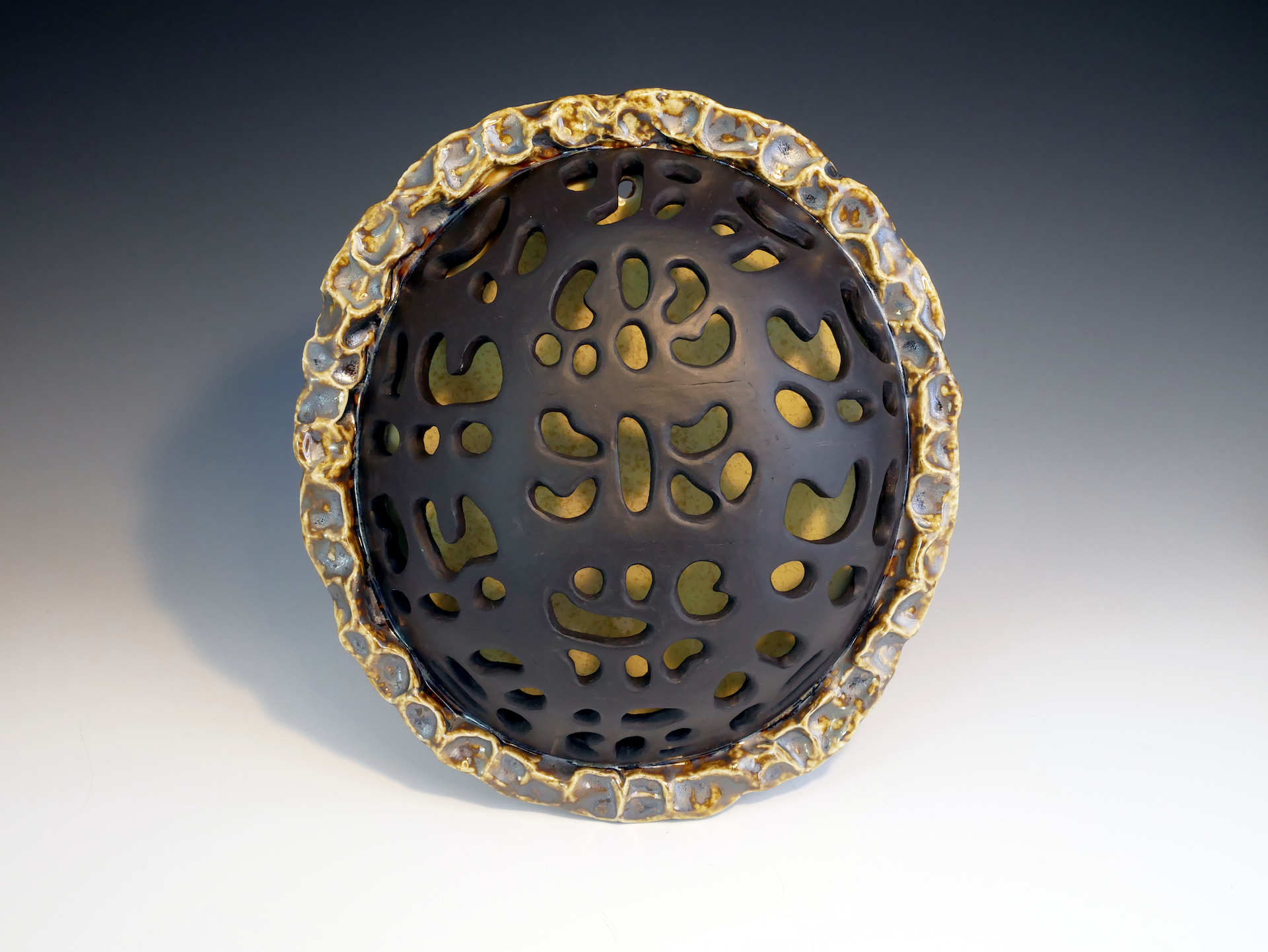
Suzanne Stumpf
Carapace
Inspired by: Unknown artist, Yellow Amber Beads
porcelain
10″ x 9″ x 2.5″
2022
Amber is presumed to offer protection to the wearer. A shell also should. Inspiration for Carapace comes from multiple places. When a friend sent me a photo she took of a box turtle that crossed her path, my heart skipped a beat. Such stunning beauty! And a question: how does nature do this? I was reminded of Mary Oliver’s words about nature “what, in the earth world, is there not to be amazed by, to be steadied by, and to cherish?” Despite the hardness of their shells, turtles are vulnerable creatures, and with their not infallible shells, they are a metaphor for the fragility of nature. My sculptural interpretation reveals the shell to not be truly protective but instead a window into the interior with its Amber glow. The spiritual spark and embodiment of life that is hidden inside/beneath our “shells” is at once beautiful, precious, and so fragile.
@suzannestumpf
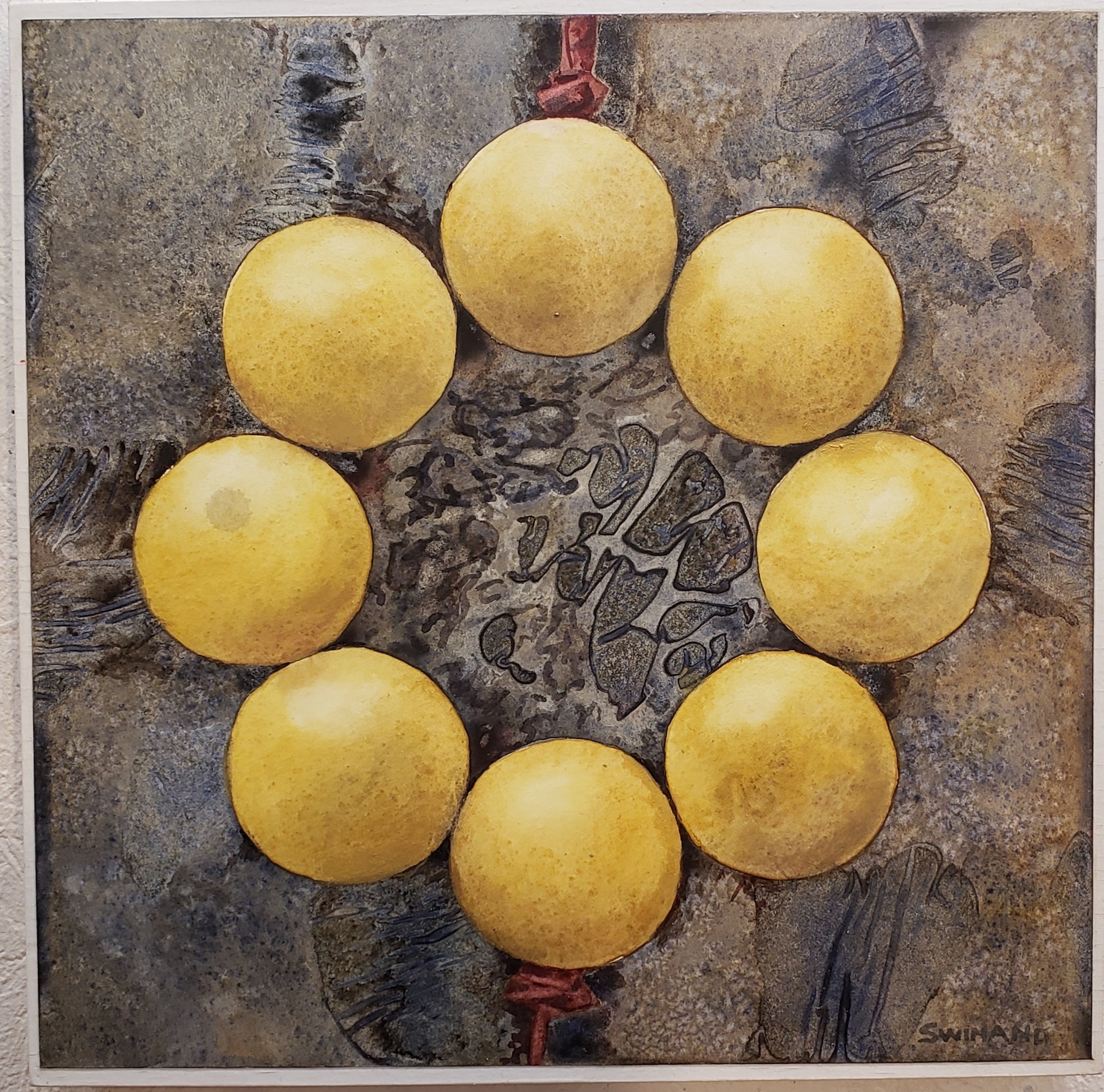
Susan Swinand
Imposed Order, I
Inspired by: Unknown artist, Yellow Amber Beads
watercolor on paper on wood panel with UV varnish
12″ x 12″
2023
Much of my work has dealt with spontaneous, random reactions of pigment and water on paper. To me it is nature at work creating form. I am interested in the question of when it becomes art. Making art we impose our own order on nature. We choose and alter bits of nature to express our deepest ideas and emotions. I responded to the Amber necklace with radial symmetry and maximum impact to stabilize and control the random field.
FB -Susan McBriarty Swinand Instagram- SSwinand
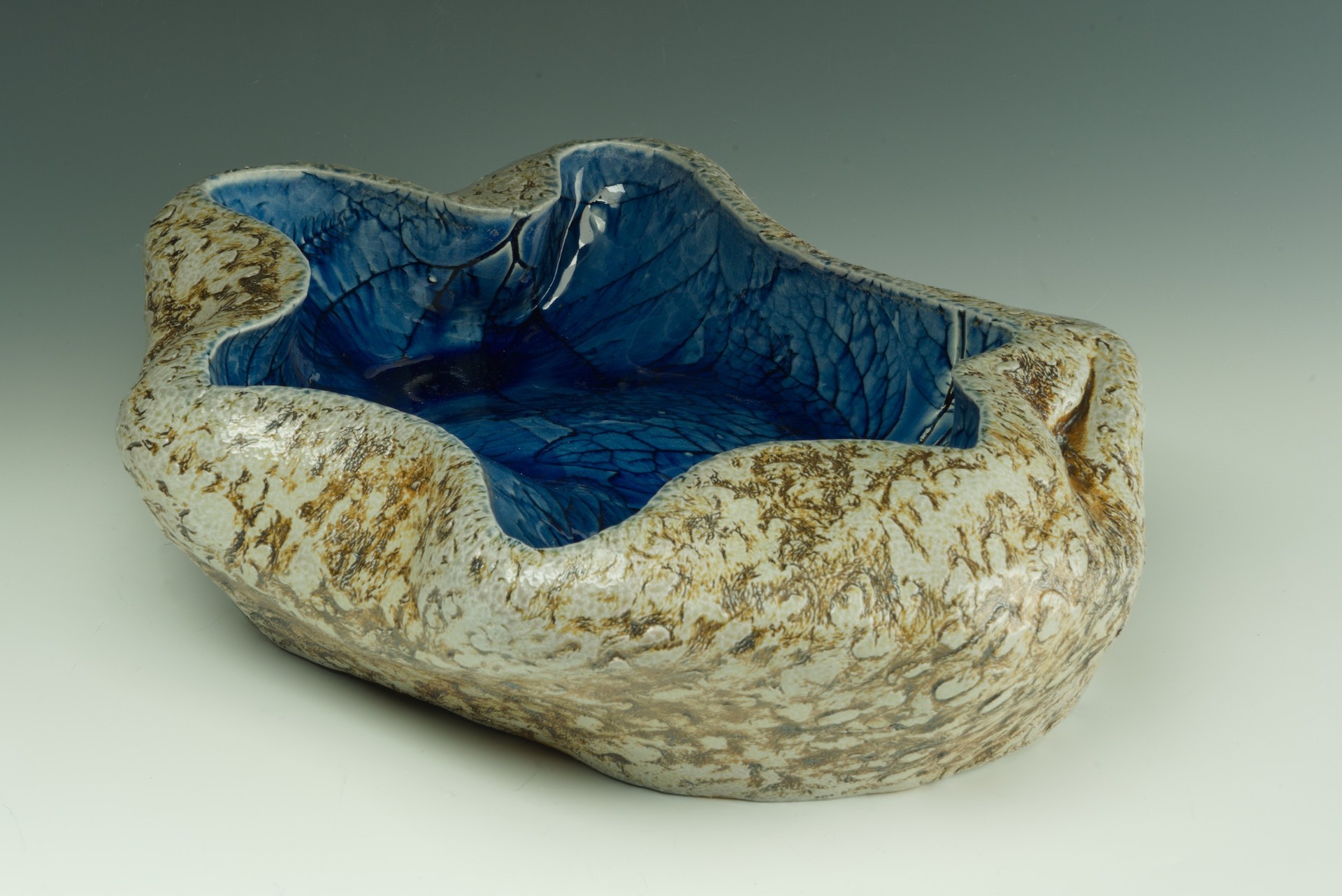
Anne Swinton
Glacier Pool
Inspired by: Lionel Reinford, Winter in New England Laura McPhee, The Blue Lagoon
ceramic
14″ x 11″ x 5″
2022
Anne is a ceramic artist and sculptor. Her work is inspired by the organic lines and texture of nature, both in feel and look. She is conscious of the hand feel of her work, making sure the texture is substantive, reminiscent of the satisfying smoothness of naturally eroding rock and the coarse fibrous solidity of bark. “Glacier Pool” is from Anne’s “Rock” collection. The textures have been created using plants from the Southwest as well as New England. The exterior, pressed repeatedly with a Cholla skeleton from the desert, evokes a chilly glacier. The interior invites you to look closer with its blue color and imprinted leaves from Anne’s garden. It is Anne’s hope the two textures tempt you to glide your hand across their surfaces. Light stoneware, oxides, and glaze. Soda-fired in a gas kiln to cone 10.
@anneswintonpottery
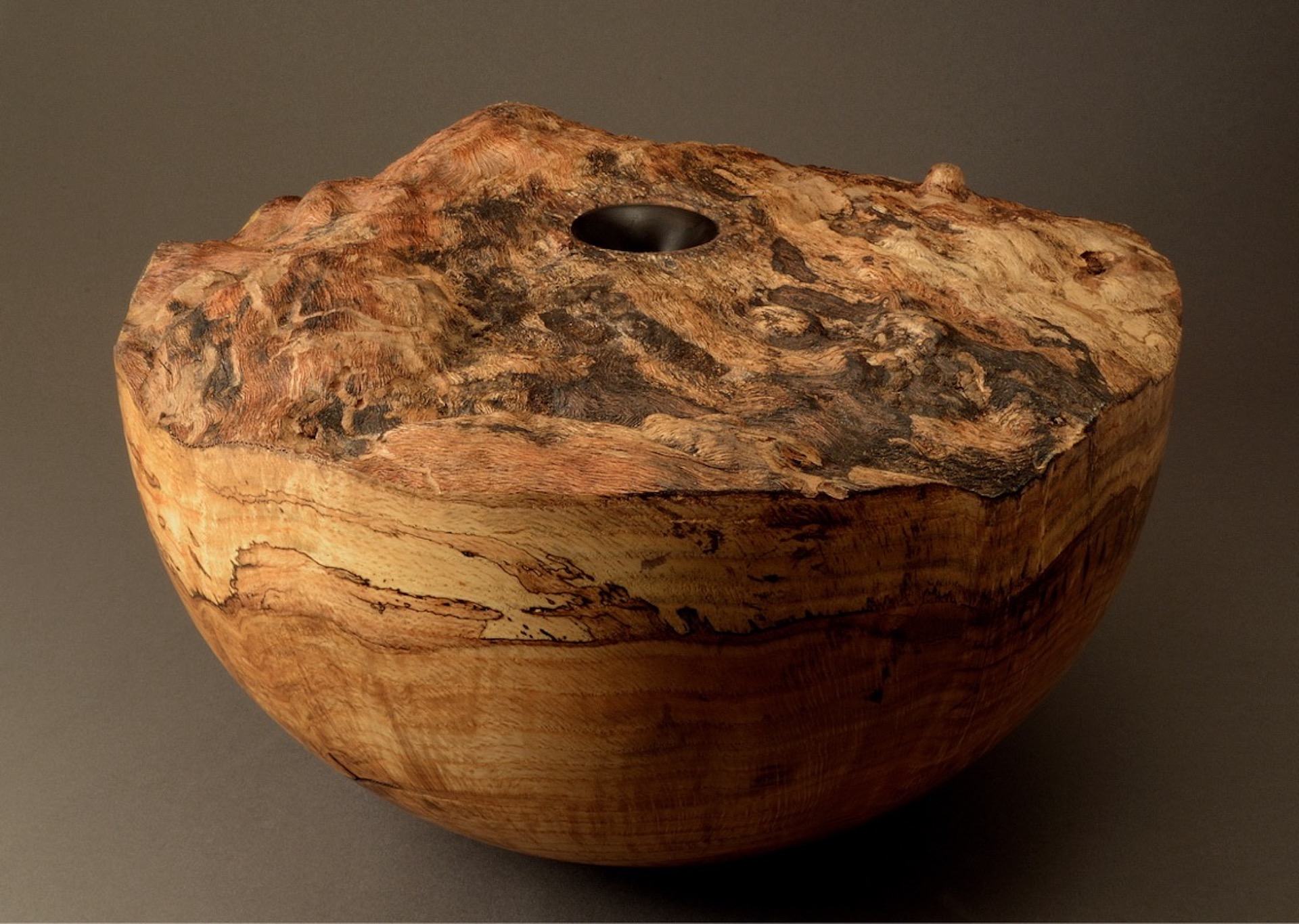
Derrick Te Paske
ANTHROPOCENE
Inspired by: Harvey Sadow, Fire and Flood/Sacred Sites
oak burl, Ziricote
10″ x 16″ x 17″
2017
Harvey Sadow’s 1989 ceramic vessel “Fire and Flood/Sacred Sites” is nearly globular, richly colorful, and fundamentally optimistic. His title’s opposing natural disasters are said to be “sacred cycles of destruction and regrowth.” In contrast, my ANTHROPOCENE is bleak and shockingly catastrophic, a hemispheric remnant of some devastated planet. I don’t usually feel that despairing, but long before we came to know the word Anthropocene, I had thought that our collective human presence on Earth represented something like an “asteroid in slow motion.” So this is really a nightmare vision, replete with a crater plunging into the dark interior. The operative word here is, indeed, “impact.” We may say we’re “destroying the planet,” but we’re not really likely to actually blow it in half. The earth will survive, and we are not its top priority. Meanwhile, despite occasional concern for “polar bears,” we’re typically worried most about the destruction of ourselves.
tepaske.derrick

Trevor Toney
Torn
Inspired by: Robert Adams, Bulldozed Slash John Willis, Recycled Realities 1
engineered oak veneer, Baltic birch plywood, acrylic paint
18″ x 18″ x 2″
2023
Since my work predominately uses wood, I have long thought about the sustainability of this material and as such, only use renewable, responsibly sourced wood and veneer. I usually fabricate my wall pieces so the wood grain is undisturbed in order to create a harmonious backdrop for adding acrylic paint. However with this piece I’ve decided to create a subtly disjointed canvas by altering grain directions which I hope hints at the oft-obscured realities of using such materials and the reverberations felt by our environment.
@TrevorToneyinColor
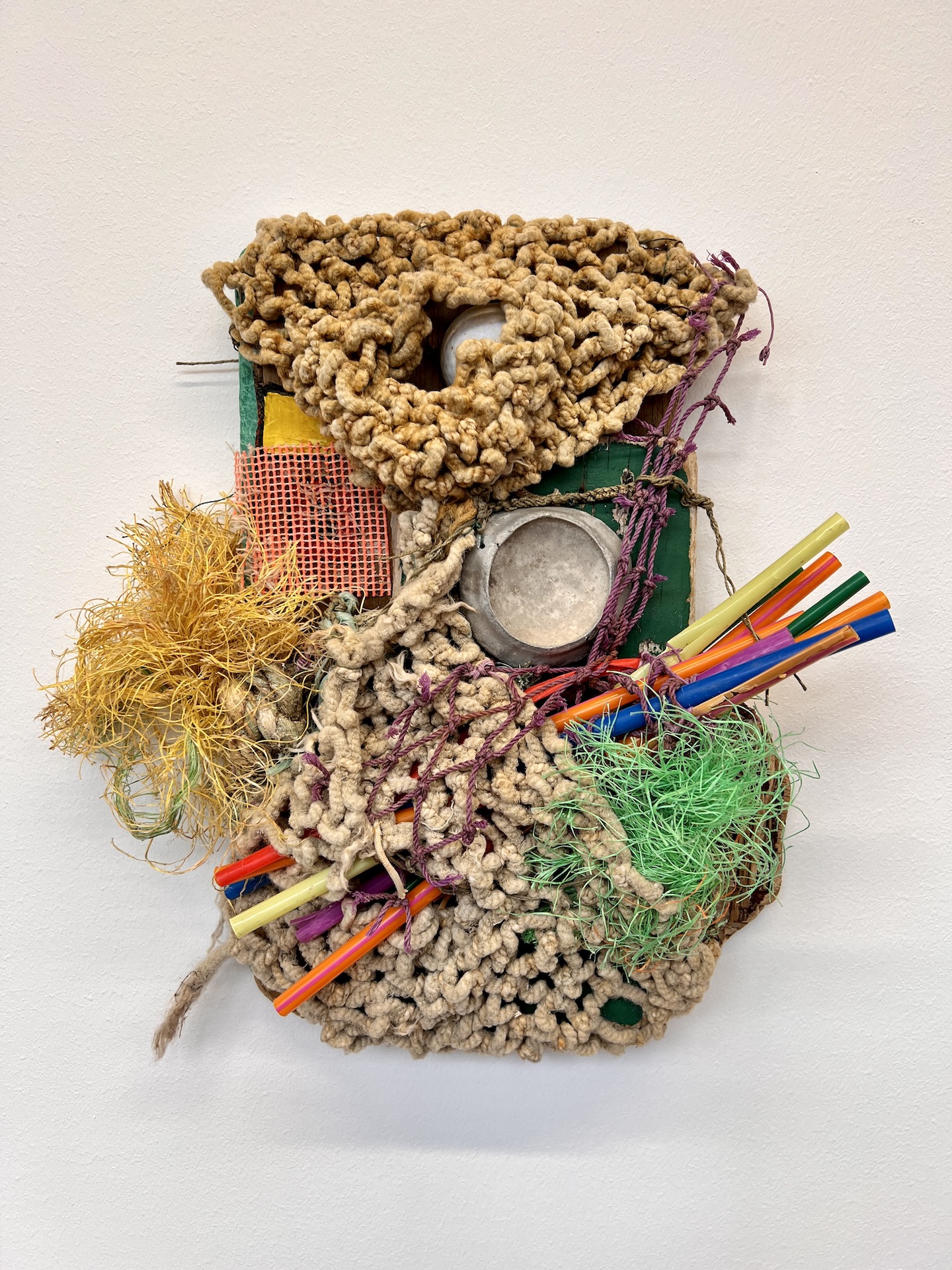
Rebecca McGee Tuck
Wrackline Walk: 10/10/2022
Inspired by: Evelyn Rydz, Gulf Pile
sea debris, wire
13″ x 12″ x 4″
2023
The Wrack-Line: A trail of debris left on the beach by the high tide. I walk the wrack line of the Massachusetts coastline, collecting debris. With each bag of marine trash that I bring home, I feel the precarious weight of the impact of pollution in the ocean. I was inspired to create this piece when seeing Evelyn Rydz’s, “Gulf Pile.” Every time I collect beach trash, I am faced directly with the dark reality of man made objects that clutter, tangle and threaten sea life. This sculpture records the objects that I collected on October 10, 2022–just an ordinary day of beachcombing. With my work I hope to raise awareness to the constant misuse of the ocean’s ecosystem by transforming pieces of sea debris into works of art and symbols of hope– calling attention to the consequences of poisoning our oceans and encouraging a new commitment to action!
@Rebeccabombshellart
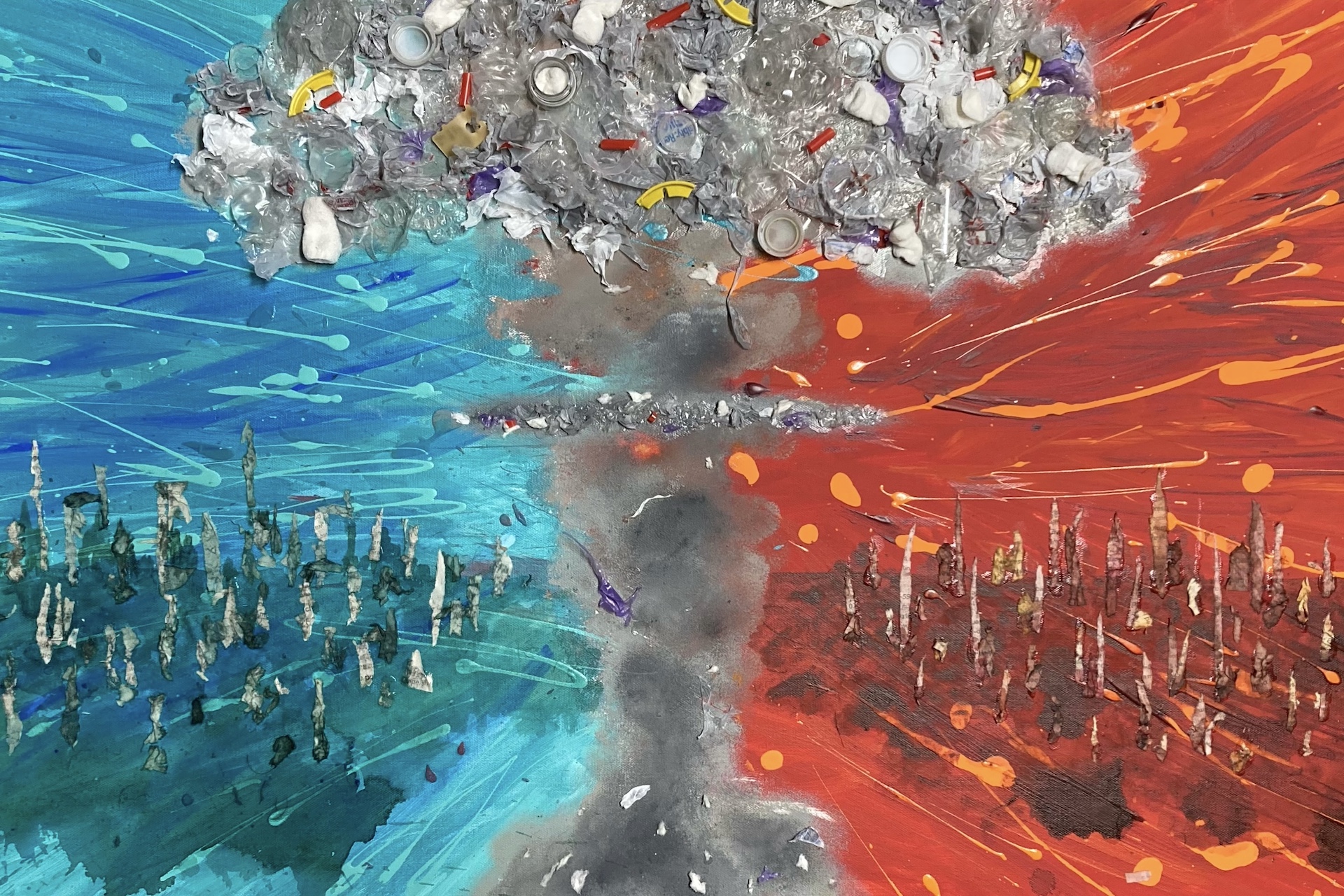
Caitlin Tupper
Detonation
Inspired by: Evelyn Rydz, Gulf Pile Harvey Sadow, Fire and Flood/Sacred Sites John Willis, Recycled Realities 1
acrylic on canvas, collaged plastic waste (bottle caps, bottles, styrofoam, cup carriers, straws, plastic bags), newsprint
24” x 36”
2023
‘Detonation’ is a mixed media collage using a combination of texture and expressive colors to convey the inevitable chaos that would result from the negative feedback loop of the climate crisis going unchecked. Inspired by Evelyn Rydz’s – Gulf Pile using a variety of plastic, man-made, waste (bottles, straws, bags, can carriers etc.) to bring depth and impact to the crown of the mushroom cloud which is the central focus of the piece. Drawing the color palette from Fire and Flood by Harvey Sadow to set the stage of a planet, plagued by natural disaster. The abstracted forms in the landscape are in homage John Willis’ Recycled Realities #1). The distressed newsprint contains the remnants of climate research, symbolizing the positive force of man which in this instance has become distressed and hard to discern. The newsprint forms carry a message that appears to have gone unheard until much too late.
@ctupper.art
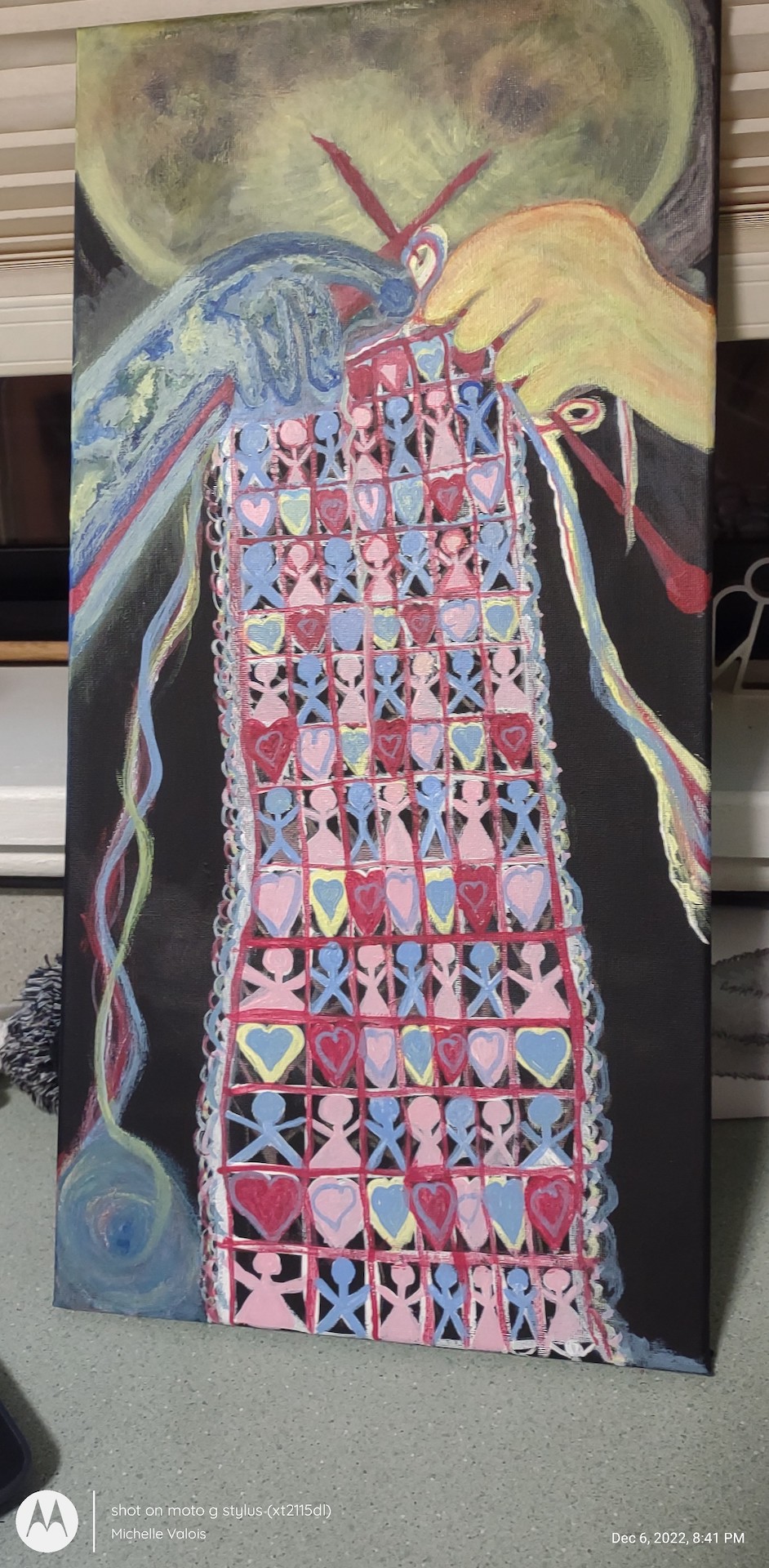
Michelle Valois
Making of the Universe
Inspired by: Laura McPhee, The Blue Lagoon
acrylic on canvas
10″ x 20″
Dec 2022
The Making of the Universe is a Painting of the Earth, Sun and Moon coming together to make us all One!
Bellatreesart@instagram

Sylvia Vander Sluis
Nested Vessel
Inspired by: Unknown artist, Tapa Cloth John Willis, Recycled Realities 1
newspaper, acrylic, sand, packing material
5″ x 7.5″
2022
For millennia, bowls have served as functional, decorative, and ritualistic objects that have enhanced human relationships. Made primarily of newspaper, “Nested Vessel” merges the concepts of bowl, art, and the salvaging of a common recyclable product. Printed on newsprint, which is made from wood pulp, newspapers are used as communication tools and ultimately, become waste.
@sylviavsart
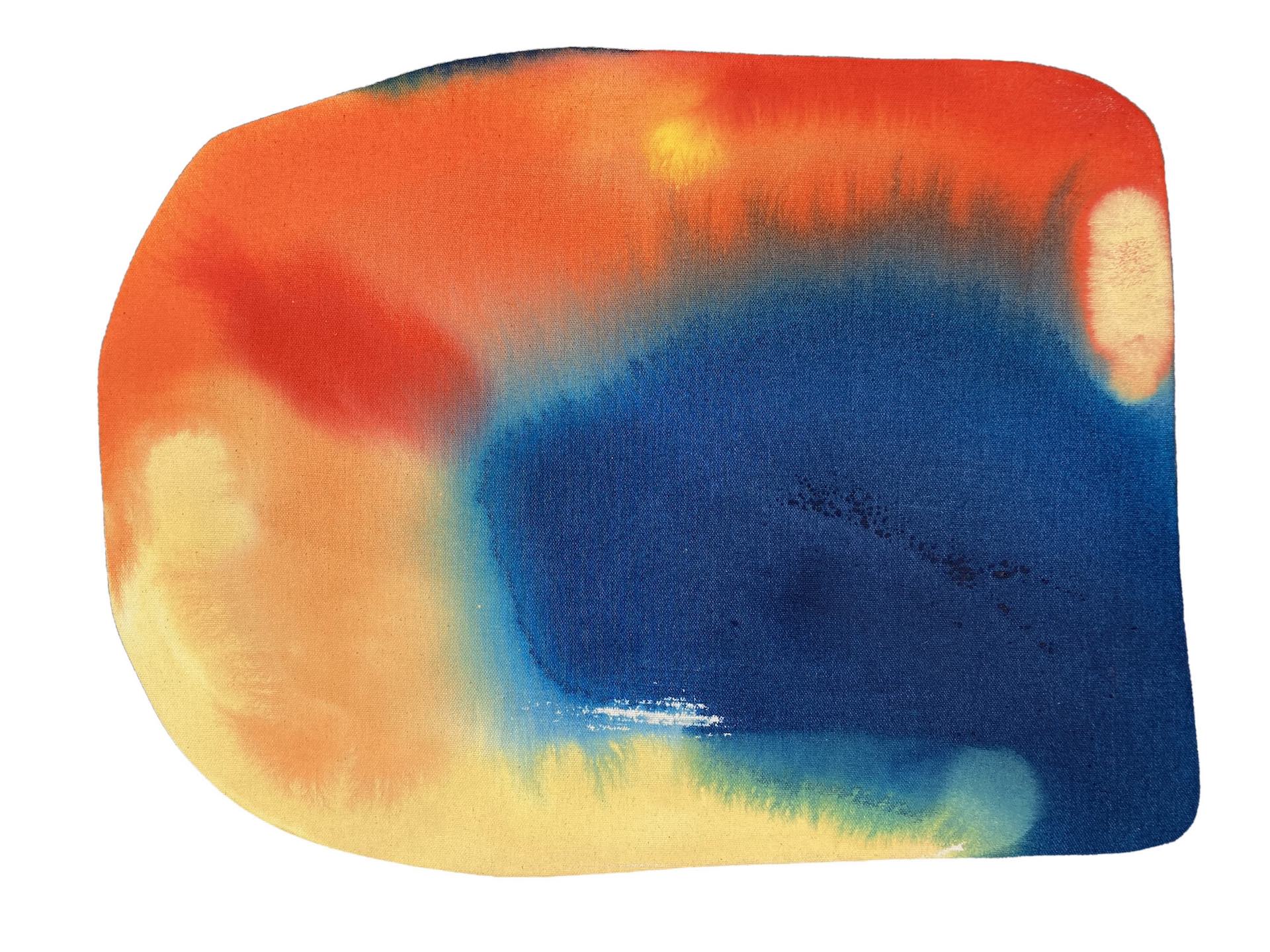
Katie Voyt
Fire and Water
Inspired by: Harvey Sadow, Fire and Flood/Sacred Sites
acrylic on canvas
19″ x 15″
2023
Fire and water are powerful natural phenomena. It is impossible to underestimate their impact on human life. It is huge – in fact there is no life without fire and water. They are mutually destructive – fire will boil the water away to nothing, just as water will extinguish the fire. Water and fire are fundamentally opposite: water is naturally wet and cold while fire is dry and hot. Water falls, fire rises. Nevertheless these opposites are united by their ability to decimate everything around. At the same time this destruction clears the way for nature to regenerate and renew.
@katievoytart

Mary Pat Wager
Dispenser
Inspired by: Laura McPhee, The Blue Lagoon
deconstructed propane tank, stanchion pipes, stainless steel, aluminum wire, silicon ore, mild steel
76″ x 16″ x 12″
2022
Dispenser reminds us of a PEZ dispenser designed to make it fun and easy to deliver sweet candy. One of the original Pez dispensers was designed to resemble a lighter, fueling the addictive behavior of smoking and in this case, eating sweet candy. Here the sculpture, Dispenser is dispensing Silicon – a naturally occurring raw element from the earth. Once smelted it is formed into a beautiful ingot and used as a release agent for the many products we consume in today’s world, making our lives easier. Products such as hair shampoos, conditioners, frozen juices, and toothpaste. Although beautiful in its appearance, it is the bi-product of draining the earth of its natural resources and shows the symbiotic and complex relationship between the environment, technology, and humans in today’s world.
@mpatwager
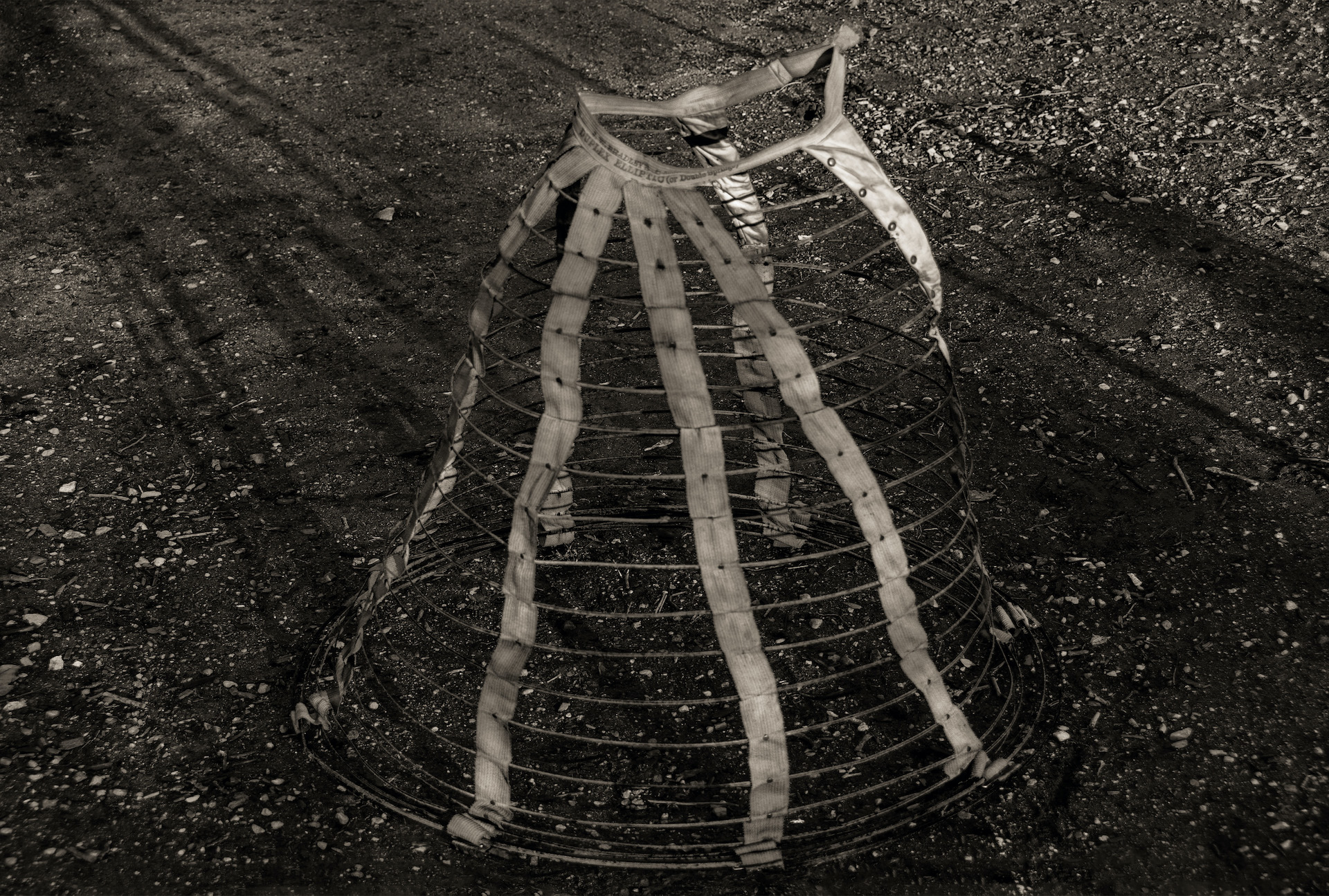
Martha Wakefield
Bare Bones
Inspired by: Robert Adams, Bulldozed Slash Evelyn Rydz, Gulf Pile John Willis, Recycled Realities 1
archival pigment print
18″ x 24″
2022
The crinoline, once utilitarian, evolved into a fashionable item of the mid 19th century. It allowed women to wear numerous petticoats. This innocuous undergarment is emblematic of the rampant waste in today’s fashion industry. The catastrophic impact of the making and disposal of clothing and its social consequences are finally being addressed worldwide. The European Union’s goal is for all textiles to be reparable, recyclable, and fiber free of hazardous ingredients by 2030, while Massachusetts recently banned all textile disposal. These works of Evelyn Rydz, John Willis and Robert Adams address our serpentine co-existence with the natural world. They confront us to take responsibility for our frivolous consumption. My work explores the contradictory nature between a garment and its environmental entanglement. Do we want to leave the land barren with only a remnant of our presence?
Instagram.com/m_m_wakefield, Instagram.com/mmwakefield
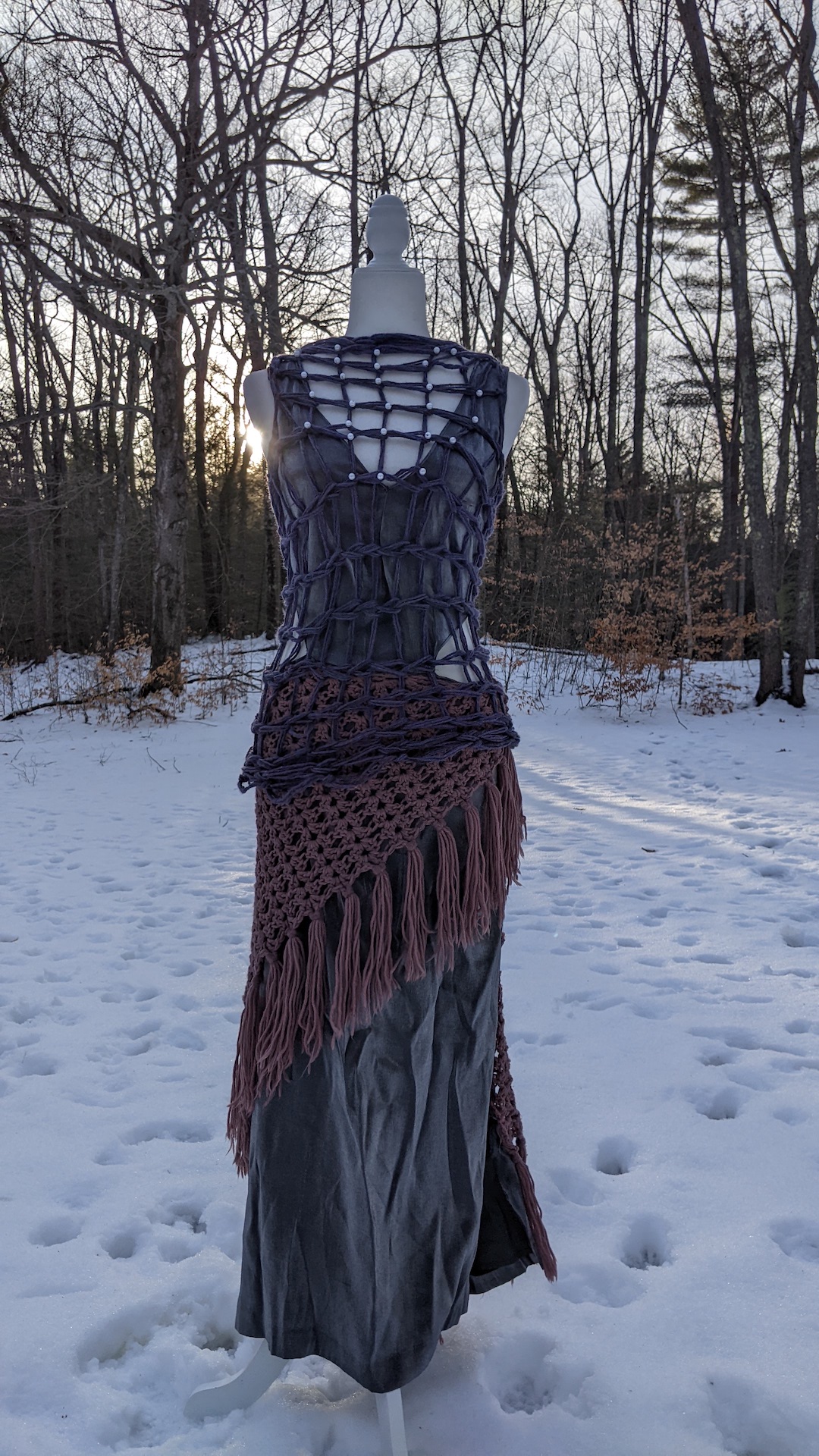
Tatiana Watkins
Actaea Washed Away
Inspired by: John Willis, Recycled Realities 1 Evelyn Rydz, Gulf Pile
upcycled garments
2023
The “Actaea washed away dress”, is a dress crafted as though the sea shore nymph herself would wear it dwelling on many coasts during our current oceanic climate. The dress is created from locally upcycled materials highlighting the potential for beauty in repurposed waste and the importance of a circular economy. The metallic upcycled dress appears to be as though it were washed ashore. Altered yet distressed, the gown is covered in woven netting with the neckline embellished in hand sewn pearls; wrapped in a formerly flamingo pink crochet skirt that’s been hand dyed giving it a faded sunken-by-the-sea finish. The dress serves as a reminder of the negative impact human society has on our oceans and seashores, where plastic pollution and marine debris are prevalent issues.
@tatiana_watkins (instagram)
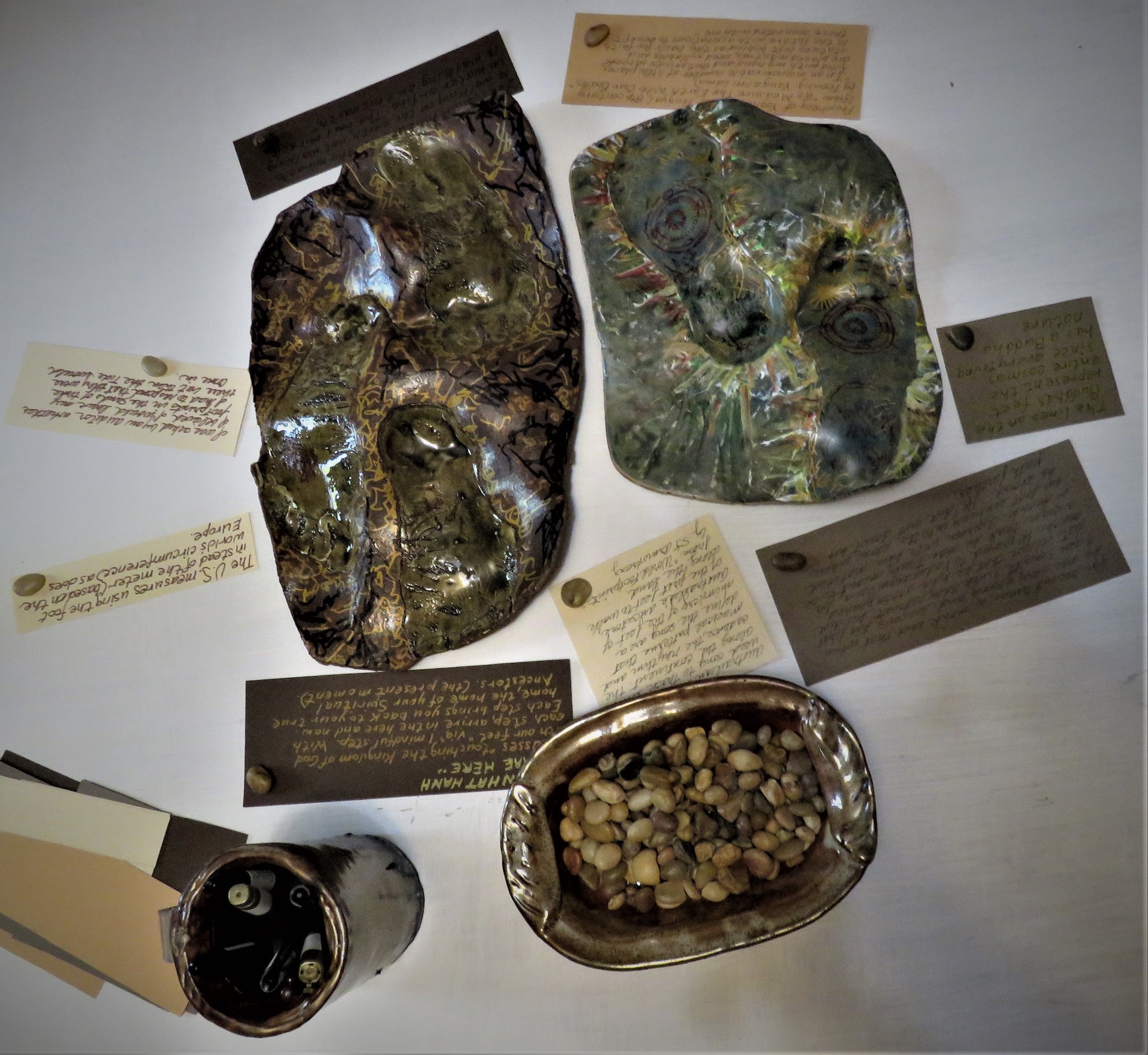
Jill Watts
Leaving Our Footprint On The Earth
Inspired by: Harvey Sadow, Fire and Flood/Sacred Sites Unknown artist, Yellow Amber Beads
cone 10 pottery, glazes, paint, permanent marker, earth tone pastel paper, natural decorative aggregate stones, board
36″ x 36″ x 6″
2022-2023
We have impacted the earth with our presence at least for 11,500 years (as per NOVA Ice Age footprints found in White Sands National Park) and continue to do so. Both pieces I used for inspiration are, to me, about multiple meanings. The bowl relates to earth, water, and fire elements as does the centerpiece of my work (also made of ceramics). The amber beads are used for healing, to ward off negative influences, and for decoration at least in Morocco. There are also multiple interpretations of footprints on the earth, some practical, some magical. I share some of what I discovered to encourage others to do the same. This piece is meant to be interactive.
jillwattsart.wordpress.com/

Luca Webb
Sun-kissed Worship
Inspired by: Unknown artist, Yellow Amber Beads
hand cut collage on wooden panel with copper tacks
10” x 10”
2023
Amber, the golden gemstone of the primordial forest, holds the secrets of a bygone era. Embedded within its luminous matrix lies the fossils of tiny insects, leaves, and tree resin, frozen in time, a testament to the resilience of life. This enigmatic stone has been coveted by cultures far and wide, its warm hues lending a touch of mystery to the wearer. Tales of its restorative and protective properties have been passed down through the ages, whispered in hushed tones, of its ability to ward off negativity, attract positive energy and promote overall well-being. Amber, the forgotten treasure of the ancients, awaits those who seek its obscure splendor, a mystical window into a vanished world.
spacepunk.studio

David Wesley White
Burn, Dig, Filter, Fly
Inspired by: Robert Adams, Bulldozed Slash Harvey Sadow, Fire and Flood/Sacred Sites
video
7:00
2023
Though harmonious visions of utopia exist in our imaginations, religious texts, and political aspirations; humans stand in stark contrast to the environment that surrounds us. Our hands are often working away, finding ways to change our material conditions—for better or worse. The truth is, we can not survive without our ability to master the elements. However, the anthropocentric mindset of modern man has led to the disarray and death of so many life forms, and the overall balance of earth. Burn, Dig, Filter, Fly juxtaposes the sheer magic of our environment with humanity’s incessant need to intervene. Satisfying visuals are compounded with toxicity—a pristine pool filled with lethal chemicals; a roaring fire consuming manufactured waste. The duality of the piece speaks to Robert Adams’ Bulldozed Slash, Tillamook County, Oregon, and Harvey Sadow’s Fire and Flood/Sacred Sites. Opposing forces—two hands can do more than just pray.
davidweswhite
Kevin Williams
Essential Food Worker
Inspired by: Winslow Homer, Gathering Berries Harvey Sadow, Fire and Flood/Sacred Sites Esther Solondz, Untitled (Rust Portrait)
acrylic, spray paint, stencil, stick, staples on canvas
18″ x 24″
2021
A stencil of a surgical mask lies over a leek. The background is half-unknown and half-restricted showing the emotions of a chef in the middle of the pandemic. My restaurant had shut down and our business model had pivoted. While wondering if fine dining or food service would ever resurface in the world I worked alone in a kitchen. The kitchen that once had 23 employees was down to one confused chef. Food workers were called heroes now. What were we before? When George Floyd got murdered it felt like the world was on fire and Jose Andres was the only one trying to put it out. This painting shows my love of food and service twisted. BLM made me question serving others. Covid made me want to help in some way. I tried to paint that paradox.
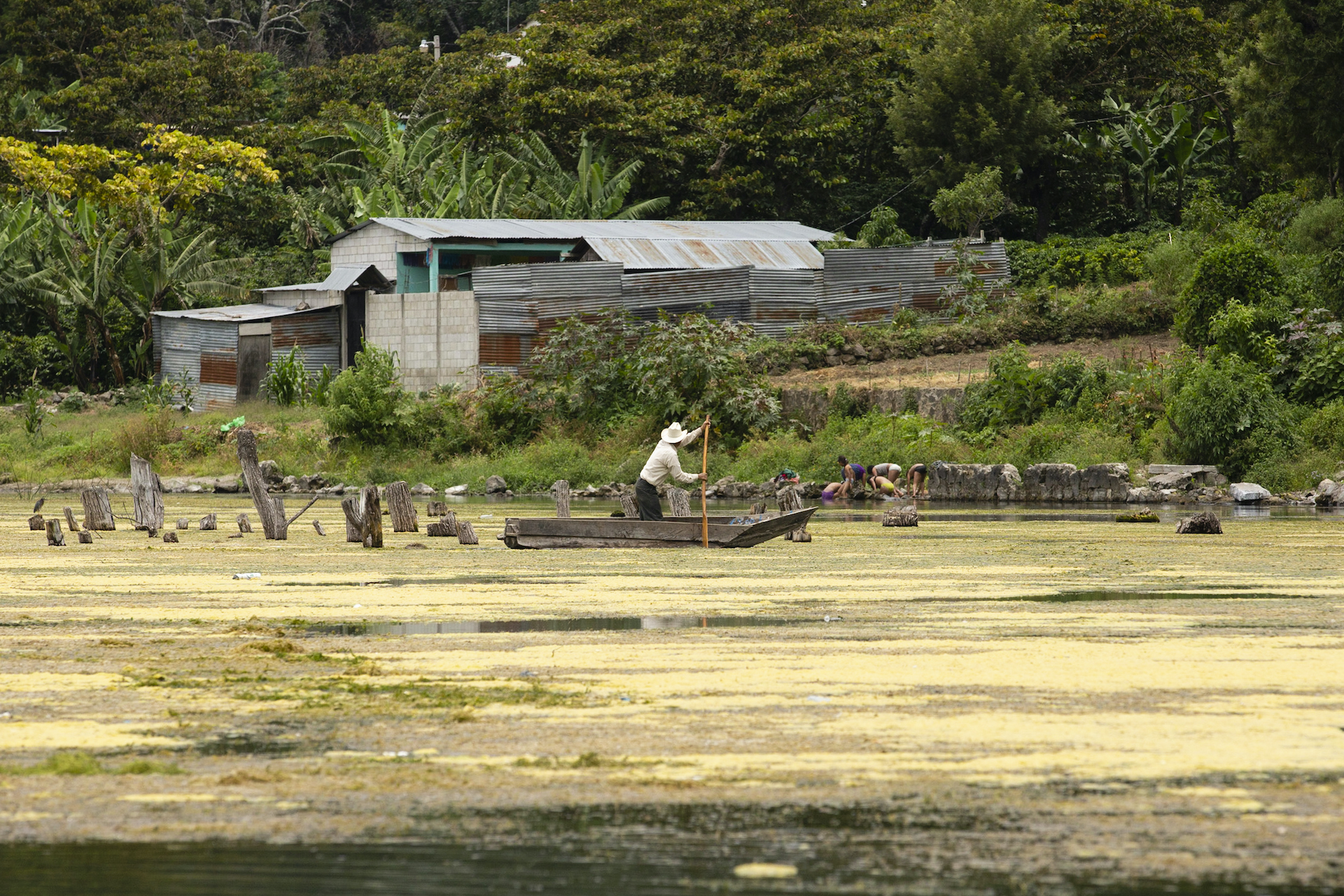
Matt Wright
Algae bloom on Lake Atitlán
Inspired by: Robert Adams, Bulldozed Slash
archival inkjet print
18″ x 24″
2015-2023
Lake Atitlán is considered one of the most beautiful lakes in the World. It is a major tourist destination for travelers, source of freshwater for residents and economic opportunity for many living in the region. This image captures a fisherman paddling through an algae bloom, while a nearby family bathes and washes their laundry along the shoreline. Algae blooms and toxic Cyanobacteria concentrations are very common occurrences in the last few decades but were experienced by the Mayans during the pre-Columbian era due to deforestation and soil erosion. Today contamination of Lake Atitlán continues as a result of the accumulation of nitrogen and phosphorus from fertilizers used in agriculture and E.coli from untreated sewage released directly into the lake. Residents, fisherman and boatmen working on and living around the lake experience skin diseases and more serious illnesses such as liver, kidney and neurological diseases.
@mattwrightphoto

Mark Zieff
Drained
Inspired by: Robert Adams, Bulldozed Slash Evelyn Rydz, Gulf Pile
charcoal on Canson paper
24″ x 18″
2023
“Drained” was inspired by the photograph Bulldozed Slash, Tillamook County, Oregon by Robert Adams and by the drawing Gulf Pile by Evelyn Rydz and explores the lasting impact of fast fashion on low wage workers and the environment. Fast fashion garments are stylish, low-quality, mass-produced clothes. They appeal to shoppers because they are trendy and inexpensive and can be easily discarded when no longer in fashion. There are though some very real workplace safety and environmental costs associated with fast fashion. According to the Ellen MacArthur Foundation, 10% of global greenhouse gas emissions are attributable to the clothing industry. Many of the dyes and chemicals used to color and set fabrics are highly toxic, both to workers and the surrounding natural environment. And, according to the EPA, over 17 million tons of textile waste are generated each year of which only 2.5 million tons were recycled.
@markzieffart
We thank our friends and partners at the Fitchburg Art Museum for sharing their collection so generously with our artists.
ArtsWorcester exhibitions are sustained in part by the generous support of the C. Jean and Myles McDonough Charitable Foundation.
Never miss an exhibition or event.
Get updates when you sign up for ArtsWorcester emails.

